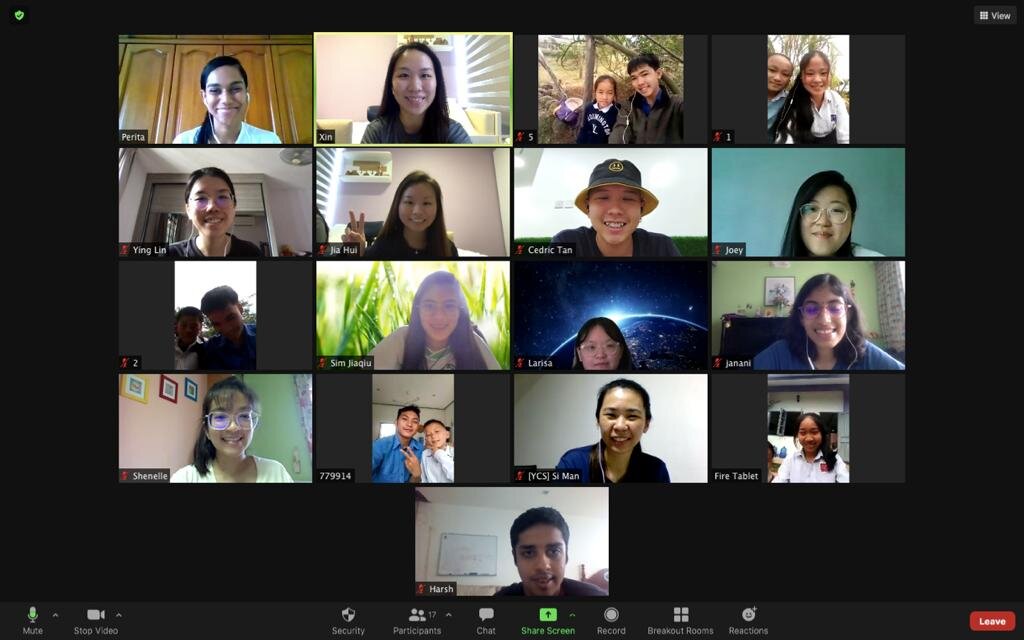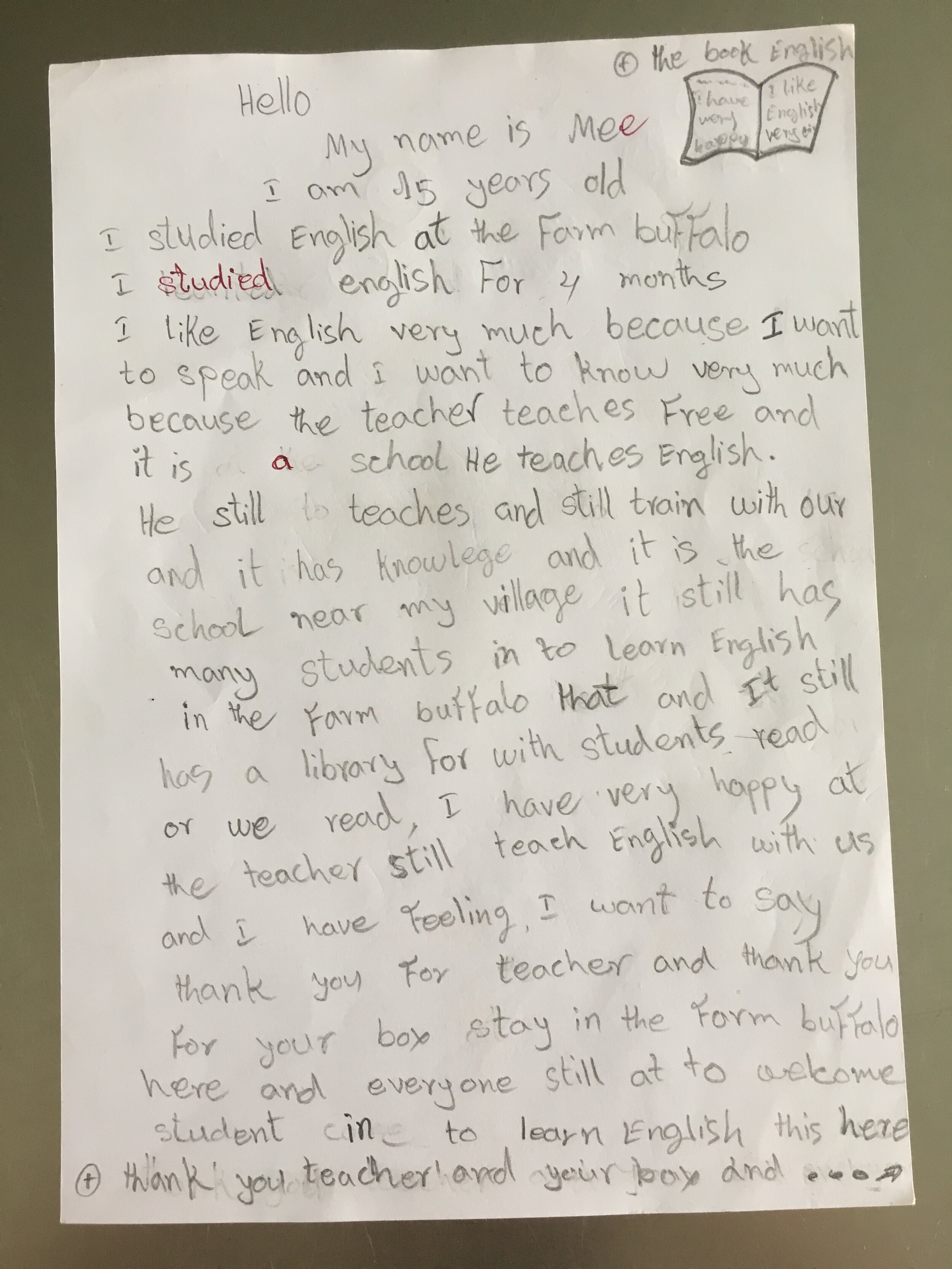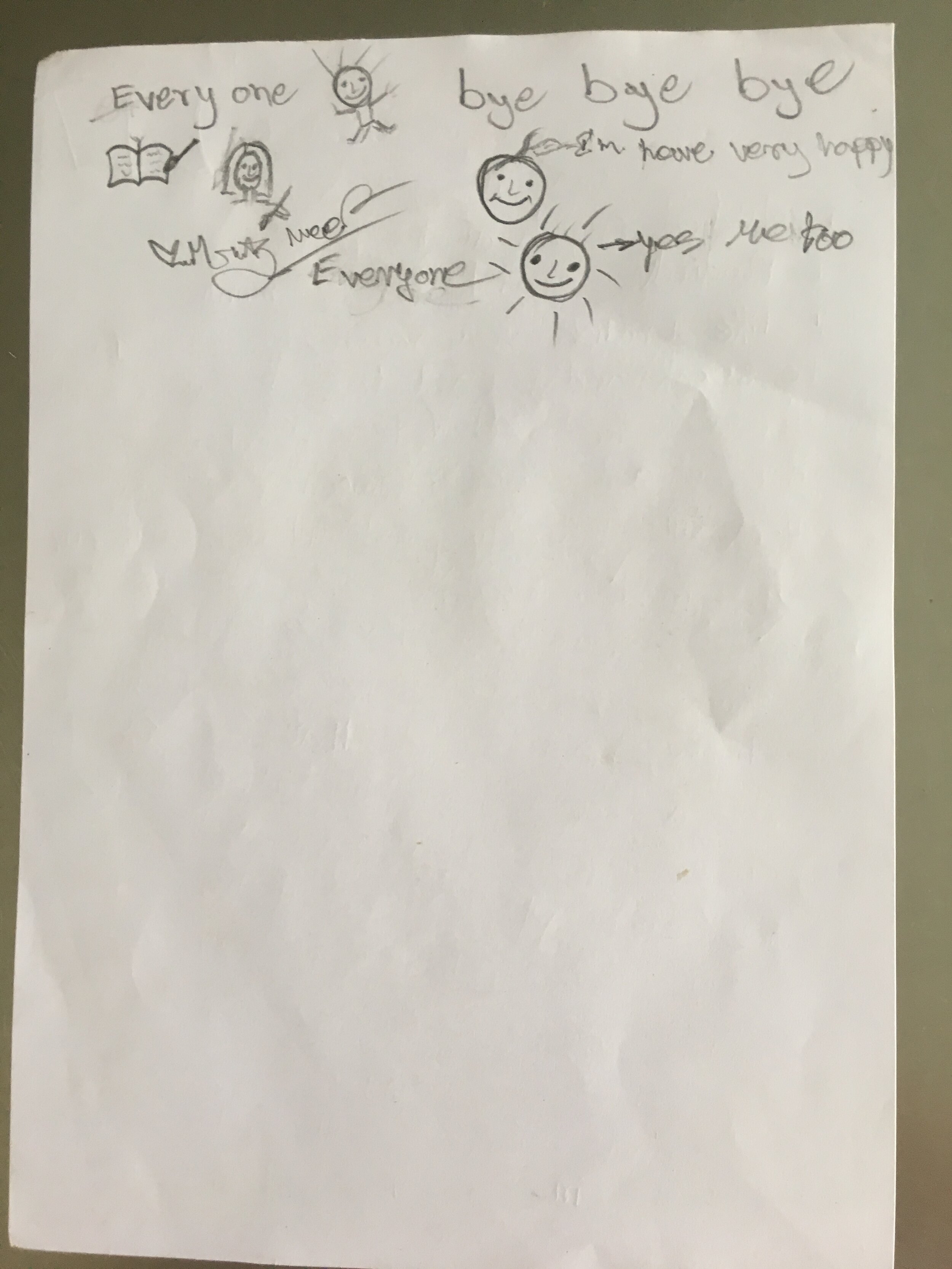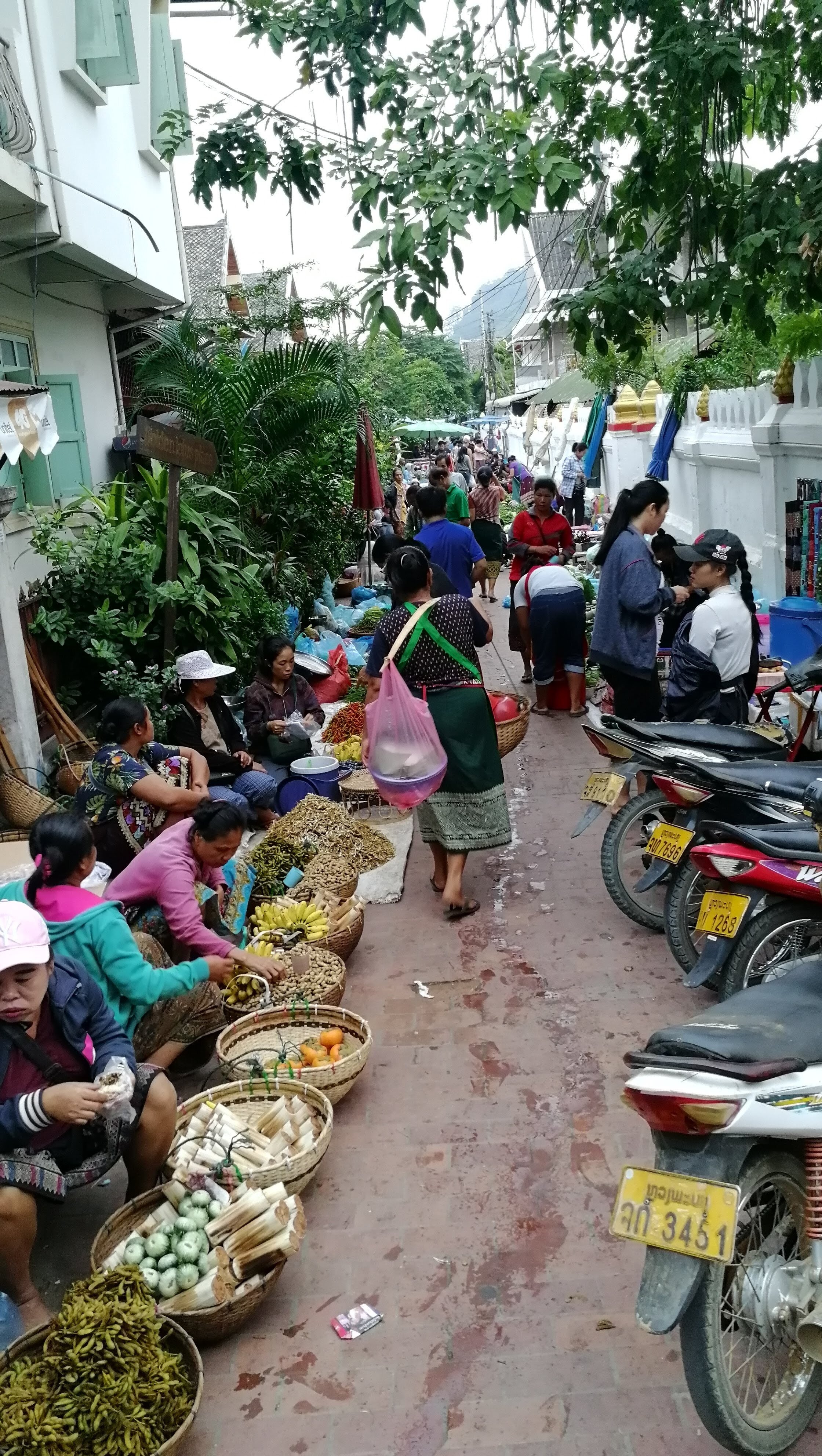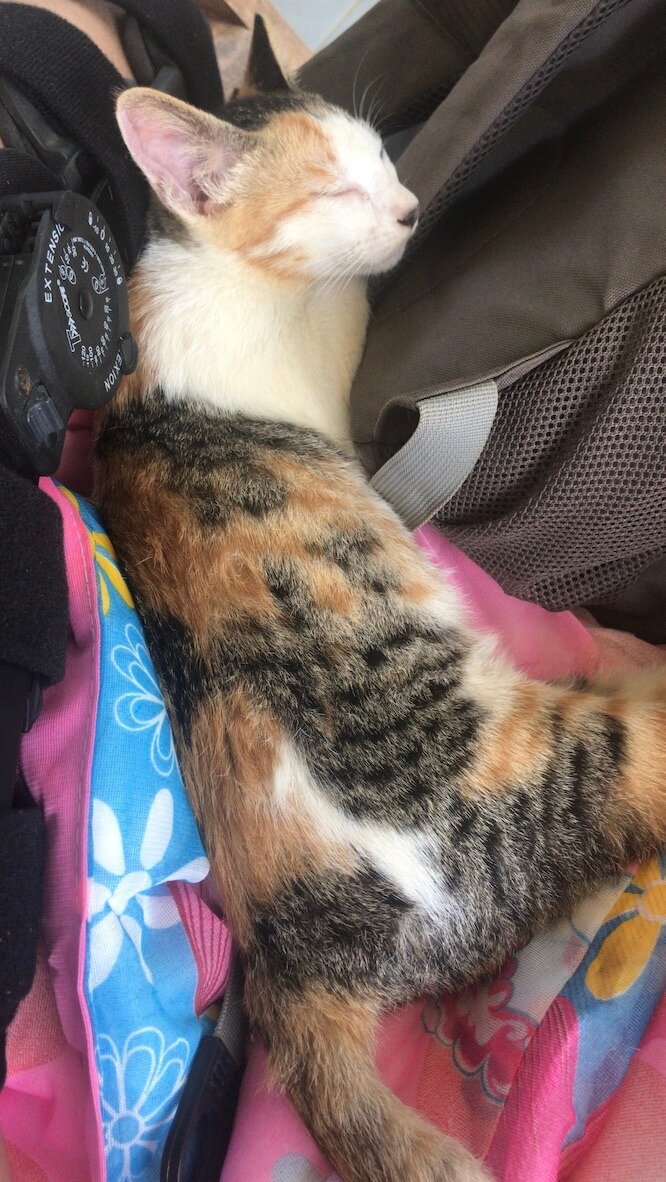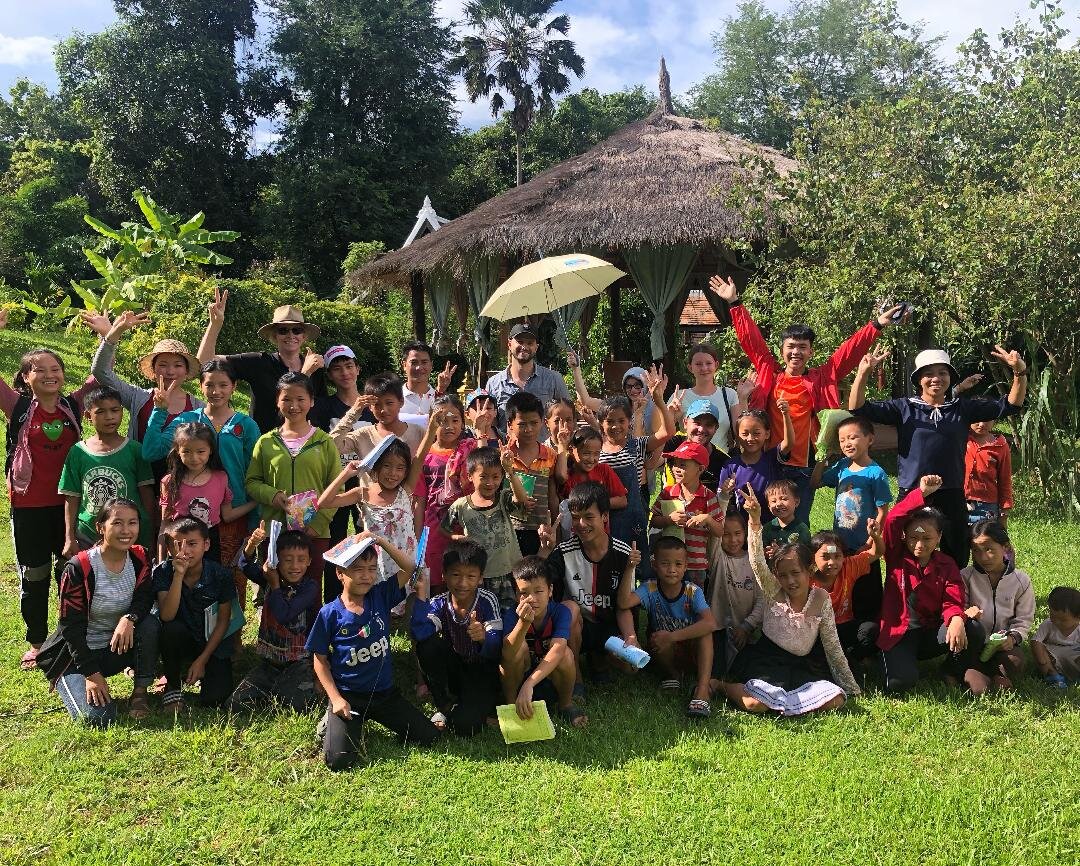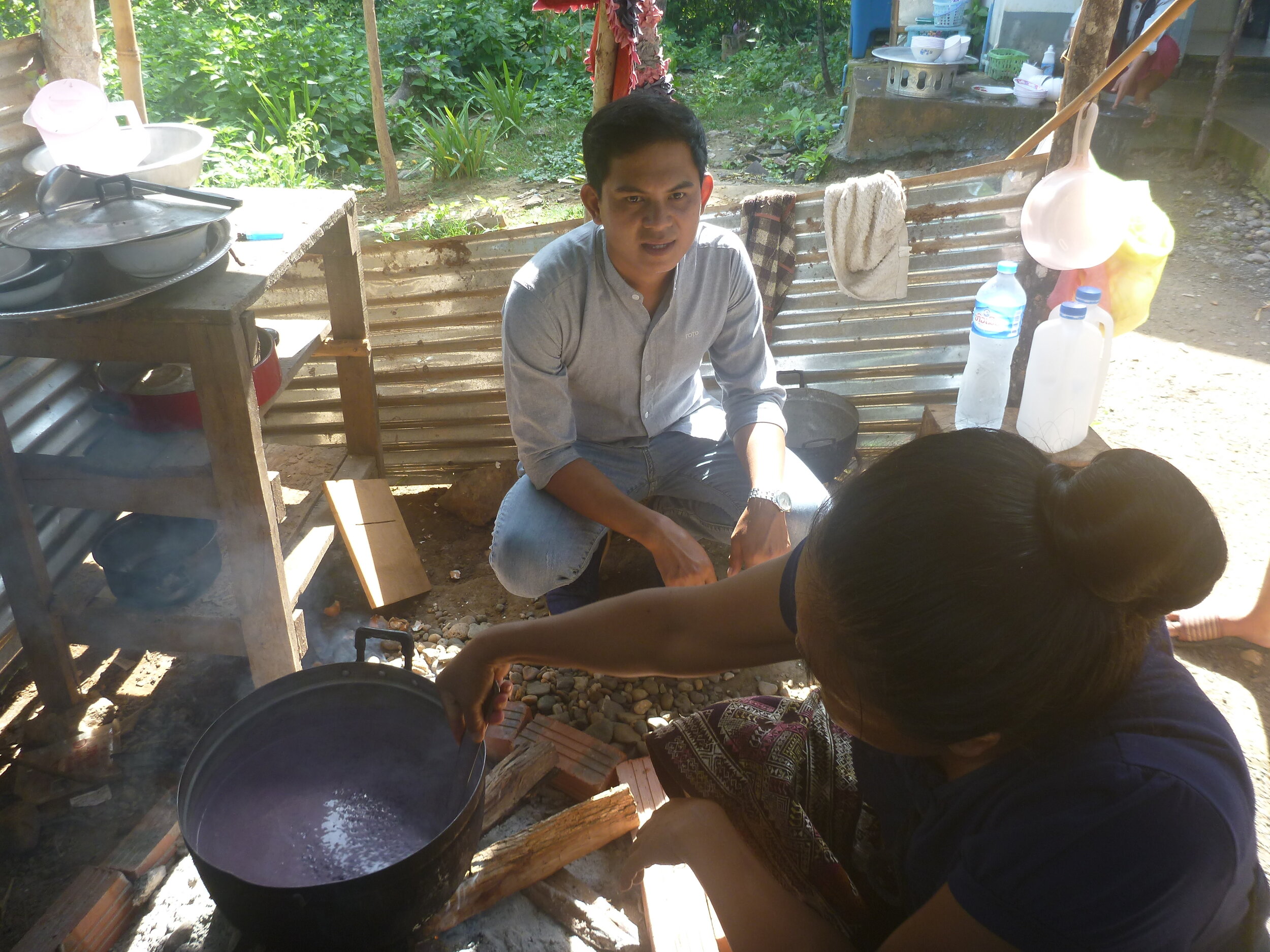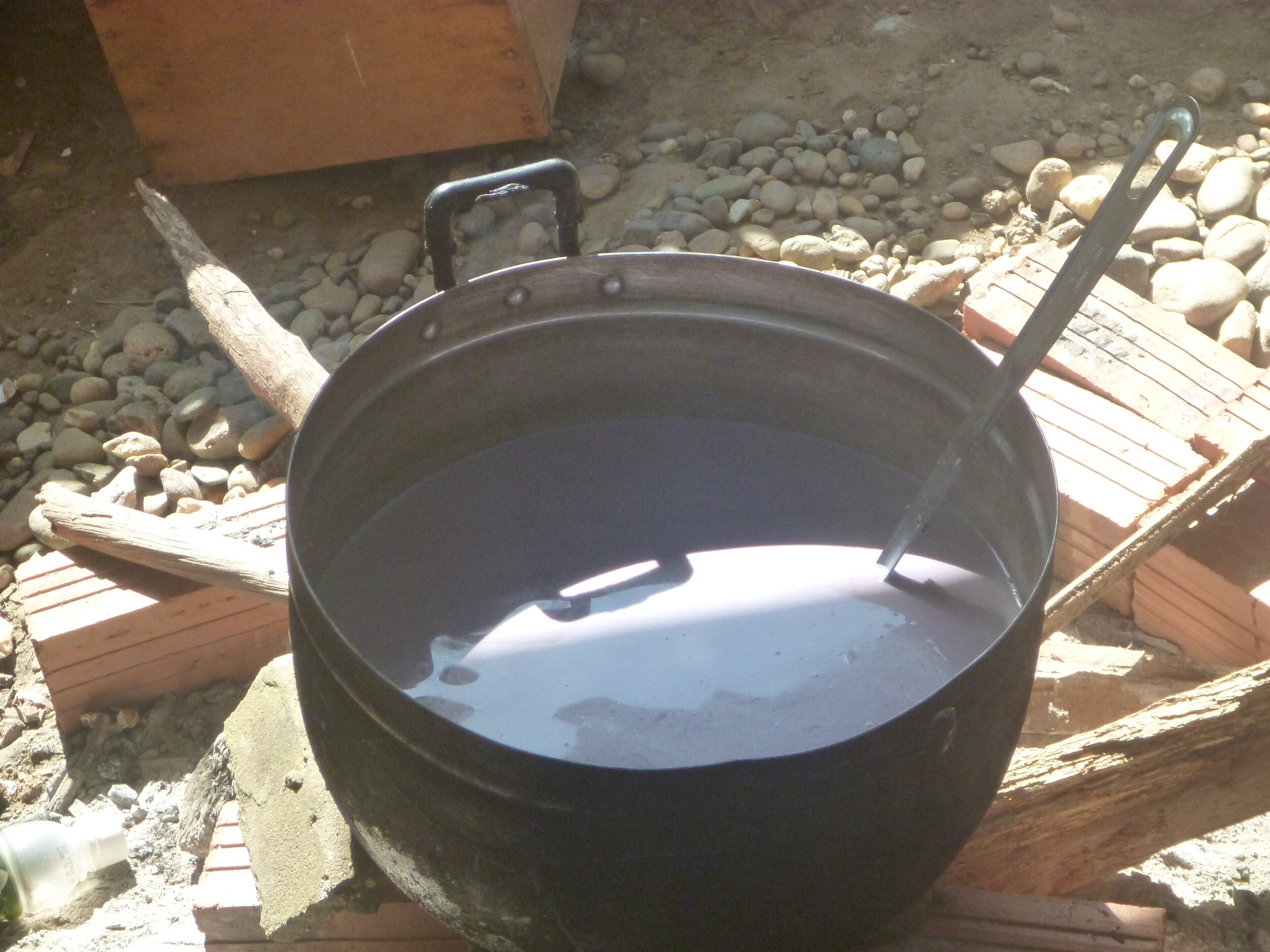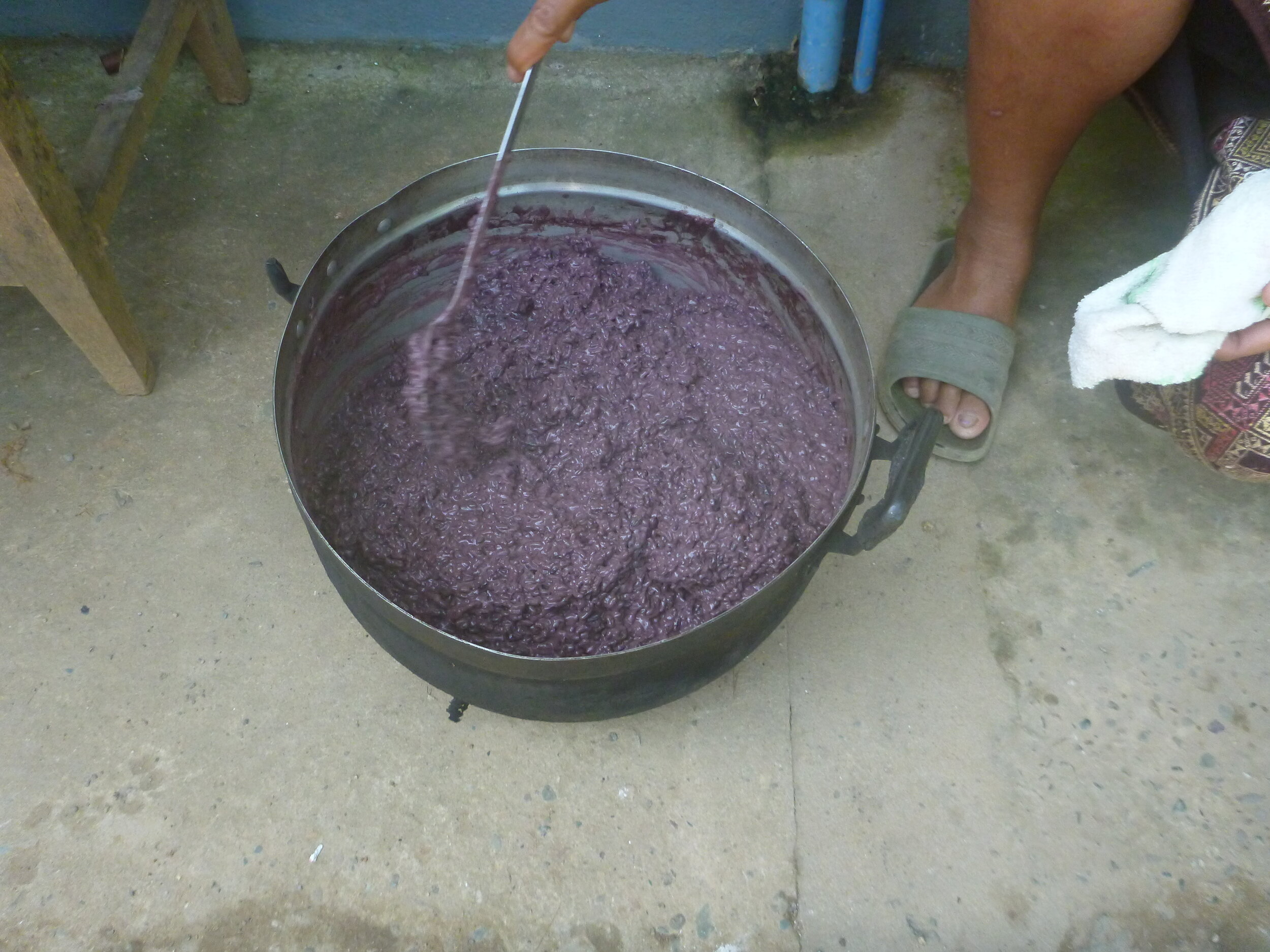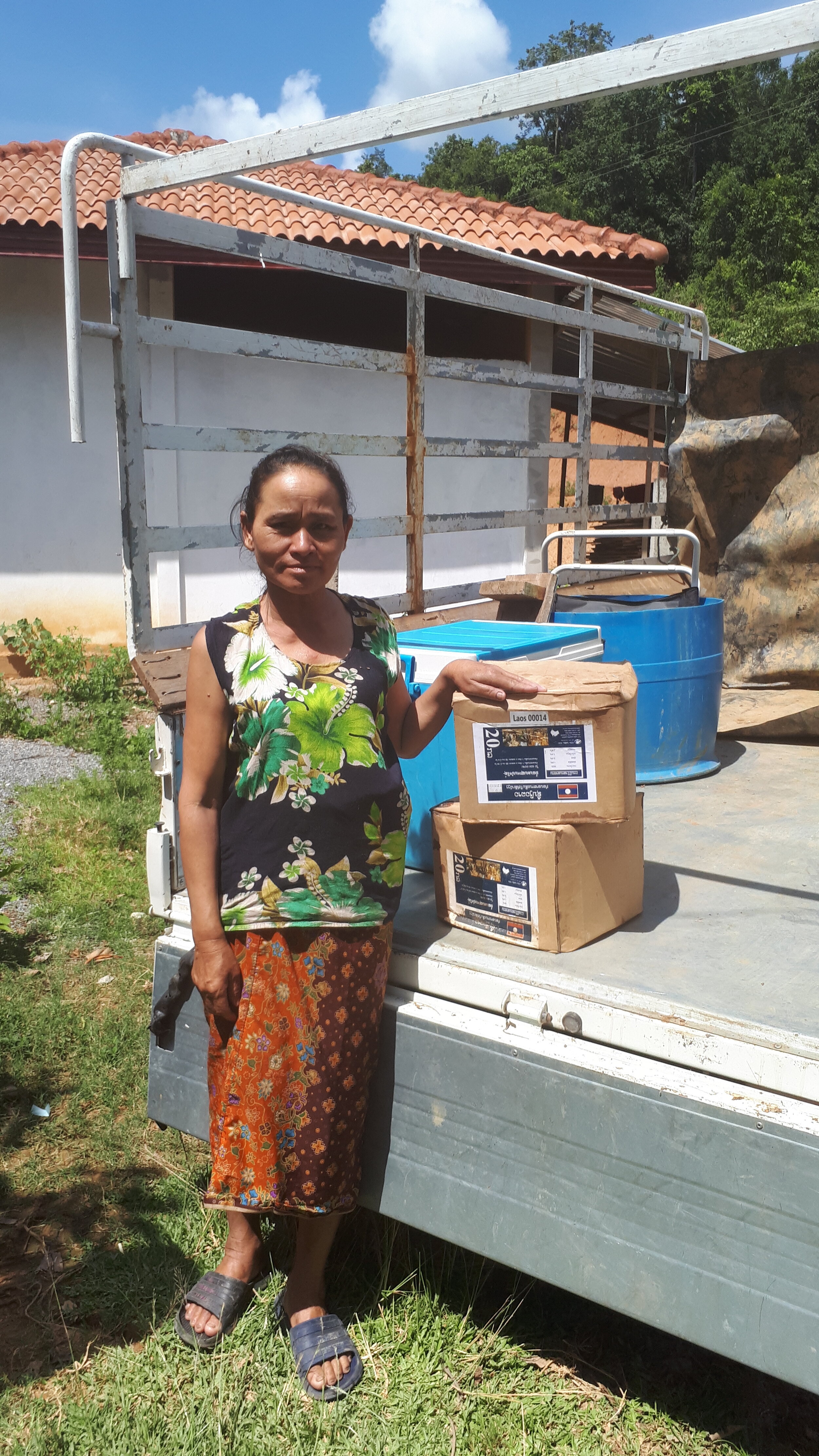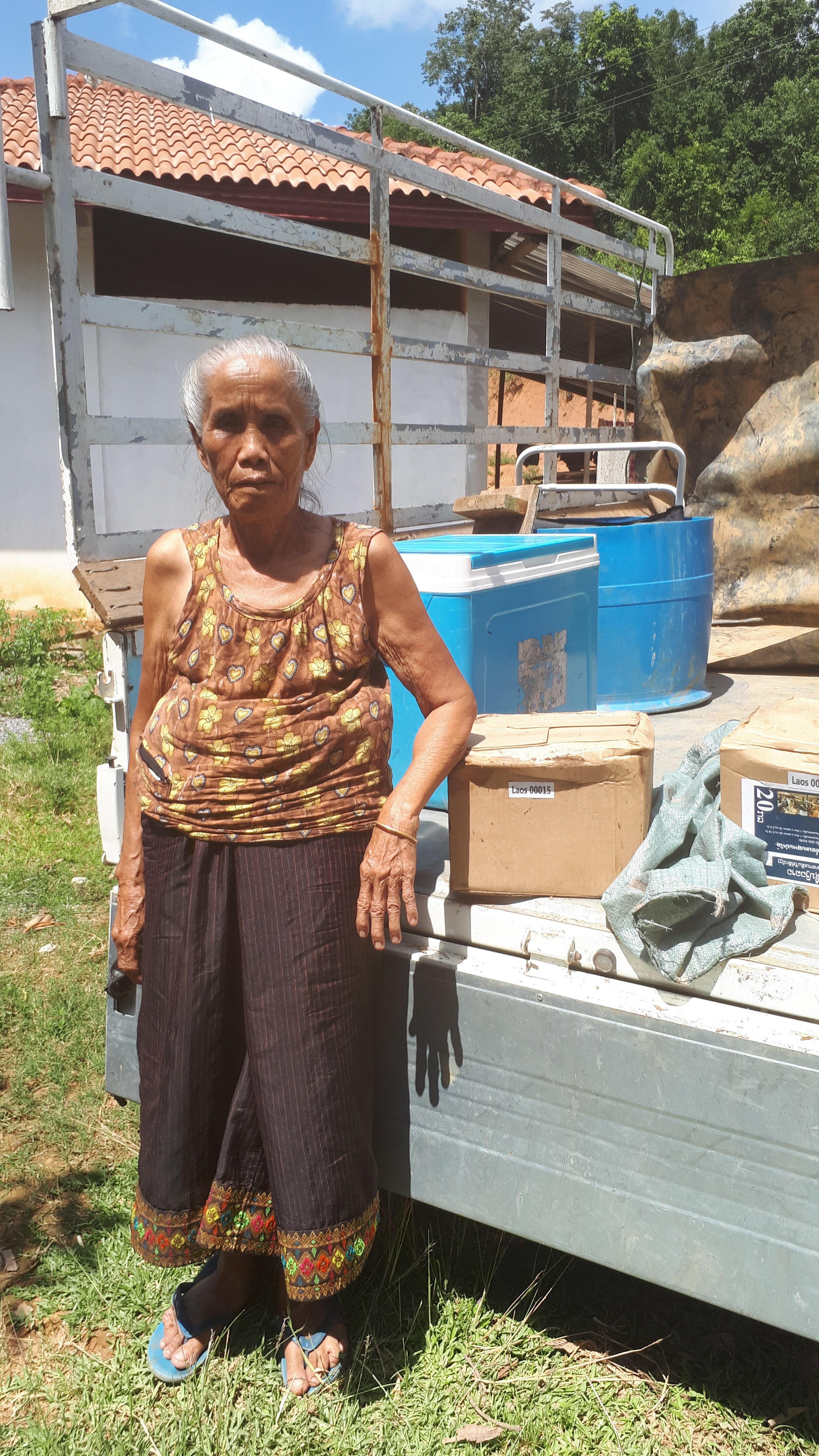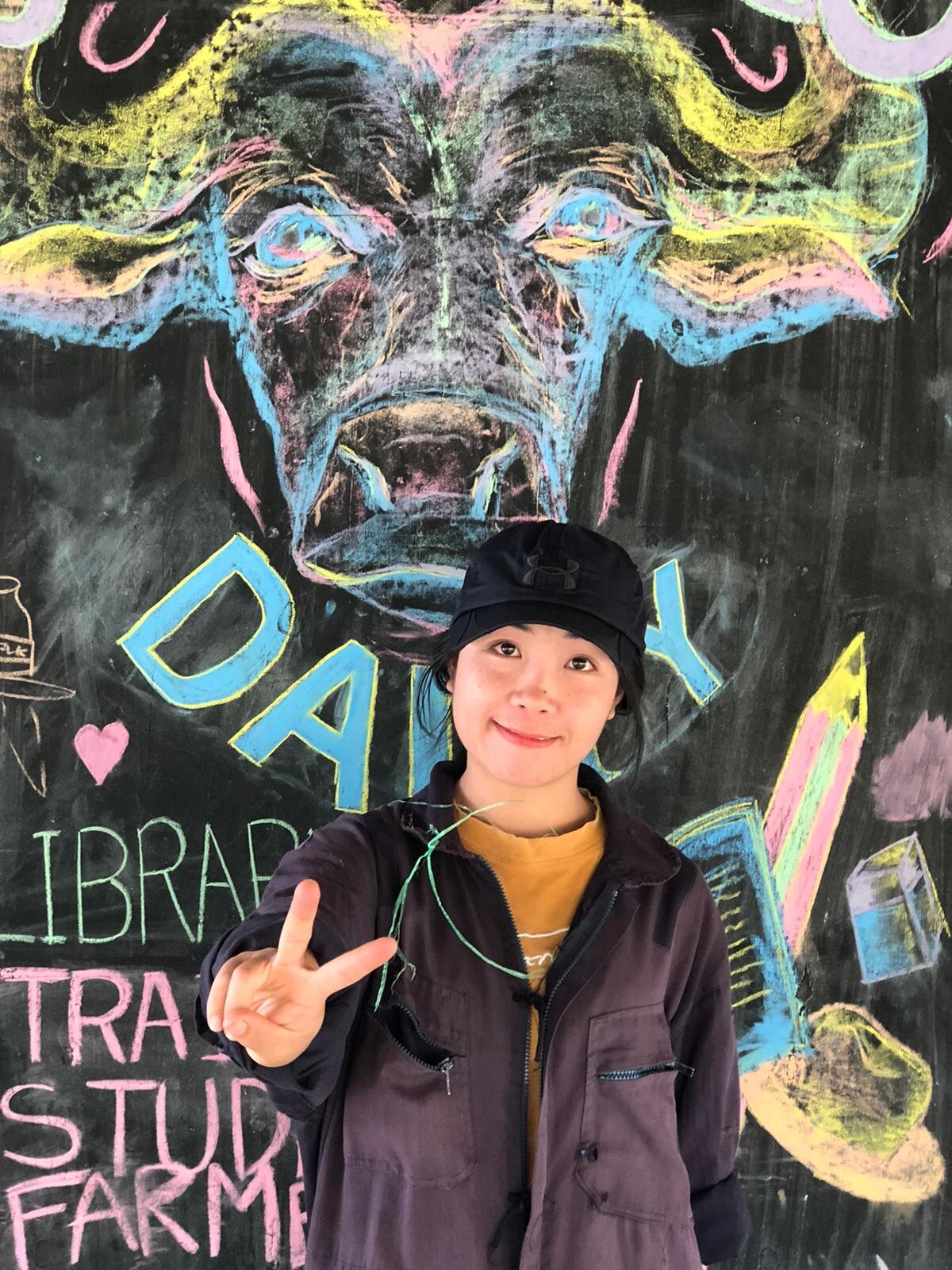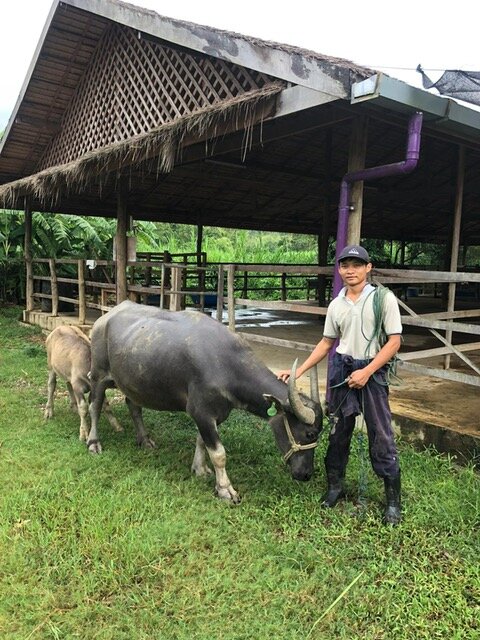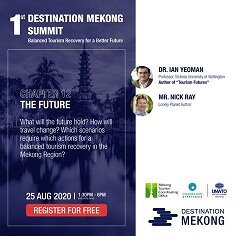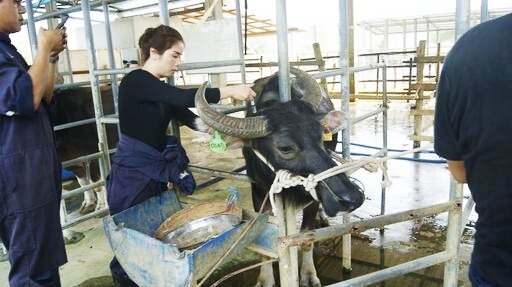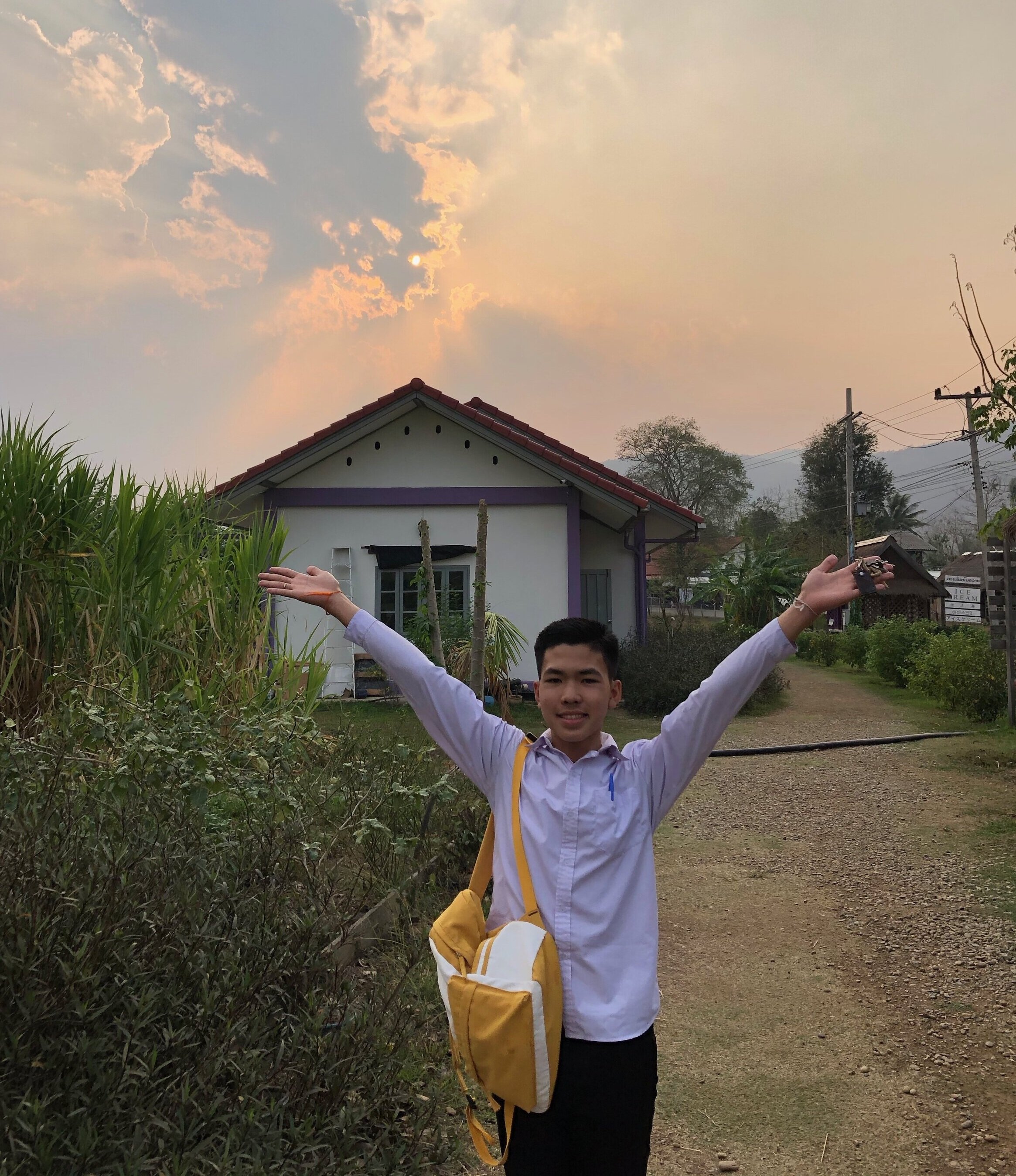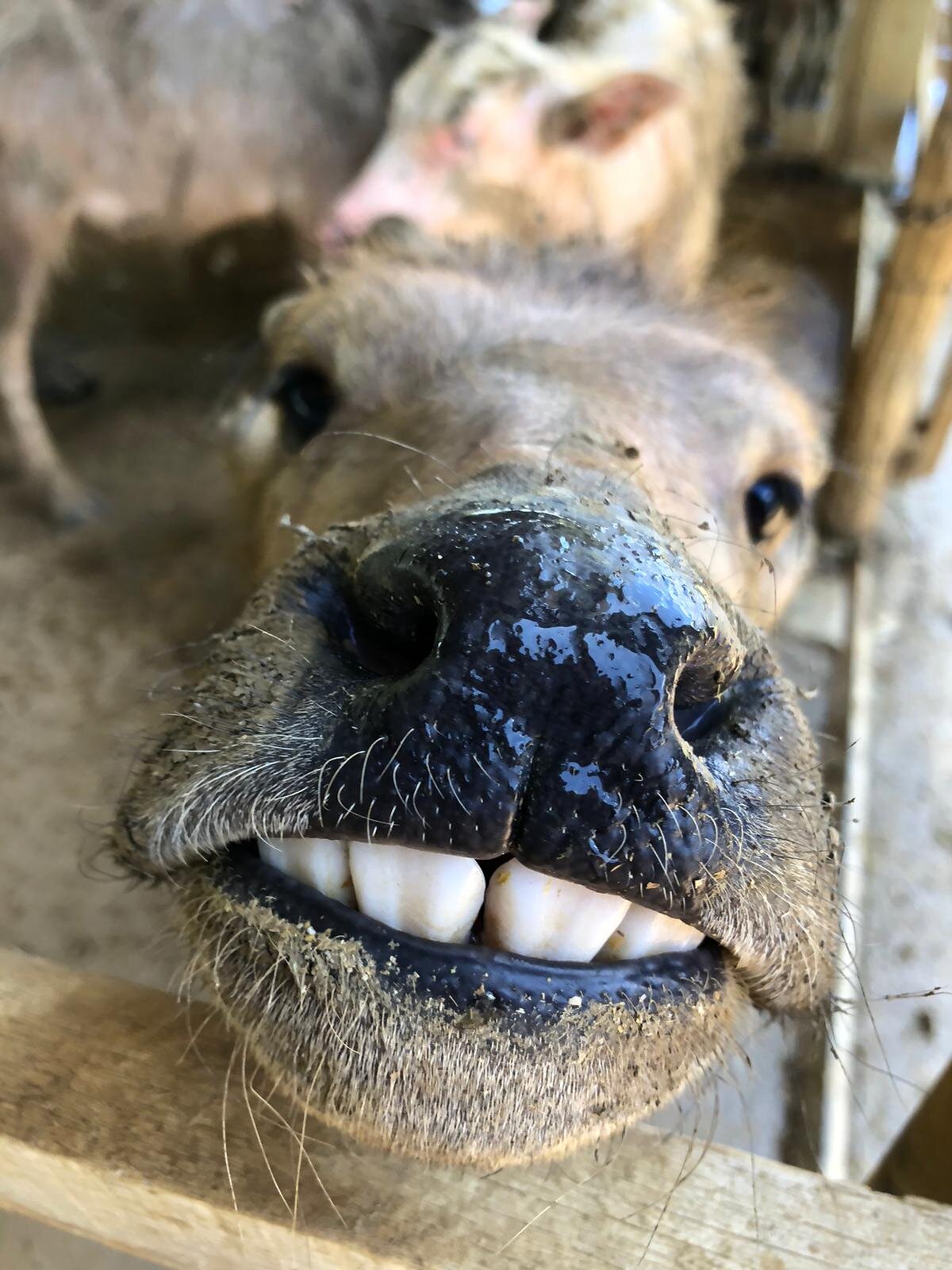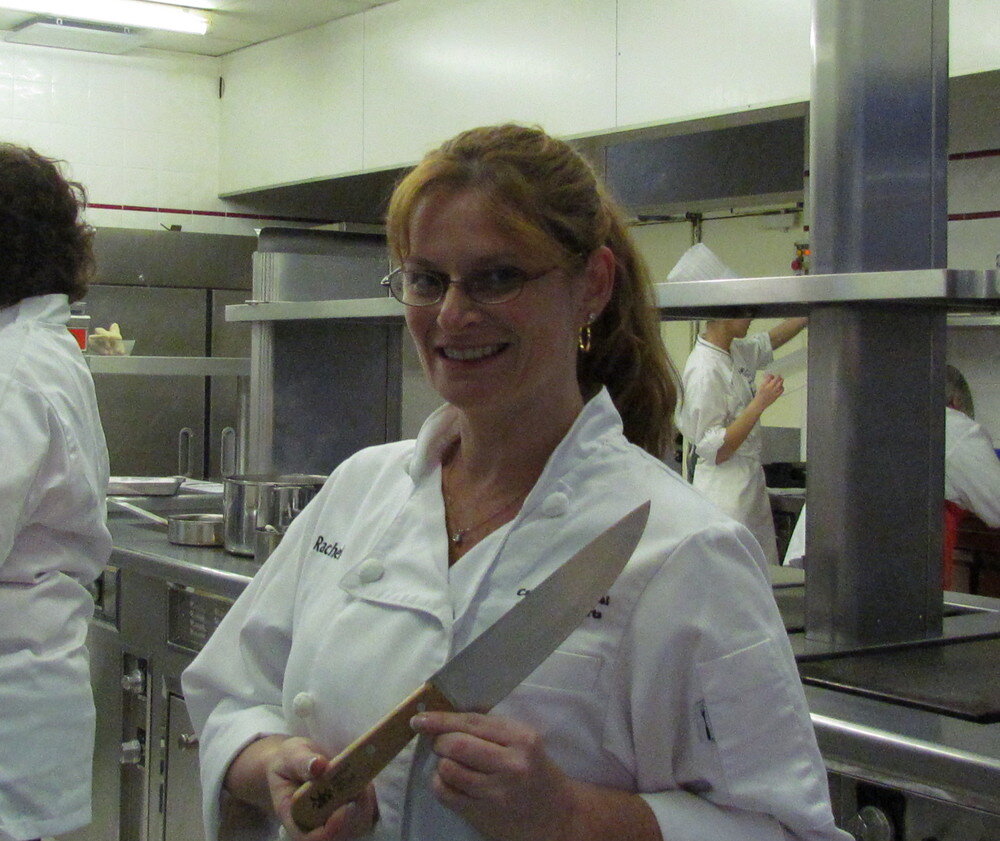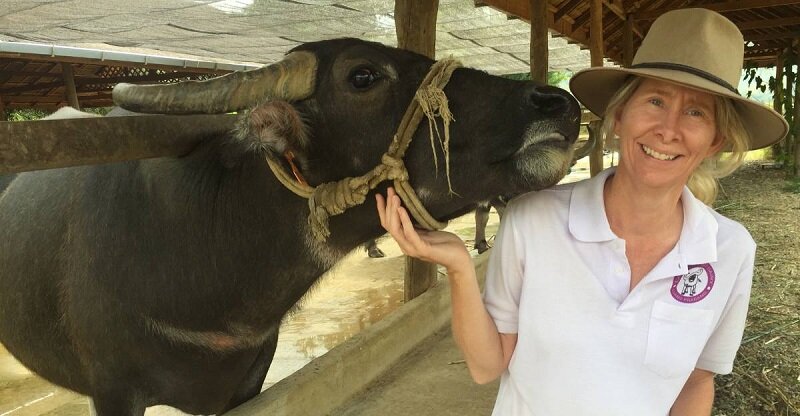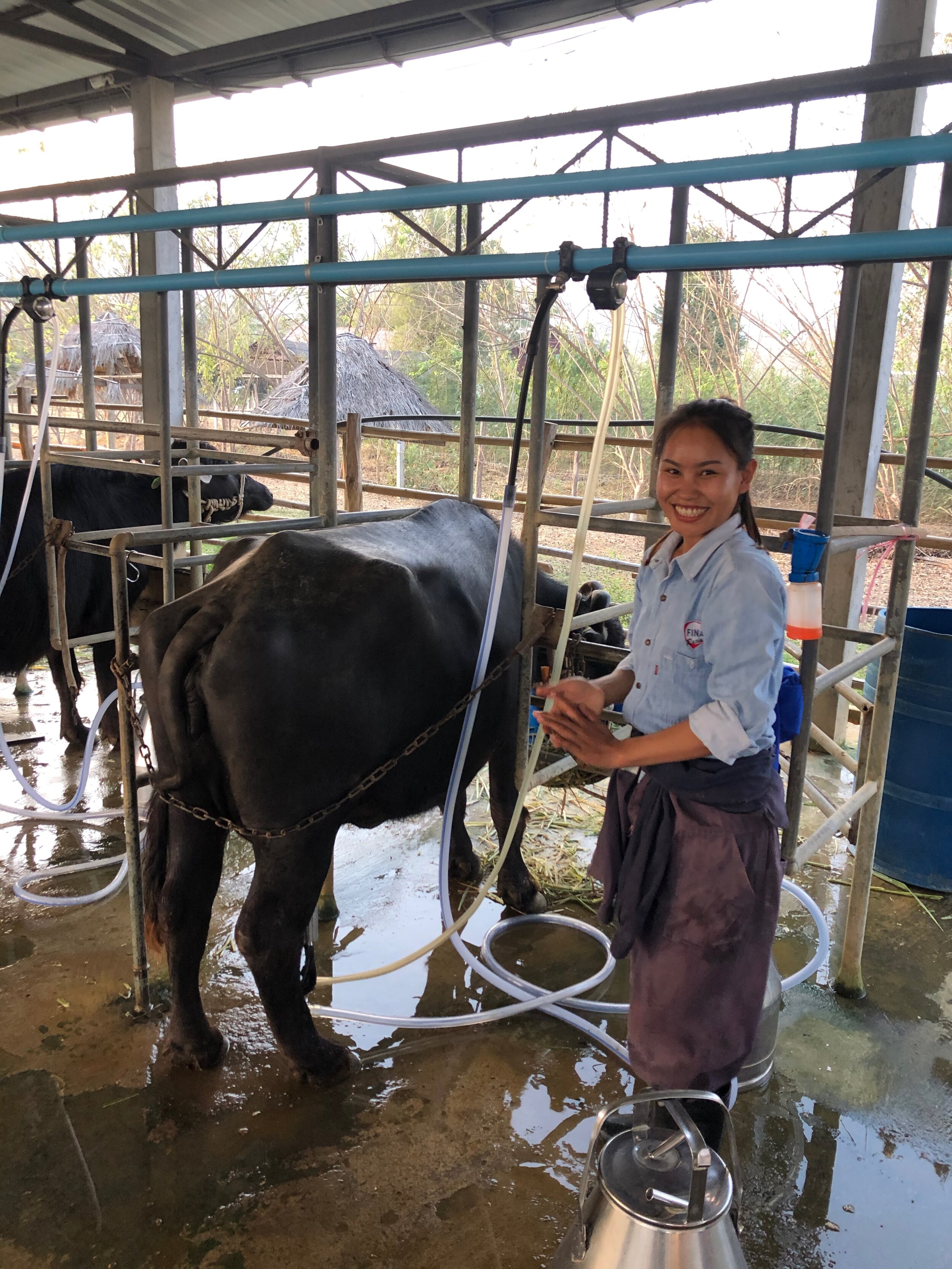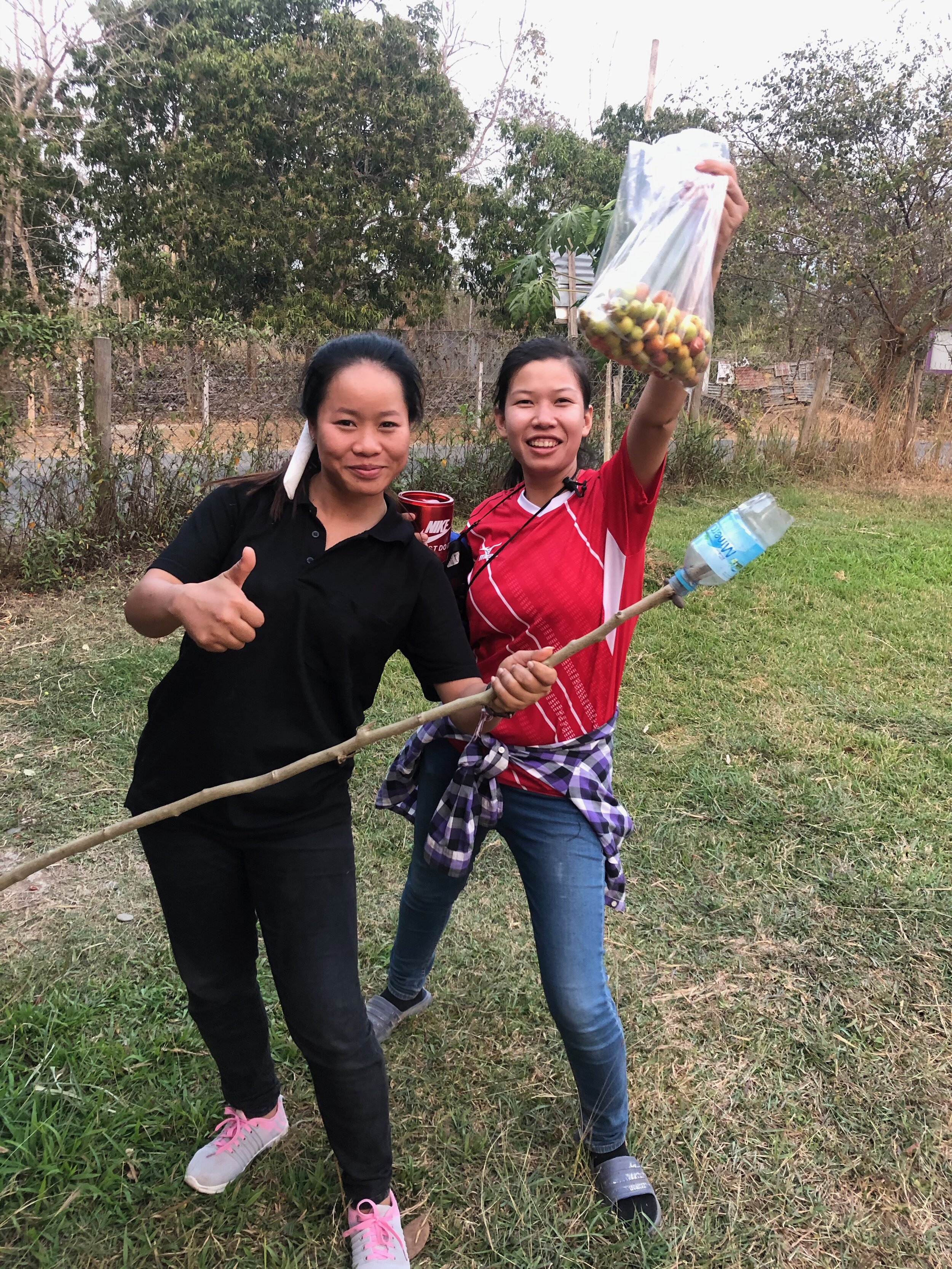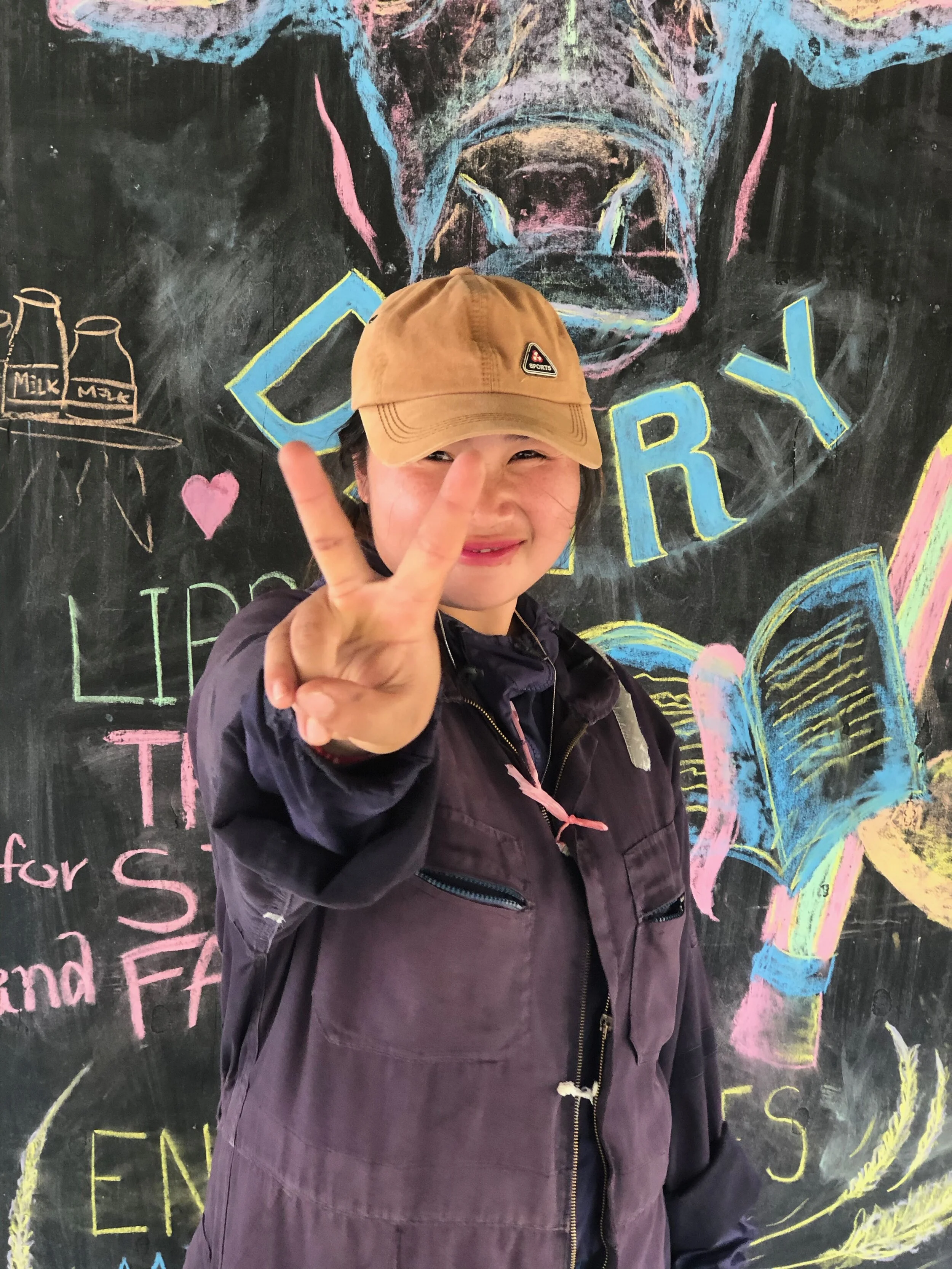
Blog
Singapore Volunteers Talk it Up!
Singapore volunteers help teach English at Laos Buffalo Dairy over Zoom during the pandemic.
For about 8 weeks in January - February, Laos Buffalo Dairy was the lucky recipient of some wonderful volunteers from Singapore that had been with us to help teach English online. That’s right! They helped teach English online to our team and to the local school children.
We had 7 team members, 5 youth teachers and 10 school children join the classes.
Caught on camera! The teachers and our local school kids during English lessons.
For about 8 weeks in January - February, Laos Buffalo Dairy was the lucky recipient of some wonderful volunteers from Singapore that had been with us to help teach English online. That’s right! They helped teach English online to our team and to the local school children.
We had 7 team members, 5 youth teachers and 10 school children join the classes.
How? Might you ask, was this possible? Well, previously we had some representatives from Youth Corps Singapore visit us at the farm. They had heard about us and wanted to talk about getting some of the Singapore youth here on a trip community service. This was all before COVID hit. We thought our chances had disappeared. But in September 2020, we received an email from Steven Lau, Assistant Director to Youth Corps Singaporeabout an opportunity. They wanted to talk to us about the possibility of going online. The Youth Corps provides short-term volunteering for youths who would like to enhance their skills and do some community service as well.
As luck would have it, back in early 2019, 10 Amazon tablets were donated to the farm for our English classes by Paul Kenton from Canada. (Paul runs a project here in Laos called Laos Village Project.) These tablets are loaded with English books and programs like Math, science programs as well. And these tablets had WIFI capability! So, through many conversations on how to make this work, we realized that we could indeed make English classes from Singapore work via online teaching.
The farm team members and the school children were broken up into small groups in order to work with each of the tablets and teachers from Singapore to get the most out of the classes. Lesson plans were drawn up from our side on what the team and children were currently learning and sent to Singapore for the volunteers to expand on. Weekly topics were also sent to help coincide with what they were learning here and allow the volunteers to come up with an in-depth plan for the week.
Classes commenced twice a week with the volunteers and twice a week with just our normal classes.
As the first few weeks passed, the Singapore volunteers decided they wanted to learn some Lao and have the farm team and children teach them. They sent us a list of easy phrases that they wished to learn and we passed that on to our students. The Volunteers reported back to us that the kids and team members were extremely enthusiastic about trying to help them learn the Lao phrases and were excited that Singapore was taking an interest!
Below is some of the feedback from both the Singaporean teachers and some of the kids.
Volunteer Joey Feedback - Joey:
I really enjoyed my time volunteering to teach the students and staff. It was very fruitful to see that at the end of every lesson we have with them, they come out of it more knowledgeable and are able to apply what they have learnt. I constantly looked forward to the sessions that we have together as they were extremely interested to learn and were not afraid to say that they do not understand, which I find very encouraging as they were keen to understand what they do not know. Moreover, even if they do not understand even after asking the volunteers, they will seek help from their friends or Link. This shows that they were really inquisitive and enjoyed the learning process.
One takeaway, that I find really meaningful, was a couple of sessions where the student teachers taught us some words and common sentences in Lao. The student teachers were really engaging and really supported our learning by constantly praising and smiling at our efforts to learn their language.
These students and staff are really resilient when it comes to learning within a limited time frame while also having to deal with internet connectivity issues. They persevere and continue to learn no matter the circumstance and I really admire them for that.
All in all, I hope to be able to be part of this project again should the opportunity arise! Meanwhile, continue to be curious and keep going forward on this path of learning. I hope we meet again!
Project Angkid volunteer feedback - Belinda:
I am glad I decided to participate in this project and to have the opportunity to meet everyone! I looked forward to every lesson, to be able to see the smiles and meet my friendly students. It made me very happy when I see that my students were able to understand what was being taught and were able to learn new things. Although there was the occasional connectivity issue, we never gave up on trying and always tried to make the lessons as fulfilling as possible. I hope my students enjoyed the lessons as much as I did teach!
Project Angkid Leader’s Feedback - Xin Yi:
Prior to YEP-GO, I have gone overseas for community projects. Due to travel restrictions, I thought it was not possible to volunteer and serve overseas. When I was introduced to YEP Goes Online, I had to take the chance and give it a try. Despite facing various challenges, the past few months, I have learnt so much through this journey. Having to juggle studying, working and coordinating Project Angkid taught me how to better manage my time. It was my pleasure to meet and work alongside such inspiring individuals. I look forward to the weekly sessions and preparing the content for our community partner, Laos Buffalo Dairy.
Our students had a good attitude towards learning which made teaching them a joy. It was my motivation seeing how much they enjoy learning new facts and acquiring new knowledge. As a team, we made sure to listen to their needs and wants. Every session we strive to improve and be better than the previous. It’s been an eye-opening and humbling experience for me. I have definitely gained more than what I gave. This also made me realize how education is often taken for granted as it comes so natural for Singaporeans. Whereas students in Laos are so eager to learn but they lack resources that come easy for us.
I am glad I was given the opportunity to lead this project with Perita. As I have gained new knowledge on managing a team virtually, facilitation skills and being able to adapt to situations. This will not be the last time I volunteer; it is only the start of learning how to be a better individual and inspiring more people to be on this journey.
Project Angkid Leader’s Feedback - Perita:
This was my first-time being a part of collaboration with an overseas community partner. Laos Buffalo Dairy was very welcoming and truly enjoyed the collaboration with them. As I have not been to any Youth Expedition Program prior and this was my first-time, I was quite uncertain and nervous how it’s going to turn out to be especially the engagement being online, Youth Expedition Project Goes-online (YEP-GO). It turned out to be enjoyable indeed and the students from Laos Buffalo Dairy had such a positive attitude towards learning. Despite the differences the volunteers and the students were both excited for the sessions, the differences made us curious about each other and to learn about each other’s culture and environment. It definitely opened my eyes with the little things that I have taken for granted for such as having a stable Wi-Fi. It was a pleasure leading with Xin Yi, with her positive attitude, it kept me going and to always do better for the next session. This was extremely enriching experience and I would love to take part again!
Here is Mee’s feedback on the class. Not bad for someone who has only been studying English with us for 4 months, huh? 😊
Hello
My name is Mee
I am 15 years old
I studied English at the Farm buffalo
I studied English for 4 months
I like English very much because I want to speak and I want to know very much because the teacher teaches Free and it is a school He teaches English.
He still teaches and still train with our and it has knowledge and it is the school near my village it still has many students in to learn English in the Farm buffalo that and It still has a library for with students read or we read, I have very happy at the teacher still teach English with us and I have feeling I want to say thank you for teacher and thank you for your boy stay in the Farm buffalo here and everyone still at to welcome student in to learn English the here + thank you teacher! And your boy and Everyone bye bye bye
HAVE YOU SEEN OUR SOCIAL MEDIA THIS WEEK?
If not, pop on over to facebook/laosbuffalodairy or instagram/laosbuffalodairy to see what we have been up to!
Share The Wonder is a non-profit that organises fun and educational day trips for underprivileged children. The organisation launched in late 2020 and has so far organised trips in Cambodia, Laos and Vietnam for children living on the streets and in slums, handicapped children and impoverished children with limited opportunities in life.
Share The Wonder partners with reputable children’s NGOs and social travel enterprises to maximize the impact of their day trips on the children they support. They believe that every child should have the opportunity to experience the eye-opening and inspiring wonders of travel, no matter where they are from or their background.
You can help us help more children by going to the website and making a donation.
Guest Blog - Peter Wiechers
“In Vietnam they plant the rice, in Cambodia they tend to the rice, but in Laos they listen to the rice grow.”
Peter “driving” a tuk tuk.
This quote is attributed to the French colonists of Indochina, and at the time probably wasn’t too complementary. Nonetheless, after independence there still remains a noticeable French influence in the country as well as increasing numbers of recent ex-pats. The once slightly condescending “but in Lao they listen to the rice grow” remains, but it’s meaning - by a modern day, a bit more enlightened developed world - probably serves as more of a reflection of Buddhism in Laos: heightened awareness, and the ability to be in the here and now.
Peter teaching a team class.
I arrived in Luang Prabang on Halloween (October 31st) of 2016. At the time, the Buffalo Dairy was just getting started. As I remember, the site for its existence had recently changed and there was yet to be any permanent buildings. I had been graciously accepted by Susie and Rachel to work as a volunteer at their guesthouse which was located on the left bank of the Nam Kham River just a few kilometers - a good walking distance - not just from the Old Quarter, but to many other not so heavily visited parts of Luang Prabang as well.
More so than I envisioned, work at the guesthouse suited me extremely well. For the most part, I was the only native English speaker there, partnered with a Lao/Khmu/Hmong staff of 4-7 others. My duties included, but were not limited to: cooking and serving breakfast, taking reservations and checking guests in and out, and assisting when needed with housekeeping. By far and away the best part of all was working with the local staff. From the beginning I was amazed with how much patience they had with me. When I would make mistakes I would be corrected with a smile and a “bor bpen yang” (it doesn’t matter). A lot of my complaints about the U.S. (and a big chunk of the rest of the world) - the sometimes gruff mannered I-don’t-have-time-to-be-pleasant-with-you, just doesn’t seem to happen much in Laos.
Just before leaving LPB, Peter went and had lunch with Twee -right - (our maiban from the guesthouse) and her family.
Susie was often around the guesthouse (her office was upstairs) but she was inundated - I should say, beyond well inundated - with what seemed to me to be the completely crazy task of setting up the first of its kind Buffalo Dairy in this third world country! At the time I had a private joke running in my head that went something like this: God had specifically put Susie on earth in case his plans for the Second Coming, or Armageddon, or whatever you want to call it were to go awry, he would then at least be assured of having some on-the-ground reliable backup. I’m glad that hasn’t come to pass...yet.
In February of 2017, Susie, Rachel, and Steven felt that they were well on their way to putting a full time effort into the dairy, so they passed proprietorship of the guesthouse back to the original owner. By this time I was living at Rachel’s house with her family and commuting by tuk-tuk to the farm. My new task there was completely different from my work at the guesthouse. I was now setting up an English class for approximately 8-12 dairy employees. This work I found to be a bit more challenging (the students were not all at the same level) than that of what I was doing at the guesthouse. I also found that the Lao students, with their ever present politeness, were less inclined than their guesthouse counterparts to give me feedback on what was and wasn’t working for them. Even though having 20 years experience teaching high school history and science in California, I found that serving in a somewhat equal role at the guesthouse suited me better than that of being an “expert” (of which I wasn’t) at the new school. Nonetheless, I feel that I did a more than adequate job in setting things up. When it came time for me to return home I was able to have a full week with my replacement volunteer, Alfredo. It was satisfying to see that he was in tune with the program I had set up, and was already incorporating some of his own ideas to make improvements.
All in all, I’m really happy with the experiences I had at the guesthouse and on the farm. It’s great to see online just how far Susie, Rachel, and Steven have progressed in these four past years. Perhaps someday I will return for a second go around!
Peter’s last day at English classes, handing over to Alfredo.
HAVE YOU SEEN OUR SOCIAL MEDIA THIS WEEK?
If not, pop on over to facebook/laosbuffalodairy or instagram/laosbuffalodairy to see what we have been up to!
The Laos Buffalo Dairy Story Part 4 - A Virtual Tour of the Mini Farm
Over the previous three blog posts, we have shared with you the story of how we got to where we are today! I think you will agree it has been quite an adventure and, indeed, continues to be so. So today, we thought it made sense to take you on a virtual tour of our mini-farm. We would much rather be able to share the tour in person however, unless you are already in Laos (in which case come and say Hi!), then this is definitely the next best thing :0)
Over the previous three blog posts, we have shared with you the story of how we got to where we are today! I think you will agree it has been quite an adventure and, indeed, continues to be so. So today, we thought it made sense to take you on a virtual tour of our mini-farm. We would much rather be able to share the tour in person however, unless you are already in Laos (in which case come and say Hi!), then this is definitely the next best thing :0)
Welcome to the Laos Buffalo Dairy! We are going to start by heading to the café to wash our hands before we visit the animals. On the way, one of the first things you might notice is that there are other animals than buffalo on the farm. That’s because when we started building the dairy we decided that there were some other projects we could include in the design. The mini-farm was built as a space for farmer training as well as a kid friendly space for families on holiday to come and discover.
When we first arrived, Luang Prabang didn’t have many activities for kids to do. And, we all know that if you go on a family holiday and your kids don’t have fun, then neither do you! So, the mini-farm is a hang out where kids, of all ages, can get up close and personal with animals.
We also knew, after some observation and research, that there were better methods of raising animals in Laos, but we, as foreigners, couldn’t just come in and say, “Hey, you’re doing it all wrong! Change everything you’re doing.” The mini-farm serves as a practical “seeing is believing” demonstration that we share with farmers. Everything we built uses local materials, so farmers can have a look and see that they can reproduce the same for themselves. While some of our structures are bigger or grander than necessary because it’s a tourist stop, farmers can see how to scale it for their own needs. Seeing it work, takes the fear out for the farmer, who will then be more inclined to try it out.
This Little Piggy
For example, our pig pen is situated near the main office and the café. No one in their right mind would do that unless they could be certain the method we applied worked! No-one wants to eat or work near a smelly pig pen! Our pen has been dug down to a significant depth, and the pen is filled in with rice bran husk or Job’s Tears. The husk is a byproduct that the farmers usually burn, which in turn is harmful to the environment. The rice bran husk stays in the pen for 3-4 months, and helps to absorb the smells. Our team removes the solid waste daily, which also helps to keep the smell down. The pigs are constantly digging in the husk, which helps turn it over and create a nice organic material - I do ask the pigs as they dig to find me truffles, but, so far, no luck - ha ha! At the end of the 3-4 months, we clear out the husk from the pen and put it on our crops as an organic fertilizer, which saves us money.
Bunny Palace
The next stop is to the rollicking rabbits. The rabbits will come rushing over to say hello and see what you might be about to feed them! Farmers in Laos do breed rabbits for food, but the rabbits are mostly very skinny and there aren’t many of them. Our bunny palace is a good way to show farmers how to breed and look after rabbits. In Laos, most farmers raise their rabbits in cages on the ground, leaving the rabbits with no ability to get off the wet ground when it rains (and Laos has a rainy season!). Rabbits are actually very delicate and cannot tolerate a lot of heat or wetness. The bunny palace is set up on stilts so the rabbits can escape the wet ground when needed. There’s also a concrete pad underneath the hutches which helps wick away some extra water and, in the summer, it provides a cool spot for them to relax in the shade.
Rabbits are a great resource for people looking for a good, fast growing source of protein. Rabbits can get pregnant for the first time at around six months of age. Rabbits have a divided uterus, so they can have two separate pregnancies going on at the same time and they are pregnant for about one month - who’d have thought! Also, did you know that a litter of rabbits is called a ‘fluffle’? Isn’t that cute! So, in a country like Laos where there are many poor and undernourished people, breeding rabbits can be a good option as a source of protein. A rabbit only costs about $12, as opposed to a buffalo that costs about $1,200, and of course rabbits reproduce much faster.
Training Room
The next stop is the training room/library. At the farm, we offer free English classes to any of our team who are interested to learn. When we first started the farm, there was no one out here who taught English, and our team wanted to go back to town for lessons. But that didn’t work for us. It took them an hour to travel each way, and then an hour for class, and class wouldn’t start before 9am at the earliest. So, that was three hours out of the work day when the animals needed tending. The solution; we started English lessons on the farm. And we currently offer them four times a week, as opposed to just once a week in town. In the beginning we had volunteers come and teach for us. Our very first English teaching volunteer, Peter, set up the initial lesson plans for us and we had a few volunteers who came after who tried to keep the lesson plans going, but eventually we saw that they all reverted back to, “Hello, my name is... What’s your name?” You can read more about our English classes by clicking here.
Because of our affiliation with the government and our work with the Northern Agricultural & Forestry College and Souphanouvong University, we managed to arrange for English at the farm to expand to the local community. Since no one out this far taught English we had a very happy community. We were lucky enough to have a conversation one day with GVI – a group in town that teaches English - mostly to monks, but to others as well – that led to a collaboration to teach at the farm. GVI would come out with their volunteers and teach a few days a week and continue the lesson plans going forward from where our team was up to. It ended up being a win-win.
Our training room has recently been transformed into an after-school library for the kids. In December 2019, we received a donation to help make this transformation happen and the high school kids from VIS in Vientiane came to help set it up. You can read more about our local Lao teachers and community English lessons by clicking here.
Milking Area
The milking area is where our visitors can have a go at milking a buffalo! After the milking, we meet some of the mums and calves and get up close and personal for our selfie pictures. Not sure who enjoys this more, the visitors or the buffalo! Our buffalo love to be cuddled and after the cuddles, they expect a bath. Our intrepid visitors can get out the hose and scrub brushes and try to make funky hair styles on the Murrah cross breeds, as they have longer hair, perfect for styling. But even if you just want to stroke the buffalo with a scrub brush, they will happily stand still and take in all the attention. We call it buffalo gushiness!
Buffalo Feeding
After bathing the buffalo, walk over to the outside of the pen and feed the buffalo some Napier grass. Each buffalo eats at least 10% of its body weight a day, which amounts to about 30kg of food a day. Napier grass is extremely nutritious for the buffalo, and is also drought resistant, handy in a country like Laos where there is a long dry season. And the best part? It’s a local grass which can be found just about anywhere in Laos by the sides of the road.
Buffalo Cuties
The next pen is the cutest, as here are the buffalo calves! The calves you see here are almost always full blood Murrah babies. Once the calves reach the four-month mark, they can be fully vaccinated, which means they can come to the mini-farm and play with the guests! These buffalo adore being out here because although they are fully weaned and no longer need milk, most of our guests choose to give them a baby bottle with buffalo milk in it – they don’t strictly need it, but they LOVEit!
The Dairy - a quick peep
Step away from the calves (if you can leave all that buffalo cuteness behind) and have a peep over the fence at the working side of the farm. We can’t let you go on this side of the farm, because to be frank, we don’t know where you have been! Seriously, since we don’t own the animals we have to be careful not to let any diseases on site that may harm the animals. From here you can see the milking area and the sheds that shelter the buffalo.
If you look between some of the buildings, you can also see the tall Napier grass growing out the back. We currently have almost 17 hectares of grass, which is enough to feed 100 buffalo for a year.
As we walk back to the café, we pass our cow and calf on the right and our newest additions, the goats! Both of these play a role in the expansion of our nutrition program. You can read more about our nutrition program here And our cows here.
And now we are back at the cafe, it is time for you to enjoy some of our delicious buffalo dairy inspired treats.
HAVE YOU SEEN OUR SOCIAL MEDIA THIS WEEK?
If not, pop on over to facebook/laosbuffalodairy or instagram/laosbuffalodairy to see what we have been up to!
The Laos Buffalo Dairy Story Part 3 - Breeding Buffalo & Cute Calves
This week’s blog post is a continuation of chef Rachel sharing our story as we tell it on the farm tour. For part 1 click here. For part 2 click here.
This week’s blog post is a continuation of chef Rachel sharing our story as we tell it on the farm tour. For part 1 click here. For part 2 click here.
How we care for Pregnant Buffalo
The first pregnant buffalo arrived at the dairy, and from that moment on, we put into action a system we still use today to look after them. It begins in the fields where we check the buffalo to see if they are pregnant. When we find some that are around eight months pregnant, we arrange for them to come to the farm. If they are within 5km, they walk here, if they are further away than that, but not more than two hours away, we go and pick them up. When they arrive at the farm, we put them in quarantine for one month. During this month, we test them for diseases – Tuberculosis (TB), Brucellosis, Hemorrhagic Septicemia (HS) Water & HSOil – and then we vaccinate for Foot & Mouth and the HS diseases. Unfortunately, there are no vaccines available here in Laos for TB or Brucellosis. If we find a buffalo with brucellosis, we will not take her as it is highly contagious (for buffalo and humans) and causes miscarriages. TB, while it doesn’t affect the buffalo, does pass to humans. Luckily, we have not found any with either of these diseases in buffalo brought here!
Each day, we bring the buffalo into a crush where they are fed, bathed and get their teats played with. Remember, these are essentially wild animals, never managed in the way we handle them, so they need to learn a healthy respect for us as well as each other, so no one gets hurt. It takes about three days for the buffalo to get used to this process, after which we can open the gates, and they will willingly walk in with no issues. The reason for this? They are fed a wholesome diet brought directly to them, and buffalo love food. So, what better way to get it, then to have it brought to you!
After the first month in quarantine, we move the buffalo to the sheds where they spend the next month getting fat and healthy because a healthy mum generally means a healthy calf. She will spend the next month here, relaxing and eating well. When a female buffalo starts to show signs of labour – we’ve had some labours last up to three weeks – we move her into our maternity section so we can keep an eye on her. For the most part, we don’t need to step in and help, but occasionally, we are needed. In the last few years, we have had less than a handful of times where we have required our team members to help a calf be born. Had they not been on our farm, those calves would undoubtedly have died, and the chances are good that the mum would have as well.
Once her calf is born, mum and the calf are kept together for the first three weeks so that the calf receives the best possible start to life. This practice is very unusual, in most of the dairy sector, a mum and her calf are almost always separated at birth and not reunited. But for us, that isn’t an option. As we don’t own these animals, we need to make sure that the female buffalo and her calf develop a close bond, so that when they go back to the farmer, the calf doesn’t get lost in the fields. For a farmer to have a calf wander off, would be like having the interest on your bank account wandering off!
A mum and baby relaxing together in the sheds.
After the first three weeks, we only separate the mum and calf at night. Mum comes in first thing in the morning and is milked and then we put her back with her calf for the rest of the day so the calf can continue to bond and also have mum’s milk. We found that this method is healthier for both the female buffalo and her calf. The calves quickly get used to this routine. If you happen to be on the dairy site in the evening, you can see the calves walking away from mum and going to put themselves to bed in the night time pen. They get so used to the routine that we can even leave the gates open, and they won’t go anywhere until morning. That is of course, except for the very cheeky calves, who are likely to sneak off at night for a warm drink. ☺
Morning milking sessions.
When we start milking the female buffalo, then we start paying the farmer a rental fee. But how much the farmer receives depends on his buffalo. The buffalo provide milk for approximately six months. If the buffalo is a good milker, then we can milk her longer and pay more, but if she is not a good milker, we can milk less and pay less.
Feeding the buffalo on the mini farm before she goes home to her farmer.
After six months of milking, we move the mother from the dairy side of the farm to the tourist mini-farm. Here, the buffalo is the star attraction in the milking demonstration, while we dry her off. Your average dairy cow gives you between 30 and 70 liters of milk a day, but buffalo provide much less. Our local Swamp buffalo only provide about 2.5 liters a day, so when they get to the mini-farm for drying off, they only give a few hundred grams of milk a day. This is why buffalo products cost so much more than cow’s milk product. After their time on the mini-farm, we return them to the farmer. We aim to return all the buffalo when they are between 3-4 months pregnant, and with better genetics on board.
Ferdinand, our friendly Murrah buffalo, posing for the camera.
How we stumbled into setting up a Breeding Program
In 2016 when we were first setting up the farm, we were looking to own the buffalo. However, while calling and emailing around to look for buffalo to buy, we stumbled across the GuangSi Institute in China. When we asked them if we could purchase buffalo from them, they promptly told us no because they only sell to public and government entities, and we were neither. We thanked them and went on our merry way. But then, they emailed us back and asked where we were. When we told them, in Laos, they immediately thought we were affiliated with the breeding program that they had helped set up with the Laos government. They started to include us in all their correspondence back and forth with the Laos government, and we were able to see what was going on with the program.
In June of 2016, we were invited to a meeting in Vientiane, between the Chinese and Laos governments, to ask what it was we were doing. To make a long story short, we told them that we were in the process of building a farm to house 200 buffalo at a time, 400 over a year. We knew that over the last 30 years the buffalo numbers and size in Laos had been decreasing and the genetics were changing, due to a lot of inbreeding practices, lack of vaccinations and not having the proper feed. We explained that we wanted to rent the buffalo from the farmers to milk them, and in the process crossbreed them with the Murrah buffalo that the Chinese government had brought in, to make bigger, stronger, healthier buffalo, and make them better milkers as well. Murrah buffalo can give between 8-10 liters of milk a day, so that was perfect for us.
After our explanation, it was decided that the two Murrah buffalo at the agricultural center in Vientiane should be moved to our farm, along with the whole breeding program! And so, our breeding program began.
First Murrahs on the farm - April 2017
One day, two bulls, some semen and equipment for doing the insemination process arrived at the farm and then, all we needed was training! Enter our two international vets! Dr. Ohm, is a world-renowned specialist in buffalo reproductive health and Ronald van Giessen, is a specialist in artificial semination and a specialist in Developing Nations Agricultural Projects. They each played an essential role in training our team to be able to do artificial insemination and get the breeding program up and running.
With everything in place, In December of 2016, we went to Thinkeo Village, next door to the farm, and instigated an artificial insemination program there for the buffalo. We didn’t think anything would come of it because we didn’t think the semen was viable. Still, for training purposes, it was fine. But then, shocker of all shockers, in October 2017, we got a call from Somlit, our favorite village chief at Thinkeo Village, and he told us that his buffalo had just had a baby and it was a crossbred calf. We told him we didn’t think that could be possible, but he insisted that she was, and he wanted us to bring her to the farm so we could show the other farmers that what we were doing was good for everyone. Of course, we agreed, and he brought her to the farm.
The other farmers didn’t think that you could breed a Murrah and a Swamp; they just didn’t think it was possible. Even when we had explained that we weren’t doing anything new, we were just bringing the technology and process here to Laos, and farmers had already done this in other countries, they didn’t want to believe it. So, for us, Somlit’s buffalo would be a light in the window, if she was indeed a crossbreed.
We love Somlit so much – he has always been wonderful to us. Whenever we have a crazy idea that we want to try out, we turn to Somlit and say, “What do you think about….?” He always hums and haws for a minute or two, and then says, “We’ll make it happen.” He’s a very outside the box kind of guy who is always willing to try something new.
Sophia in December 2017 after being on the farm for a month.
Oh, the lovely Sophia!
At the beginning of November, Sophia and her mum walked down the road to the farm; we confirmed that she was a crossbred calf and much rejoicing followed! Sophia and her mum stayed in quarantine for our requisite one month stay. We vaccinated mum, and before long, she and Sophia were moved to the mini-farm to greet farmers and guests. Having Sophia there allowed us to show farmers the difference between Sophia’s size and that of a local Swamp buffalo of the same age. Sophia was obviously both taller and broader. She also loved attention, and a star was born ;0).
Longer-term, it would be the responsibility of the two bulls – Ferdinand and Fabio – to maintain the breeding program. In our first year, Sophia was the only crossbred calf, but with the use of artificial insemination, we were expecting about seven more in Year 2.
Installing Laos’ first Milking Machines
So, up until about two and a half years ago, we were the only dairy in Laos. And, as you can imagine, being the first, we had to import all of our equipment from outside the country. We are still the only buffalo dairy here in Laos, but there is now at least one cow dairy in Vientiane, and we’ve heard talk about the building of another cow dairy in southern Laos.
We brought in a proper machine set up to milk 16 buffalo at a time. That is enough to milk 200 buffalo a day and 400 buffalo a year. When we get to the point that we are milking 400 buffalo over a year, the rental fees that we pay back to the farmers will amount to approximately $40,000 USD a year. All of that money goes directly into a farmer’s pockets, and it is money that they would have otherwise not gotten for their “buffalo bank account”.
Buffalo entering the waiting area for milking.
Buffalo Farm or Buffalo Spa!
In front of the milking area, is the waiting area for the buffalo. With about 60 buffalo on the farm at the moment, the buffalo come in in smaller groups and wait in the waiting area. We milk four or five buffalo at a time. While we milk them, we also feed them. After milking and feeding, they move into the “exit” room and receive a shower. Buffalo come in first thing in the morning and have a shower, in the evening they come in again for another shower and then in the middle of the day they come in for a shower and a scrub down. Once a month they get their nails done. Yep, this farm sounds more like a buffalo spa!
After the showers, the buffalo wander back to the sheds. We currently have three sheds, which provides capacity for 150 milking buffalo at a time. In the back corner is the quarantine shed. We recently expanded our quarantine, so we can now bring in about 40 buffalo at a time. We were hoping that we were going to be able to get funding this year to build the fourth and final shed so we could house 200 milking buffalo, but with everything that has happened in 2020, that isn’t to be (yet!).
Next time join us for the final part, as we take you on a virtual tour of the mini-farm. Find out who you meet and what you can get up to on a visit to the dairy.
Coming in January….. We did a Pod Cast with Foolish Careers. Keep your eyes on our media for when it goes live. Or sign up on their website at https://foolishcareers.asia for pod casts to land in your mailbox directly!
Haven’t heard of the Foolish Careers podcast before? That’s because it’s brand new! Check out the description from the website to see what constitutes a “foolish career” and why it’s a new thing! https://www.foolishcareers.asia/p/this-is-for-those-of-us-who-ignored
Will you be in Luang Prabang from 23 December - 3 January? Are you looking for something to do?
With more than 60 businesses participating, the LPB community is coming together to create a memorable December Holiday season. Come join us for all sorts of events and fun things. To find out more go http://www.whatsuplao.com/ to see all the happenings and plannings.
HAVE YOU SEEN OUR SOCIAL MEDIA THIS WEEK?
If not, pop on over to facebook/laosbuffalodairy or instagram/laosbuffalodairy to see what we have been up to!
The Laos Buffalo Dairy Story: Part 2 - Building Laos’ first dairy - the first Buffalo arrive
Part 2 Building Laos’ first dairy - the first Buffalo arrive
Three days before our six-week trial was due to end, we managed to bring in a single cow milking machine from China. This machine ran on either electricity or petrol, which is important to note, as Mr. Eh didn’t have electricity near the field at the time. The machine arrived flat packed in the early evening, and Steven and Mr. Thon, our trusty tuk tuk driver, boldly took on the chore of trying to set it up in the failing light. With the instructions translated from Chinese, loosely into English, this was no easy task. Luckily, the instructions also kind of looked like IKEA instructions with lots of pictures to guide them.
This week’s blog post is a continuation of chef Rachel sharing our story as we tell it on the farm tour. For part 1 click here.
Part 2 Building Laos’ first dairy - the first Buffalo arrive
Three days before our six-week trial was due to end, we managed to bring in a single cow milking machine from China. This machine ran on either electricity or petrol, which is important to note, as Mr. Eh didn’t have electricity near the field at the time. The machine arrived flat packed in the early evening, and Steven and Mr. Thon, our trusty tuk tuk driver, boldly took on the chore of trying to set it up in the failing light. With the instructions translated from Chinese, loosely into English, this was no easy task. Luckily, the instructions also kind of looked like IKEA instructions with lots of pictures to guide them.
The following day we were very excited to try the machine to see if we could get more milk than from milking by hand. It felt like the entire village came out to watch! They had been watching over the previous six weeks all the new and unfamiliar things that we, as the crazy falang (the term for all ‘foreigners’) had come up with. As luck would have it, not a drop of milk came out. It turned out that buffalo are very sensitive to change. The machine was noisy and it made them nervous. So, we vowed to try again the next day. Finally, with two days left, we got some milk from the machine milking approach.
Our trial finished just in time for Steven and Susie to go back to Oz for a holiday. And when they came back, it was time to sit down and discuss our next steps. We decided to move ahead with the dairy, and that meant we put the idea of building a hotel on hold!
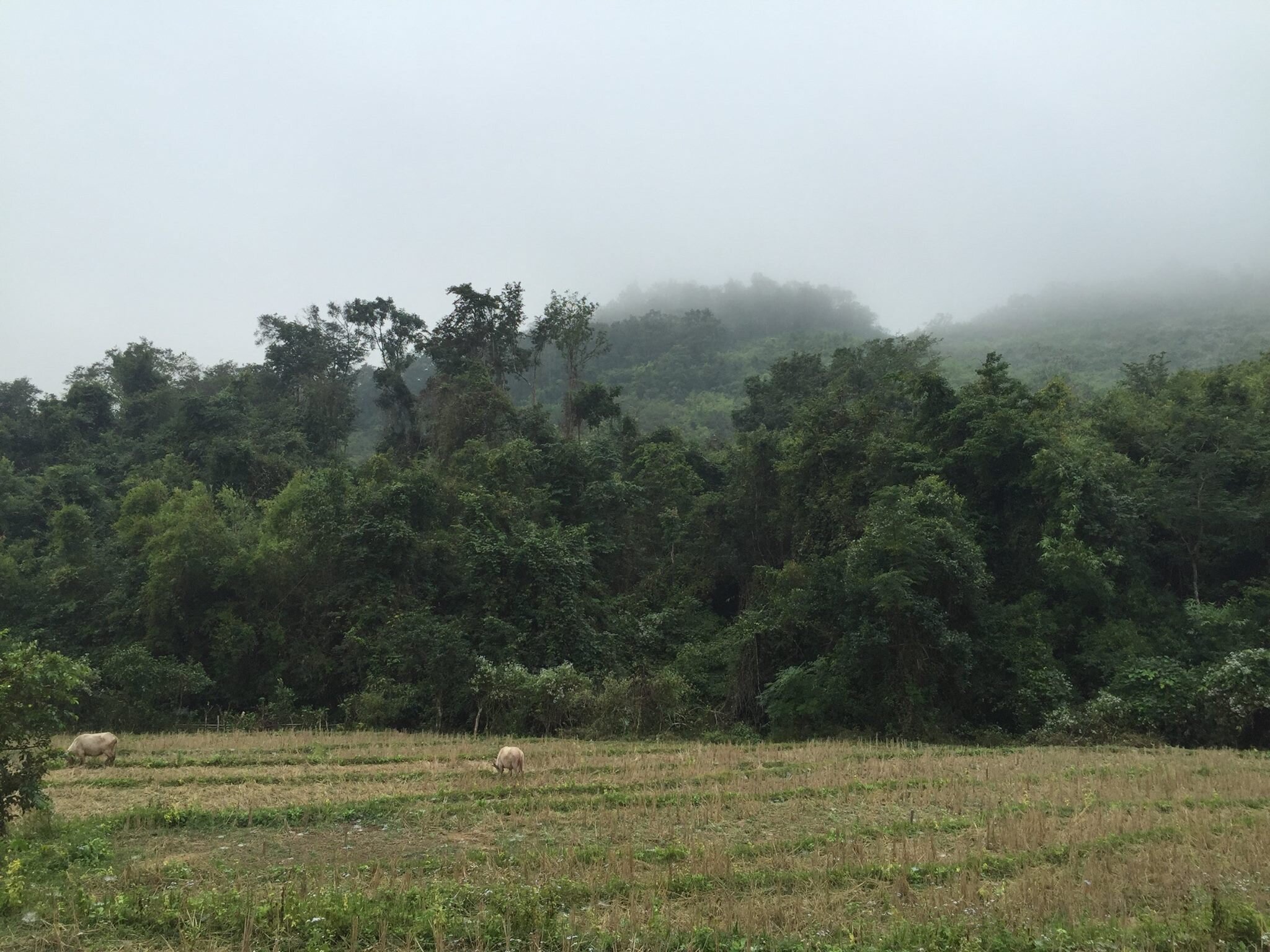
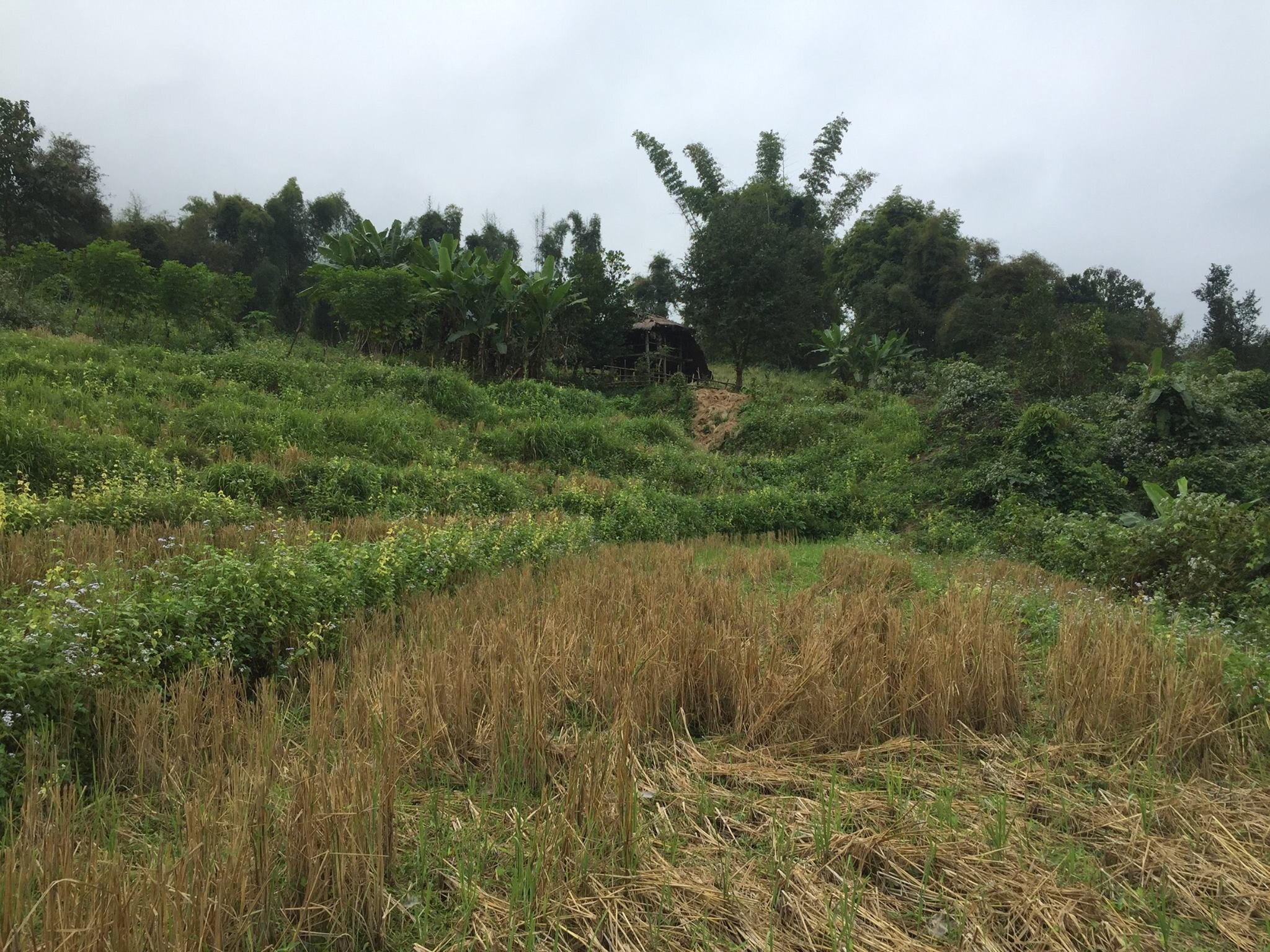


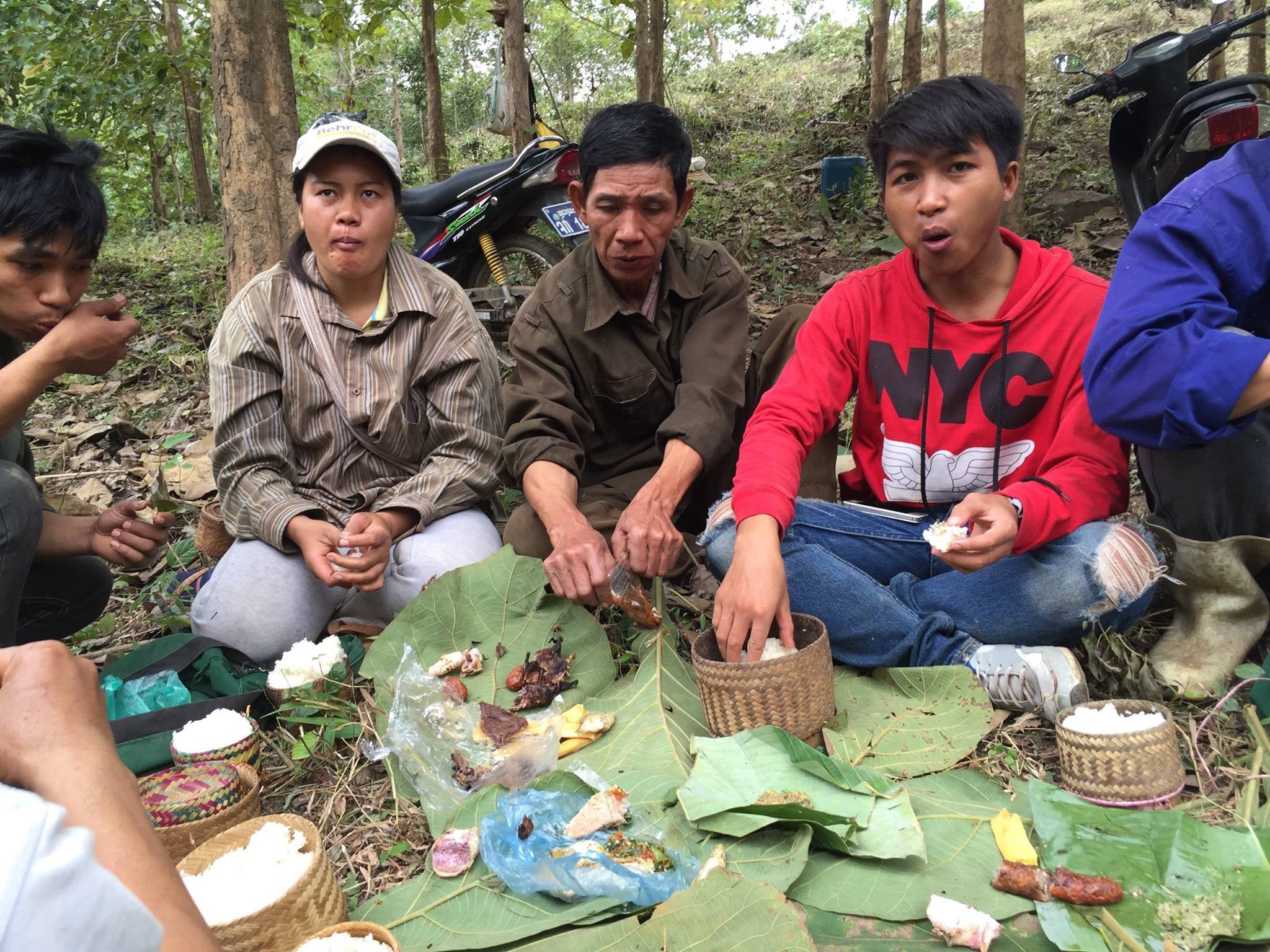
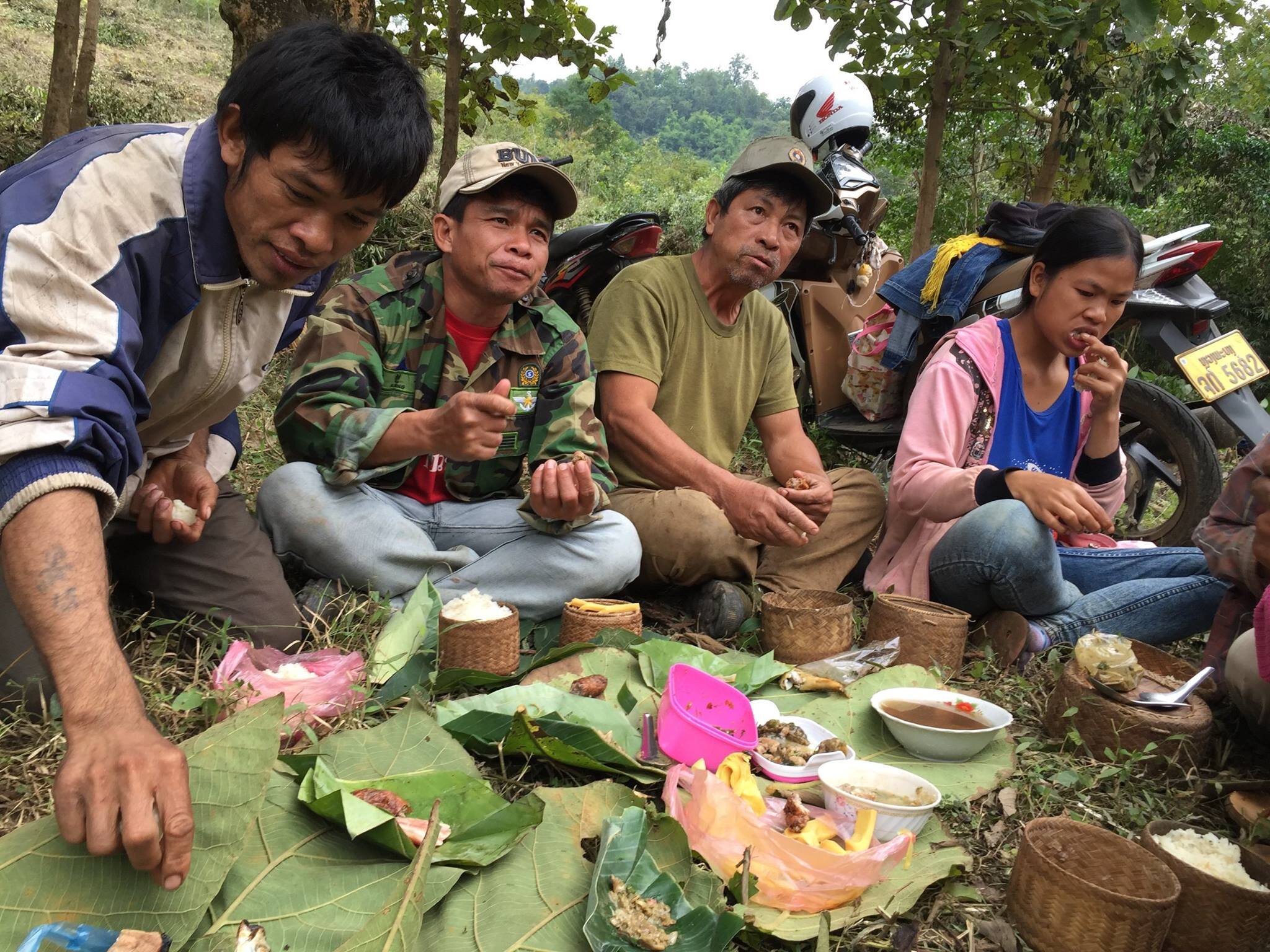
Laying the foundations of the Dairy Farm
To build a dairy we needed land, and so we sent the team out to look for somewhere suitable. They looked and talked with farmers and landholders. We looked at many parcels of land and, finally, after talking with a bunch of farmers in Ban Naxao, we decided that we had found a suitable bunch of connected properties that would work. We rented the land for a two-year period with options to renew, and spent lots of time clearing the land and building fences. We planted grass, as we knew that this was the most critical first step.
However, when we got to the point that we needed to put in a new road to continue building, we ran into a roadblock. Literally. While we had a signed piece of paper from the village chief stating that we could have four-meter-wide road access, it turned out that it was the deputy village chief who signed that and he didn’t have authority to give it to us. That and we would be going through another piece of property that wouldn’t grant us access where the road was easiest for us to build. We tried negotiating, but were constantly told, “No, you only have motorbike access.” “You can buy this one hectare of land for USD $150,000.” “You can move your road over there next to the creek coming down.” None of these were viable options for us, so we decided to stop with the plan for that site and to look elsewhere.
The team went out again to look for new land and came across the parcel of land that we still have now, in Ban Muang Khay. It was flat, check. It was empty, check. It already had electricity, check. It was on the main road with road access, check. It was on the direct route to Kuang Si Waterfall (a major tourist destination) check, check, check! And so, we began negotiations yet again for land rentals and building rights.
It took about six weeks with 40-60 people every day to clear the land of all the trash and black plastic sunk into the ground from the watermelon farm that was on the land years before. Clearance was an arduous task, but a necessary one since there would be living animals that traditionally forage on site, and we needed to make sure it was all gone to keep them healthy and safe.
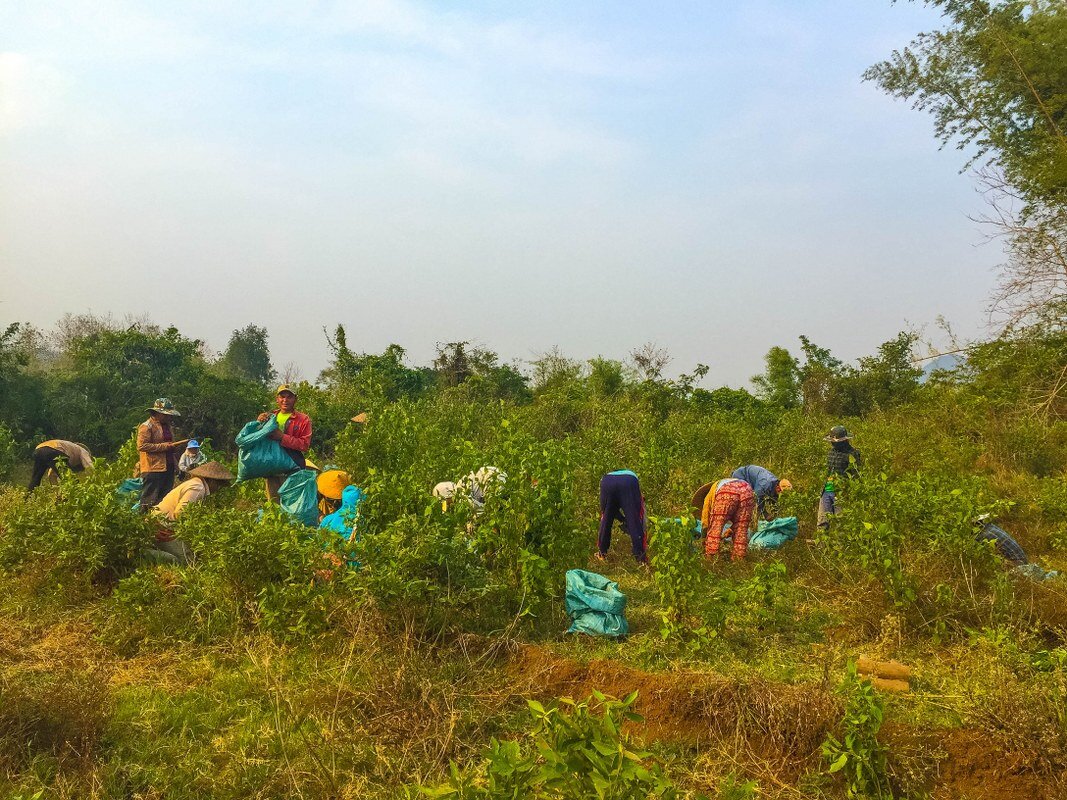
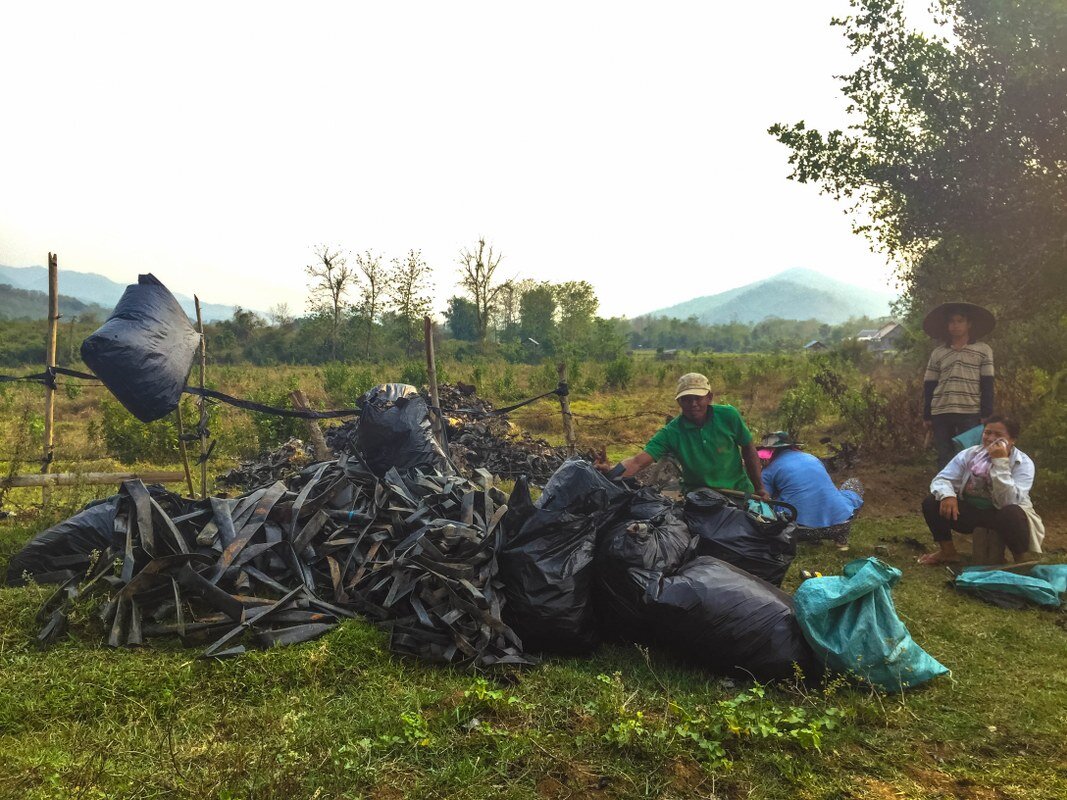
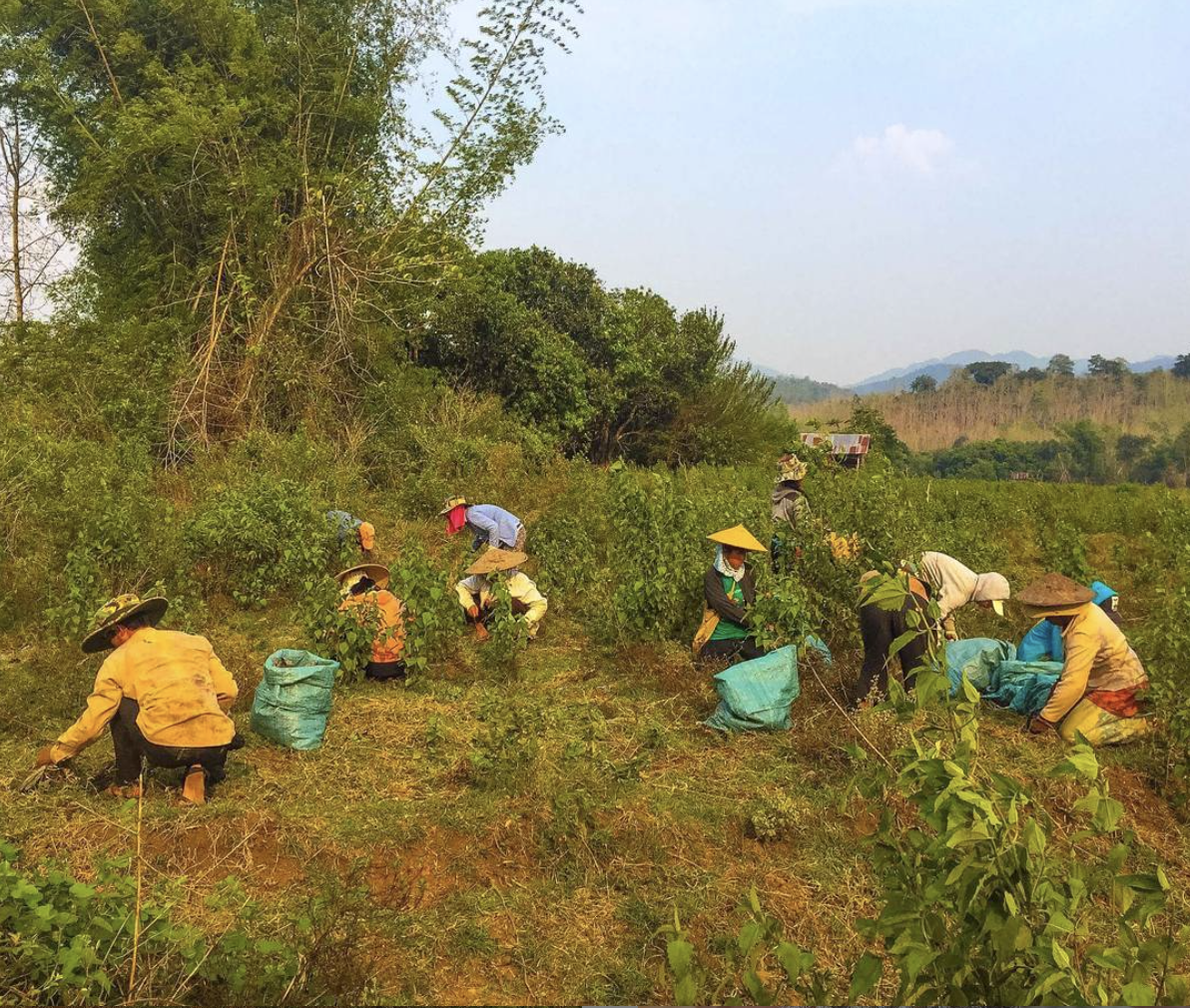

Getting the Farmers onboard
During this time, we prepared and thought about how we could convince the farmers to trust us. We knew that they wouldn’t just give us their “bank accounts”, which is essentially what a buffalo amounts to for a farmer. Farmers keep between three and five buffalo in their “herd”. When they need money to, for example, send a child to school, for a marriage, for a hospital stay, a baci ceremony (a buddhist blessing ceremony), or when someone dies, they sell as many buffalo as they need to pay for whatever it is. But, unfortunately, while the buffalo is their bank account, they don’t make any interest off it. And since they generally cannot afford to pay for vaccinations, there is no guarantee that their “bank account” will provide them with any money since the animal may end up dying of a disease. It’s like a lottery that way.
We decided to hold four informational sessions in one day, spread out over several villages – Kok Mon, Pit Nyai, Ban Jok and Ban Naxao, to talk to the farmers about our idea. Luckily, due to Susie’s persistence with the government, we had Doctor Som, and some other key agricultural officials, on our side to help with these meetings. Dr. Som is a Laos veterinarian who was trained in Cuba many years ago and had an understanding of dairies from his time abroad.
We had our team once again going to villages where there are lots of buffalo, and that are close enough to where the farm would be, to put up fliers about what we wanted to do. While they were in these villages, our team did some preliminary talking with people; asking how many buffalo they had, and would they be interested in coming for an informational session, giving them a brief intro to what we are planning.
We went to these informational meetings with our government allies and had some pretty good turnouts. It appeared more people were interested than not. And they had questions; questions about diseases and the health of buffalo; questions about diets. We answered all of the questions they had. We asked them all to sign an attendance sheet with their phone numbers and planned to have them all visit the farm soon.
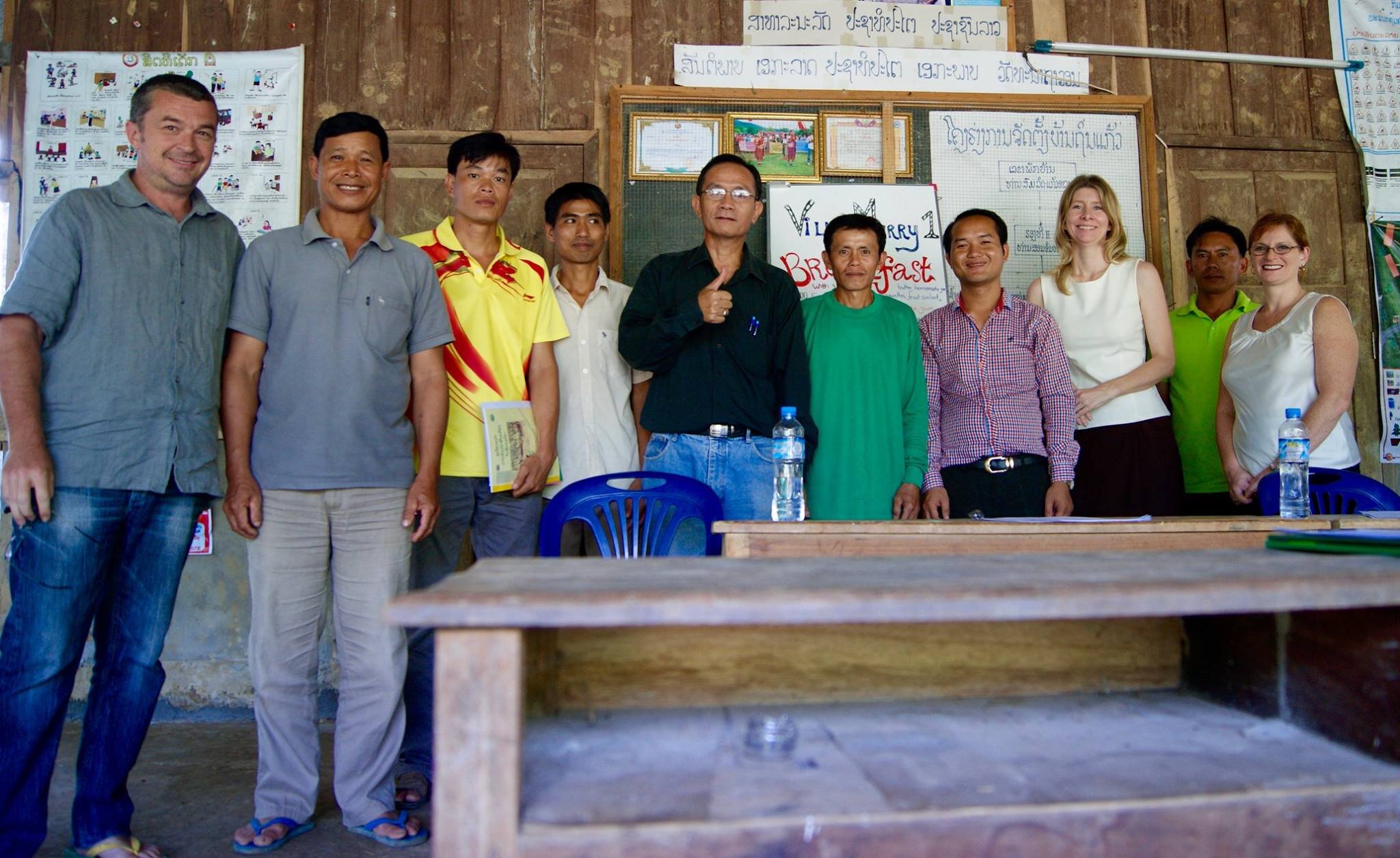
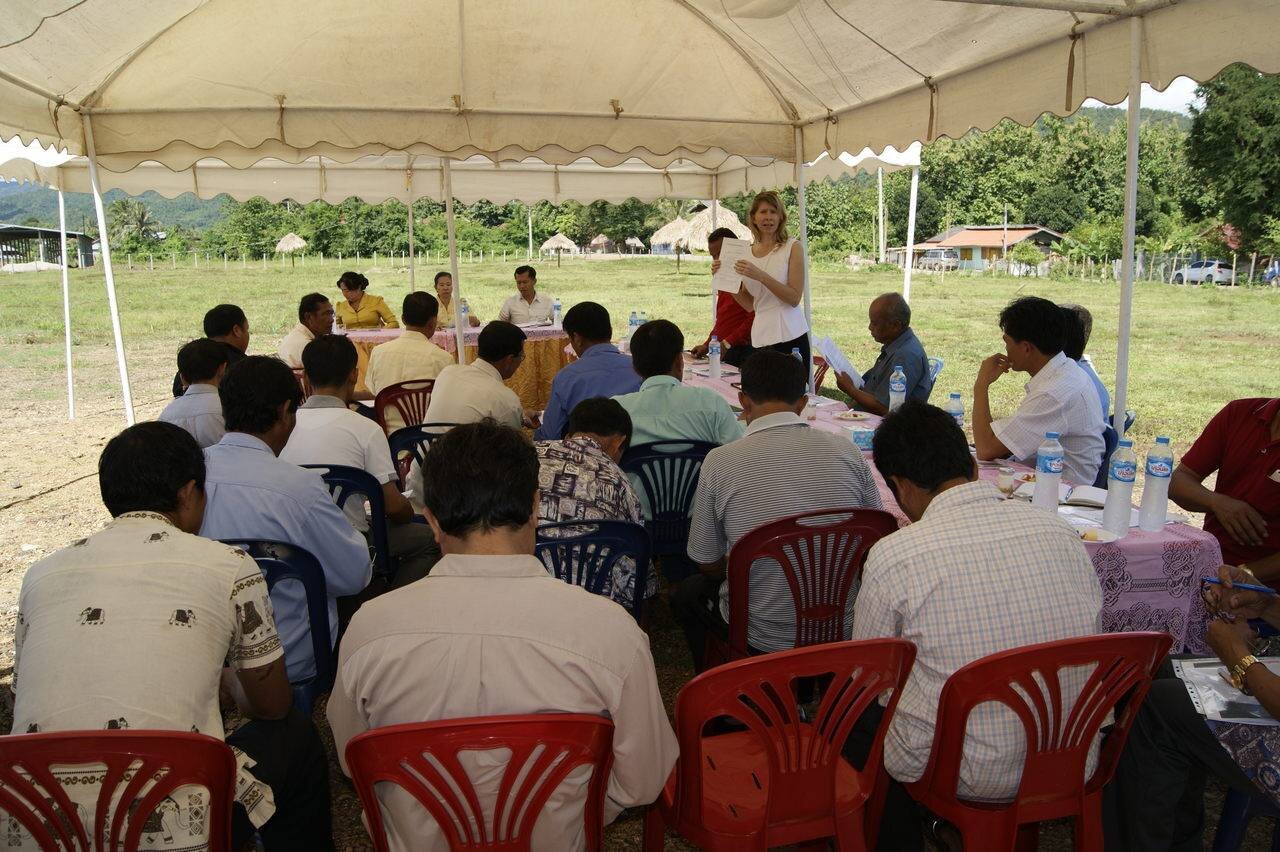
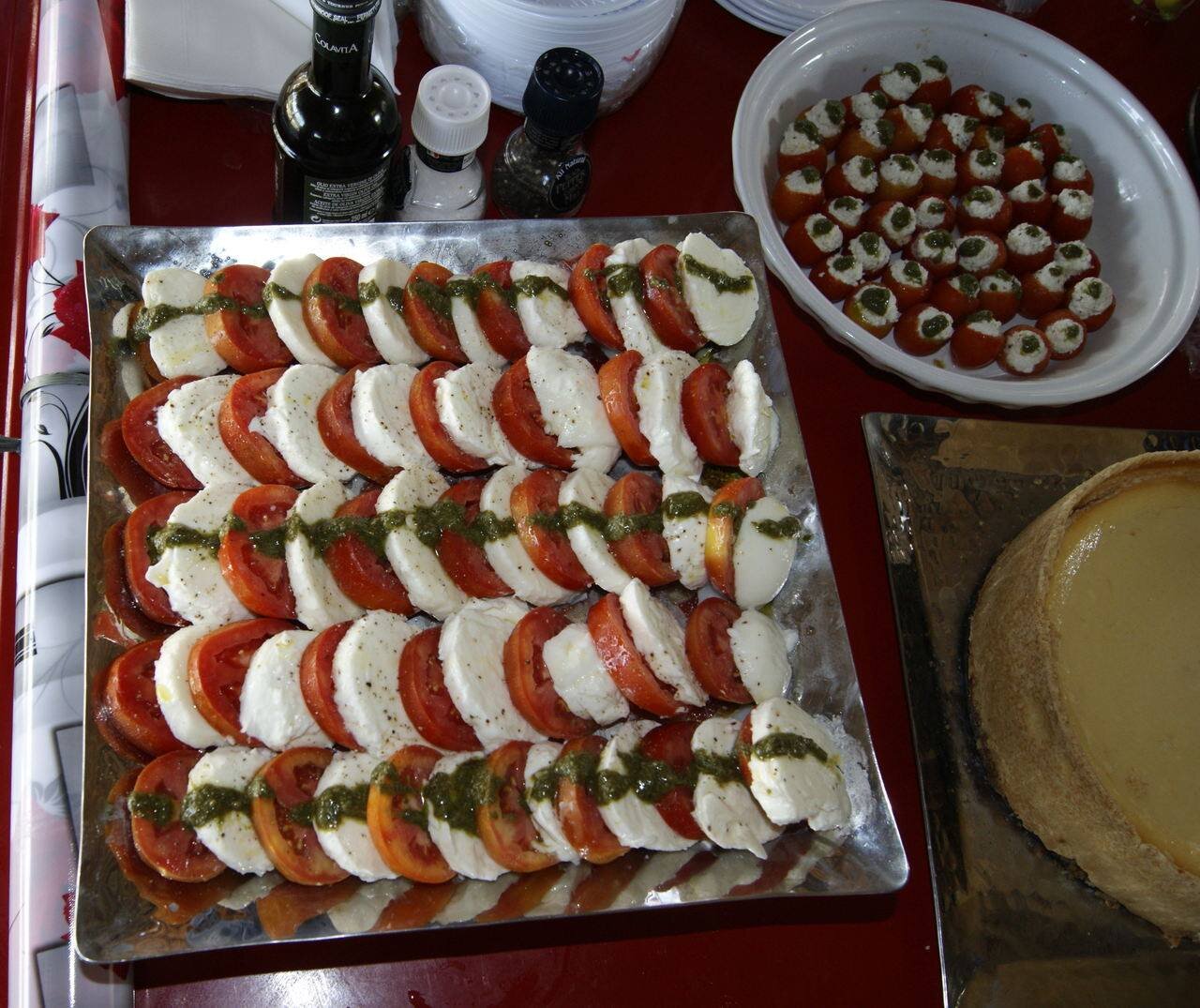
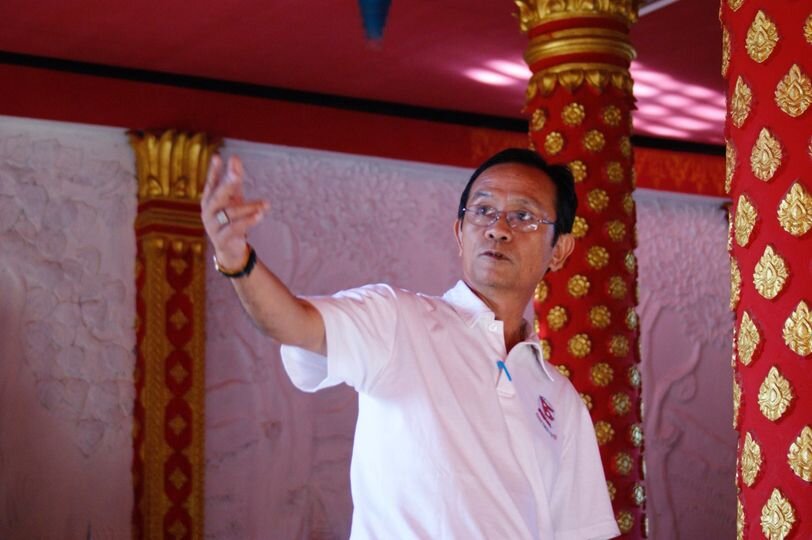
Talking with the Village Chiefs
For the next stage we brought the village chiefs to the farm and showed them what we were doing. We needed to get the village chiefs on our side before the farmers would agree to work with us. So, we set up a meeting, in October 2016, with 17 village chiefs at the farm and explained our new business and what it would mean for the farmers. We prepared yogurt, mozzarella caprese, ricotta stuffed tomatoes and cheesecake for the chiefs so they could taste what we would produce. We had Doctor Som with us, as well as other agriculture government officials, who helped explain and helped show them around. We talked about writing up a contract that is mutually agreed upon that each farmer would have to sign when they bring us their buffalo. Once all of that was set, our next step was to bring the farmers in.
Farmers Visit the Dairy
We arranged with the villages to come to visit the farm one village at a time, and they brought all the farmers who had buffalo. Every time they came we talked with them about what we were doing and how it would benefit them. Remember Mr. Eh and chief Somlit from earlier? Well they were some of the first people to have buffalo on our farm. This helped when the other farmers came. The farmers could see how the buffalo were handled by us and our team. They could see how healthy they were, and how much better the body condition was than the buffalo that were left to roam around unattended.
The farmers liked what we were doing but they were still skeptical about bringing their animals to us. They wanted to see their brother, cousin, or neighbor do it first to see the results. We understood that, it’s a lot to ask for their trust to do something when they have no idea how it will turn out. It’s like telling someone, give me your bank account and I promise I’ll return it in full with interest. Why would you trust that someone would do that? So, we needed to prove to them that it would be worthwhile.
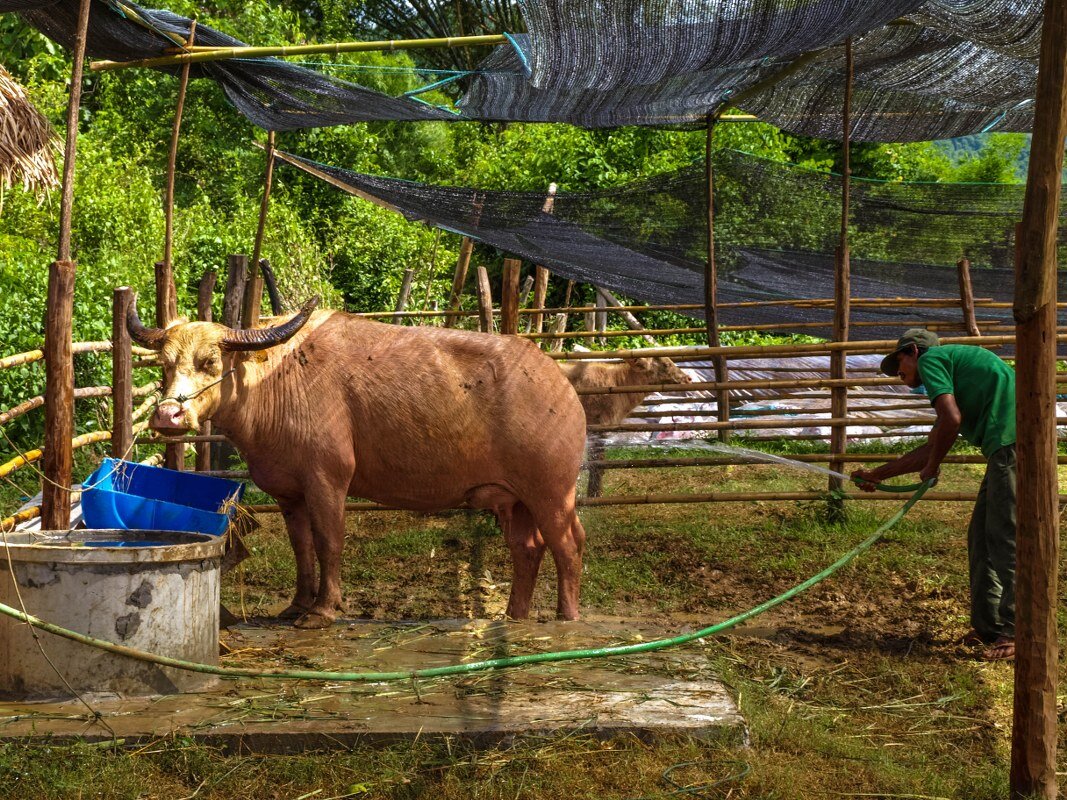
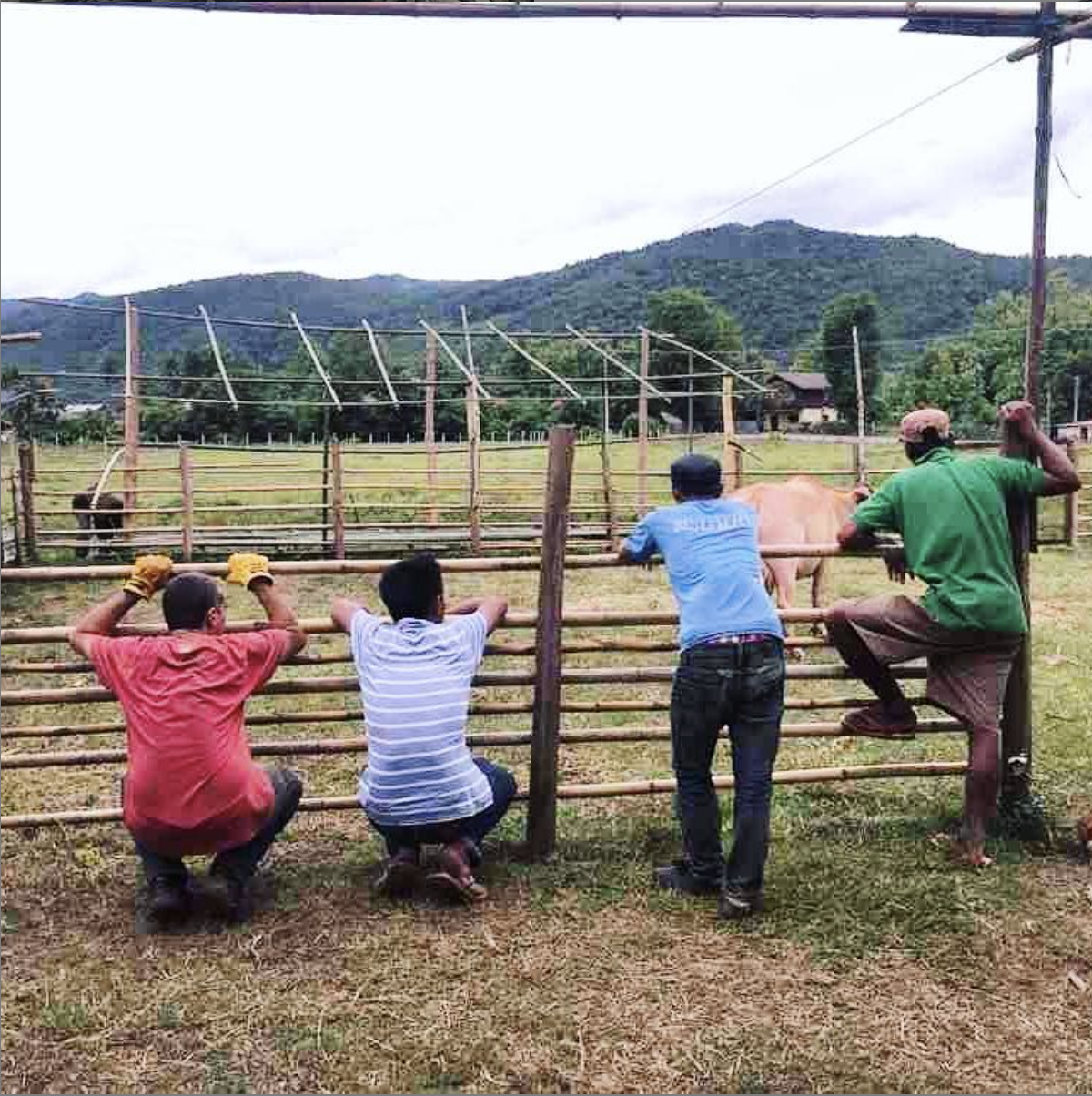
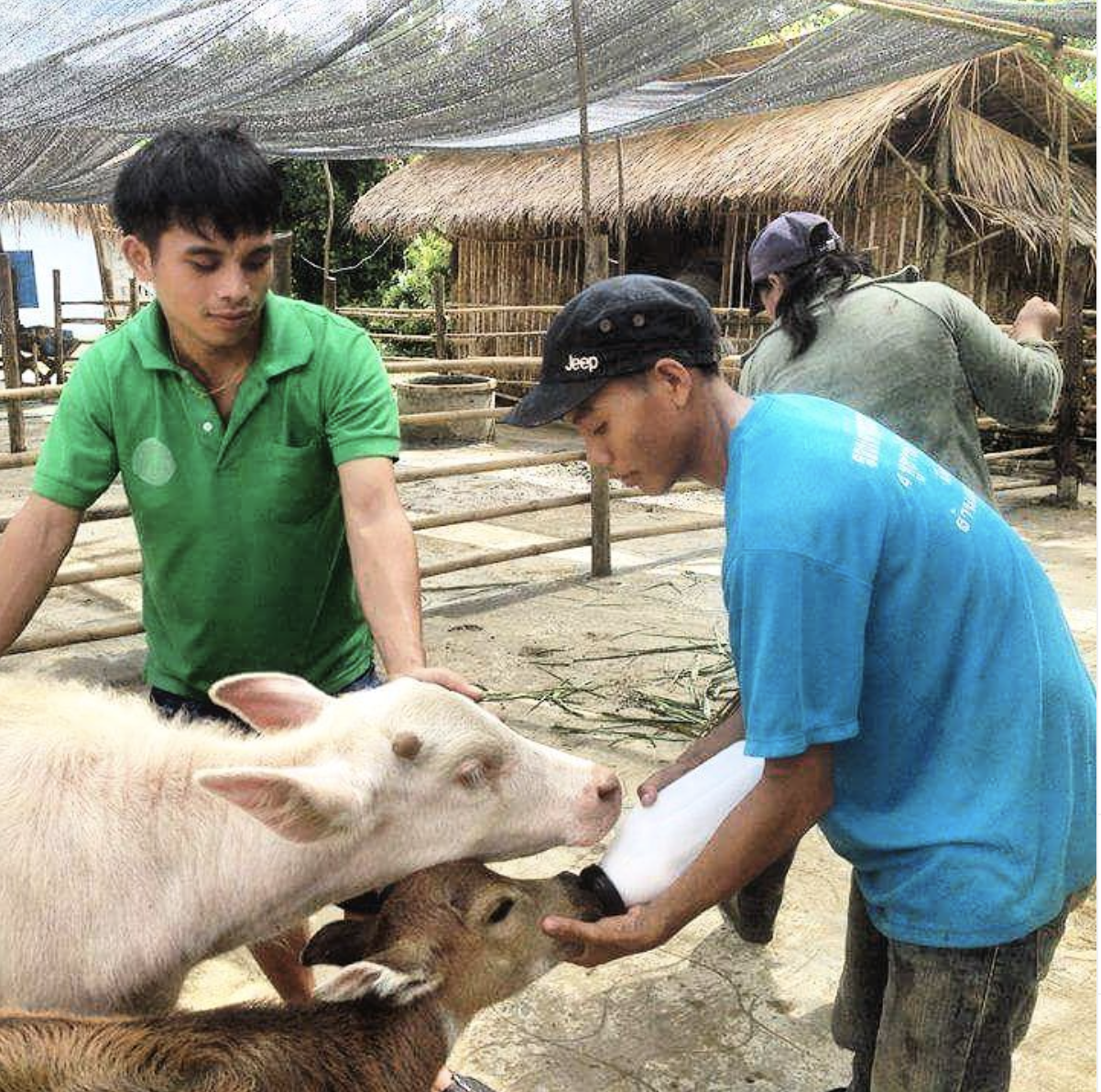

Uli and his Buffalo
A businessman in Laos, by the name of Uli had heard about what we are doing and he thought it was a great idea that would benefit the local people. He offered to buy pregnant buffalo to keep on our farm. That was a very generous offer and we were excited that he believed in what we were doing, but we needed to tell him we were not ready yet. The mini-farm was very rudimentary at this point and couldn't house that many buffalo.
He agreed to wait and we went about our business talking with people, feeding the few buffalo we already had, training a team, and just generally going about the day, trying to make things work. Then about two months later, we got a phone call from Uli – he had found a trader and bought nine pregnant buffalo and they should be arriving soon. That’s fantastic, but we still weren’t ready for them! This of course posed a problem as Uli didn’t have any land to keep the buffalo on. So, after some back and forth phone calls, he finally found a friend who was willing to take them for a temporary time until we could transfer them to the farm. This made us move faster. We needed to finish the mini-farm to take them.
But, we decided some other things needed to happen before the buffalo came to us. Like knowing if they were pregnant and how far pregnant they were. After an initial assessment, it turned out that of the nine buffalo he bought that were supposed to be pregnant, only four actually were. Uli sold the five buffalo who weren’t pregnant and we brought the other four to the farm to wait. One of these buffalo was to become our star, Lola! Thanks to Uli, we had some more buffalo to give us milk, but still not enough.
In the end, the reticence of the farmers to become involved caused us to do something drastic. In September 2017, we were still only getting about six liters of milk a day, as we only had a few buffalo on the farm. If we wanted to succeed, we needed more milk so we could make products to sell. We went to our friends at the Mini Murrah Farm just outside of Bangkok, Thailand and we arranged to buy 12 pregnant Murrah buffalo from them. On 26 September 2017, our pregnant ladies arrived on the farm. It was quite a to-do to get them off the truck too. You could tell the team was a little hesitant with these big beasts – they are much bigger than the local swamp buffalo. We tried telling them in Lao to move off the truck and then in English, but it wasn’t until a team member spoke to them in Thai that they actually moved. A good laugh was had by all, and our pregnant buffalo moved into quarantine for their first month with us. And now we had to wait for the calves to be born...
The Murrah heading to quarantine just after getting off the truck.
In our next blog, find out how our buffalo breeding program developed and meet the cute buffalo calves...
HAVE YOU SEEN OUR SOCIAL MEDIA THIS WEEK?
If not, pop on over to facebook/laosbuffalodairy or instagram/laosbuffalodairy to see what we have been up to!
TOURISM IN NEED
COVID-19 has badly affected tourism and visits to the farm. In order to mitigate some of the effects of the loss of income this has meant for the dairy, we have teamed up with the Tourism in Need initiative that supports responsible tourism organizations affected by the pandemic. Through this initiative, travelers can support the dairy through the Give Today, Go Tomorrow fundraising scheme. Click here to find out more and to make a contribution to help us to pay farmers and team members, and continue to train farmers and work on our nutrition program.
The Laos Buffalo Dairy Story: Part 1 - From Singapore to Mozzarella
In this week’s blog post chef Rachel shares our story as we tell it on the farm tour. We realise that while some people know about us, they don’t really know how we got here. Well, here goes!
In this week’s blog post chef Rachel shares our story as we tell it on the farm tour. We realise that while some people know about us, they don’t really know how we got here. Well, here goes!
Callie, Josh, Brie and Sarah on holiday in Borneo.
In 2013 our two families had a collective mid-life crisis. Susie quit her job, and a few months later, Matt quit his job. It was Halloween night in Singapore when Matt called me to say he had quit and was going to get a beer before coming home. At the time, I was walking down 42 flights of stairs with the kids and trick-or-treating. Talk about a time to have a mid-life crisis and a bit of a freak-out!
When I arrived home and told Susie what had happened, I asked her what we were going to do now, because I knew I certainly wasn’t ready to go home (meaning back to America). Susie suggested we go build a hotel somewhere and I agreed and thought we should go to Laos. Now, you might ask why a hotel and what could we possibly know about building one?? Well, Susie was regional GM of serviced offices with a head for numbers, marketing and staffing; Steven was an electrician and a construction manager in his old life; I was a chef and Matt was in finance. All four of us made a great team to start a project like this.
The next day we broke the news to Steven and Matt and told them our idea, and not even two weeks later, Susie and I were on a plane to go have a look-see at Luang Prabang. We had been to Luang Prabang to visit as tourists, but now we decided to go have a look to see if we might be able to go and move there for any opportunities and have a life there with our families.
Our buffalo curd & treacle breakfast in Sri Lanka.
While visiting, Susie and I decided to spend more money on food-related things than accommodation. One of the things we decided to do was to take the cooking class with Amantaka, a luxury hotel, and which included a field trip through the morning market with the chef. While walking through the market, we asked the chef where the buffalo curd was. Having been to Sri Lanka, and having had the curd every morning for breakfast while there, we naturally assumed that we would find it in Laos as well, considering how many buffalo walked around. He looked at us like we had three heads and asked, the what? When we explained it was a rich, creamy, thick yogurt made from buffalo milk and since there were so many buffalo, we thought they would milk them and make it. The chef stopped dead in the middle of the market and gave us a wide-eyed stare, while asking, “You can milk buffalo??”
Susie and I looked at each other and said, “Oh, we can do this!” And so, an idea was born.
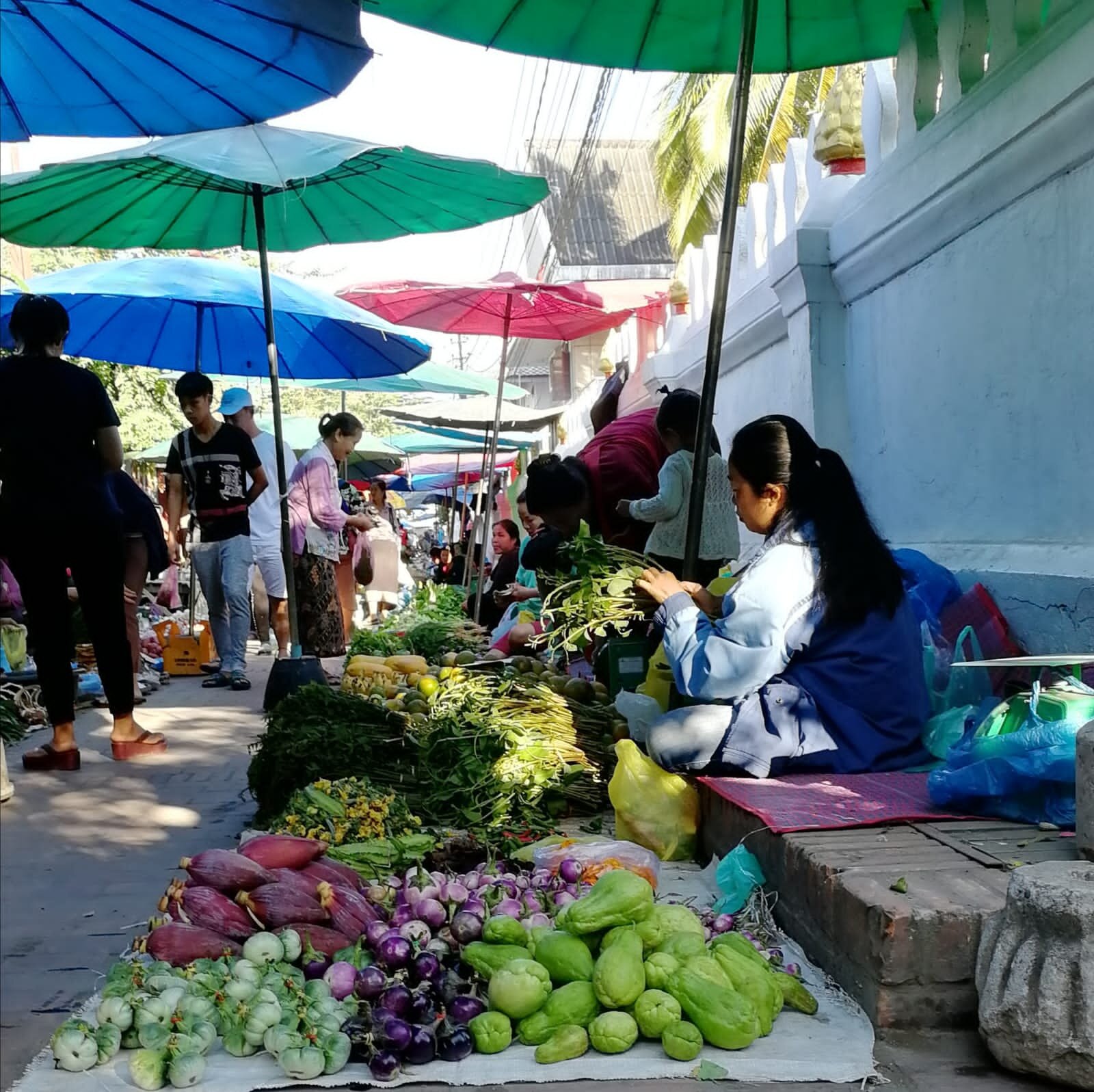
In January, the boys came back to spend ten days here. While here, Steven and Matt managed to find a guesthouse we could rent so that we could be hands-on on the ground and see how things worked. In August of 2014, Steven and Matt and the kids moved to Laos first to find houses, start running the guesthouse – Merry 1 - and get the kids settled before the school year started. In September, Susie and Rachel followed. Two days after Rachel moved to Laos, Matt moved to Hong Kong to start a new job.
When we first arrived, we had made a list of things that we thought the city could use – a real estate agency, large hotel, dairy, and some other ideas as well. Within the first few weeks we had a conversation with a friend about some of these ideas, but said that we thought the hotel should come first. The idea was always to design an eco-hotel, get the land and the licenses and then sell to the highest bidder, sit back, relax and play with the other ideas.
What a great idea! Only, it wasn’t to be that way. Two months after our arrival, our friend called us and said he had a farmer who was willing to work with us on milking buffalo. Oooooohhhhhkkkkaaaayyyyy….. so I guess that means we’re switching lanes.
Off we went to meet with this farmer and started to chat with him. We had to explain where milk came from, as it turns out that since there is no dairy culture here in Laos, most people thought that milk either came from a box (the UHT milk they are familiar with drinking) or from fruit – like coconut. We had discussions about how you could milk buffalo, just like you milk cows and showed him videos of people in India milking buffalo.
During the month and a half that we had discussions with him, we had a guest staying with us at Merry 1 that turned out to be more helpful than just a guest staying with us! One morning when she walked into reception, I looked at her and had a funny thought. I said to Maria, “Do you, by any chance, have any dairy knowledge?” Maria gave me a very shocked look and said, “Actually, yes, I do! I worked on a dairy farm for ten years, and I’ve been in dairy finance for 15!” I was so excited, I blurted out, “You’re my new best friend!”
Maria sat down at the desk with me, and I explained that we had an idea to start a buffalo dairy farm. We had a farmer that we were beginning to work with, and we needed help writing out directions on how to milk buffalo. She told me that she had never milked a buffalo, but she had milked cows and it couldn’t be all that different. After some discussion on how to do it, she promised that she would write up instructions in a step by step list for us, that we could then go and get translated into Lao. She was also interested in meeting the buffalo, as one of the things that she warned us about, was that if the buffalo were anything like cows, they weren’t very friendly with strangers and what we wanted to do might be very difficult.
With the translation done, we called the farmer again to go and see him and do some more explaining. This time he asked if we wanted to meet the buffalo. And of course, we said yes! We asked Maria if she would be interested in coming along since she was our milking specialist at this point and could be there to help answer any other questions the farmer might have as well. She was excited to come with us and meet the buffalo to gain a better idea of whether what we wanted to do would even work.
When we arrived, the farmer walked us into a little field he had nearby where he and his neighbor kept their buffalo. He told us that he had one tied to a tree as this one was kind of testy and didn’t like anyone, so he wanted to make sure we were all safe. Let me tell you it was a bit intimidating walking into that field with those big animals, having never been up close and personal with a buffalo before!
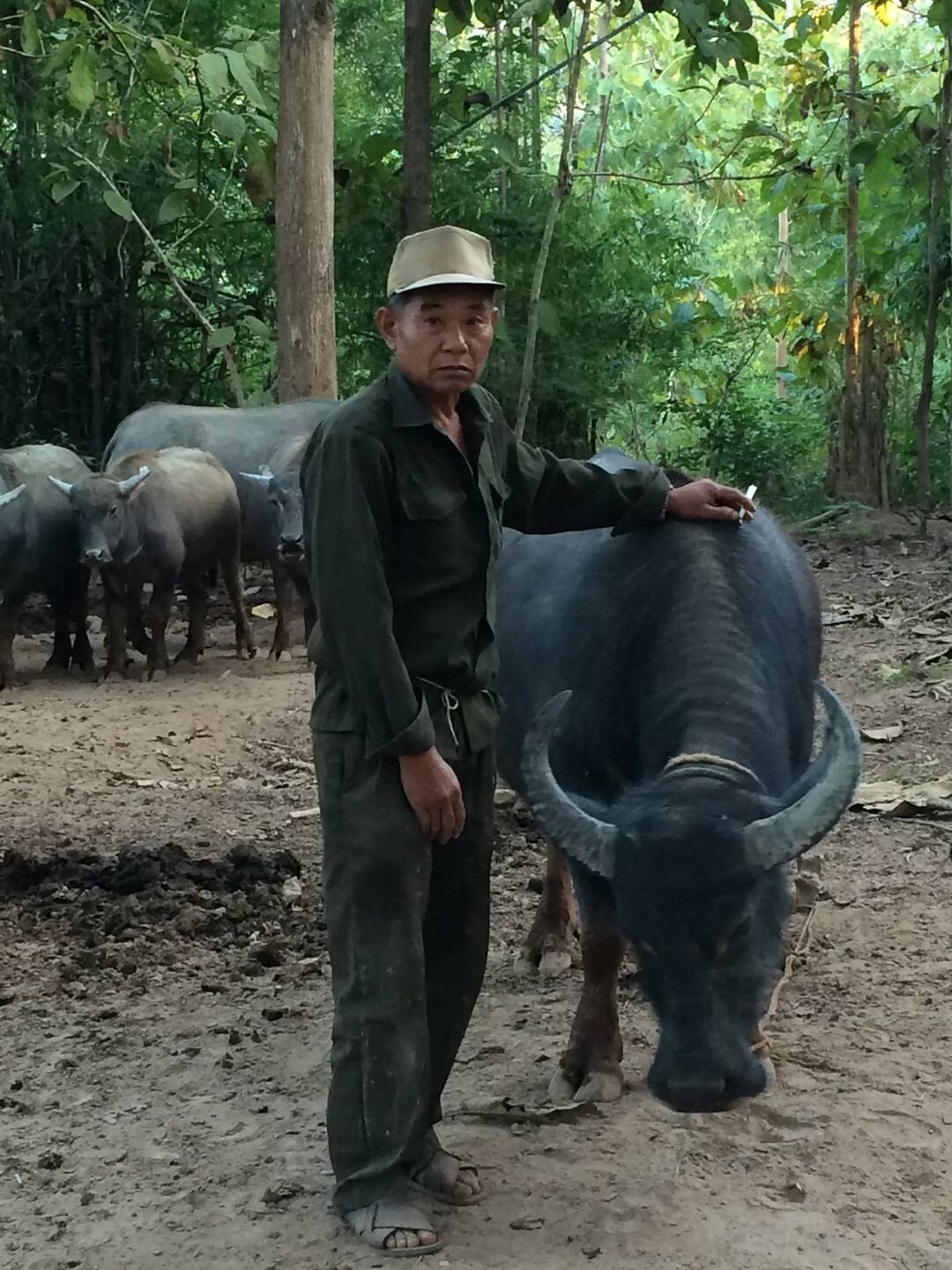


As soon as we entered, the farmer walked right up to one and started to scratch it on the butt. Its tail raised immediately, which we soon learned was a sign that it was enjoying what the farmer was doing. Before long, surrounded by curious buffalo, I was getting a bath by buffalo tongues! When the farmer noticed this, he asked if I wanted to stay with the buffalo as it was clear they liked me. Thank you, but no thank you. ☺ Maria was surprised at the curiosity and calm nature of the buffalo and decided that we wouldn’t have a problem at all if most buffalo were like this.
At the end of the day, we were happy and thought we could start a successful trial….. Until…. We received a phone call from the farmer, and he asked if the baby still needed to be drinking milk from the mother for this all to work. When we answered that yes, that was key to the trial, he told us that that had stopped a month ago. We thanked him and said we would see him next time around when the babies are born.
Being stalked by a buffalo…..but isn’t she cute???
At this point, we decided that we had invested quite a bit of time into what we were trying to achieve and that it was worth sending our team members out on a search to find another farmer who might be interested in working with us. It took about six more months, but finally, we came across Somlit, the village chief in Ban Thinkeo. Somlit is an outside the box kind of guy, and we love him! We spoke with him a few times and explained what it was that we wanted to do. We sat with him and some of his villagers to describe the milking and why it would be good. After some discussions, Somlit told us he would find us a farmer with who we could work.
Finally, we sat down with Mr. Eh, one of the villagers, who had three buffalo with calves that ranged in age from 2.5 – 4.5 months. We talked about the 6-week trial we’d like to do. We explained that we would need to build a fence with a separate pen for the calves and that while they were penned and separated, he would need to feed and water them. This approach was a big deal as in Laos, farmers generally cannot afford to feed, vaccinate, or pen in their animals, so they allow them to roam free looking for food and often wandering in areas where there may be diseases that could harm them.
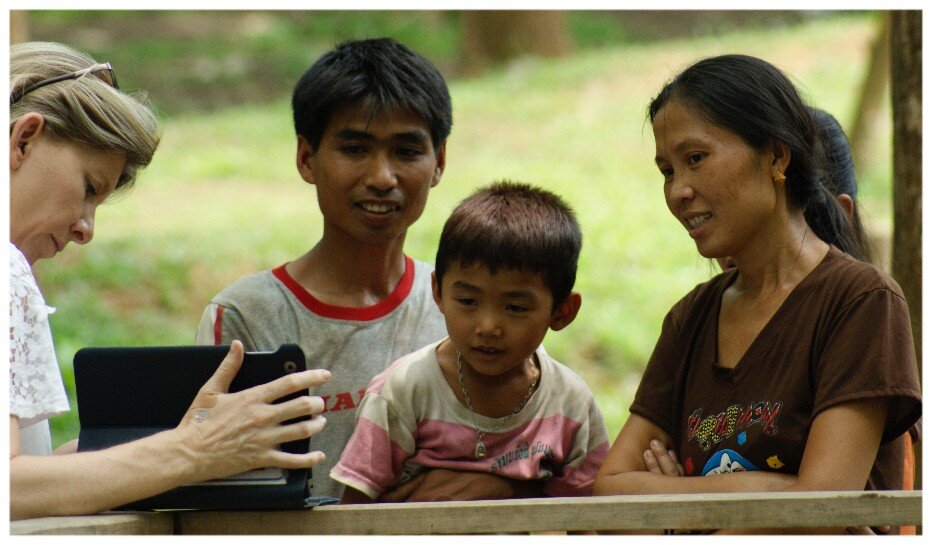

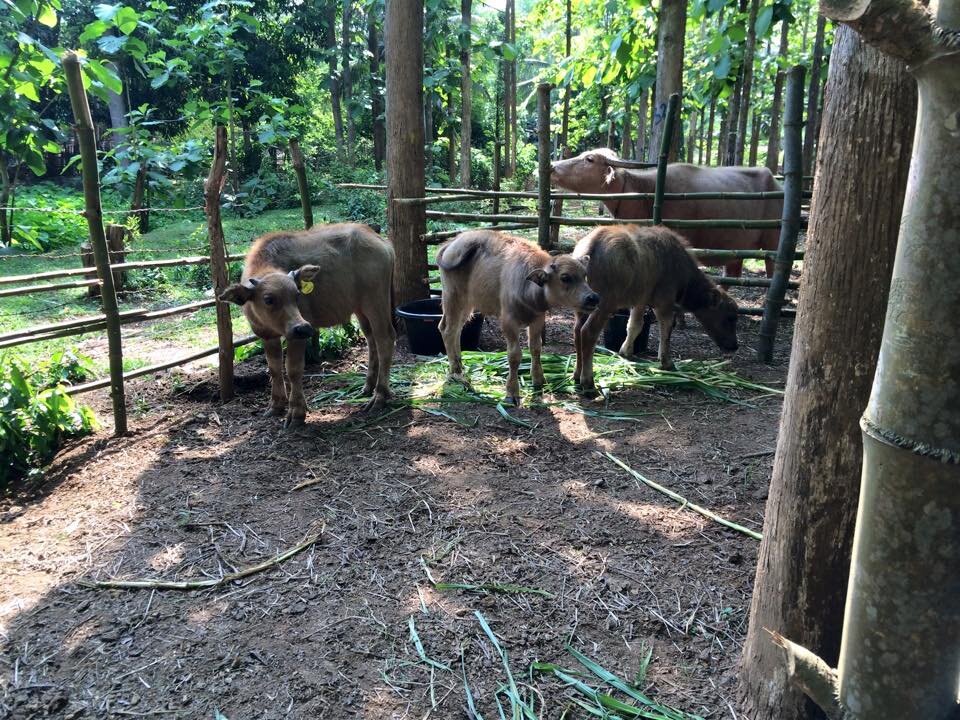
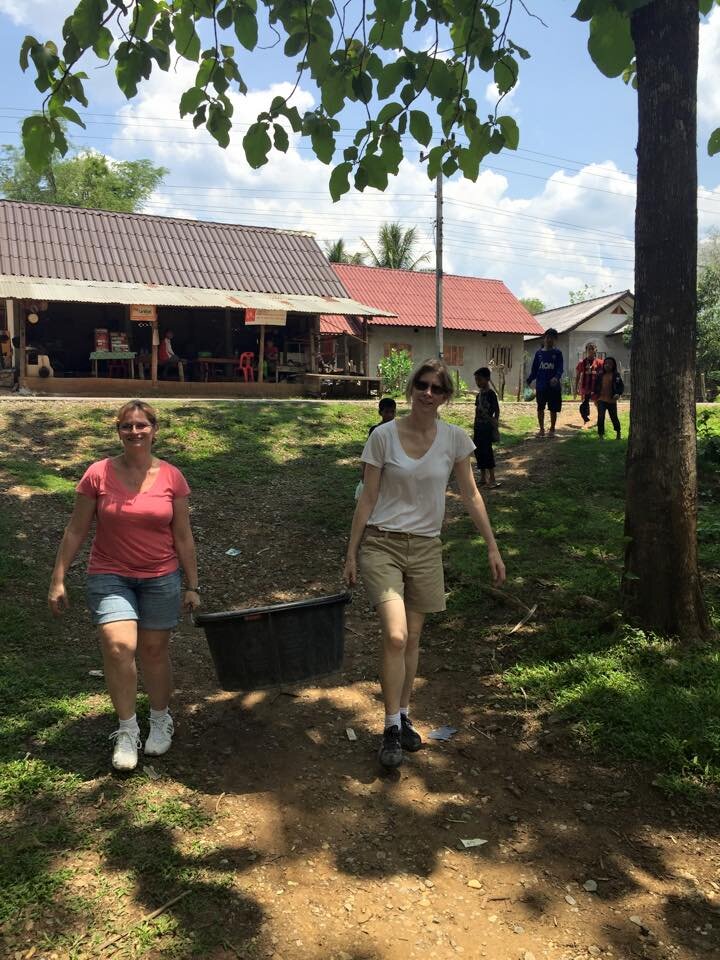
We looked at an area he had under some teak trees where he already had a pen of sorts built and then discussed how it would need to be changed a bit and reinforced. And add in a crush that we will be able to get the buffalo into securely so we can milk her. We explained that she would be more amenable to milking if we fed her at the same time and we would need to build a little trough as well. We bought the supplies to do it all and like Captain Picard, on Star Trek instructed, “Make it so!”
Once the buffalo were penned and separated, we started to milk or at least tried to milk them. It took a bit of time for them to get used to what we are doing and produce any milk. Having never been handled like this, we needed to teach Mr. Eh and his wife how to do it, since it was their buffalo and they were more accustomed to being handled by them. We were very excited when it worked. We had already talked with Mr. Eh about how the milk needed to be kept cold after milking until we could pick it up. And this posed a problem in the beginning as most people in Laos still do not have refrigeration in their homes, but they do have big coolers that they fill with ice. We supplied him with containers to milk into and store the milk – a separate one for each buffalo so we could keep track of how much milk they gave.
Steven as the “Caped Cheese Crusader” flying by to go get milk.
Steven drove out to Thinkeo every day to collect the milk and bring it home to me. Every 3 to 4 days, I had enough milk with which to experiment. And every 3 to 4 days, I tried to make cheese and cried. Why did I cry? Well, it was impossible to find cheese recipes online for making buffalo milk cheeses. There were very few people out there who made buffalo milk cheese and those who did, did not usually share their recipes. So, having never made cheese before, I was using a cow’s milk recipe to try and make it work for buffalo milk and adjusting after each new batch to try for a successful trial. Only, the composition of cow’s milk and buffalo milk are very different and do not react the same way with the ingredients, hence the tears.
I finally decided after days (more like weeks!) of crying and failing, that I needed help! I looked online and found all of the dairies worldwide who made buffalo milk mozzarella and emailed them all with my plight. Of the 15 dairies that I emailed, only one replied. And that was Thea from Shaw River Dairy in Australia who emailed and offered help. In her email, she told me that she could give me her recipe but that it won’t work, which of course stops me right there and I burst into tears yet again! But as I read on, she explained that the differences in fat in the milk plays with the ingredients, and I would have to adjust accordingly. I had an “aha!” moment and realised that I could work with this. So, I compared the recipes, with where I had started, where I have gotten to and with what Thea gave me, and I tried her recipe first. She was right, it didn’t work, but it did get me a lot closer. With a bit more adjusting, I finally perfect a mozzarella ball, just as we finish our 6-week trial. But, at least now we know that we can get milk from the local swamp buffalo and that I can successfully make mozzarella!
Next time...Building Laos' first ever dairy in Luang Prabang!
Here at Laos Buffalo Dairy, we are proud to be recognised at the prestigious WTM World Responsible Tourism Award in the Neighbours and Employees category. The awards this year were a little different as the judges decided to commend businesses and destinations which are taking responsibility and addressing the many challenges of Covid-19.
We won the award for the work we are doing to support the local Laos communities in and around Luang Prabang by setting up the first Buffalo Dairy in the country. The dairy is a popular and growing tourism attraction, and when Covid-19 hit all the income from tourists went away. Instead of shutting up shop, we re-imagined how we could continue to support our staff and the local communities.
Below is what we have been doing to keep local people employed and how we have been using our facilities to help our neighbours cope with Covid-19.
Staff
The dairy continues to employ all its regular staff, all of whom come from the local villages and, although payments have been reduced, all staff still make over the minimum wage. Also, free housing has remained available to any staff if needed. Free English classes for staff continue, meaning the chance to upskill for when Covid-19 is over. For any of the team with children, there is free buffalo milk to improve family nutrition.
Community
In the wider community, we have continued with the nutrition programme we have been implementing. The programme involves pilot projects in four local villages to research the best ways to increase nutrition, and implement improvements with resources already available to villagers. Issues with nutritional concerns will not go away with Covid-19, so continuing to work out the best practice in this area will allow us to roll out the programme on schedule, after reviewing the pilot stage.
Also, as part of the nutrition programme, we continue to expand and diversify from being solely a buffalo farm. During Covid-19 the first two cows arrived at the farm, and recently we acquired our first goats as part of our project to create a goat haven. All of these actions continue to help support the local rural village communities in a time of need.
Instead of cutting back training, the dairy is also continuing a farmer training programme to help the local villages.
Initially, we supported 17 villages and increased this to 20+ communities, all of which continue to receive support during Covid-19.
Free English classes take place on-site, and between 30-50 local children attend these elementary classes. Besides this, during the school holidays, the dairy teamed up with other responsible tourism organisations (Traditional Arts and Ethnology Centre, MandaLao Elephants and Free the Bears) to create a week-long English Language Summer School programme. The scheme allowed around 30 children from the local villages to attend English lessons, and visit these local tourist attractions.
The dairy has built a children’s play area that the local children can come and use every day (Monday-Friday). Up to 20 children use this facility each day.
To increase domestic tourism, we refocused on the local market, and for 50,000 Laos Kip ($6) we offer a tour of the buffalo farm. The money paid can also be used against any purchases in the cafe and is sufficient to cover three scoops of ice cream per person.
All of these programmes could have stopped due to Covid-19. However, it is a sign of the spirit, determination and commitment to our vision that we found a way to continue helping the local communities and loyal staff.
Coming soon!!!
The Little Book Co
We've got exciting news! We've been invited to have a page in a new coffee table book featuring inspiring stories of female business owners and change makers!
The book is going through pre production now and should be available by mid November. Keep your eyes on our next newsletter for more information!
HAVE YOU SEEN OUR SOCIAL MEDIA THIS WEEK?
If not, pop on over to facebook/laosbuffalodairy or instagram/laosbuffalodairy to see what we have been up to!
Lily's Story - Our amazing, cuddly cutie pie
If you have been to the farm or you follow us on social media, you know that we have two cats called Cracker and Lily. Today’s story is all about Lily so, don’t tell Cracker or he will get jealous 😊.
Lily was a rescue(d) cat! It all started back in June 2018, during the rainy season when after some serious rains and flooding, we were on our way home from the farm in the tuk tuk one day when we saw something in the middle of the road. Khamla swerved around “it” and we realized it was a little kitten. We pulled up to a stop, with Susie saying, “No, no no!” the whole time as we already had quite a few cats a home. As the tuk tuk stopped and we got out to go at least move her off the road, she looked at us over her shoulder and turned to come running at us. As I reached down to pick her up, she cuddled up onto my shoulder and purred like crazy.
We walked around the edge of the road and looked to see if we could find a mother cat nearby or other kittens thinking maybe she had just strayed away from them, but we found nothing. She was such a tiny little thing that we couldn’t in good conscious just leave her there. So, we took her with us. I stuffed her inside my coat to keep her warm, as it was quite chilly from the rain, and she cuddled right in. She must have known that her life was about to change for a better that she could never imagine.
Lily came home with us that night and got a bath – she desperately needed it as she was very dirty. She was fed some milk and food, and came to bed with me. From her size, we estimated she was only about 7 weeks old. Way too little to be away from her mother, so I guess we were mum now.


We luckily had Nicola, a vet, who was here in Laos working with Sydney University on a project, coming to the farm in the next few days, so we asked if she could have a look a Lily and make sure she looked ok and also confirm our thoughts on her age. Nicola confirmed her age for us as approximately 7 weeks old and told us that her fat little belly was probably full of worms. Not an issue! A worming tablet was given and all would be right with the world.
At the time, we had another cat at the farm as well – Kiara. Kiara was also a rescue cat, but she had been found in our chicken coop (also at about 7 weeks old). Kiara, now being about a year old, decided to take on the roll of mother cat and started to teach Lily how to act.
Lily flourished under the tutelage of Kiara and became cat extraordinaire. She learned how to hunt and play and be a smooch for affection.
Fast forward to now, and every morning when we arrive at the farm, Lily comes for her morning snuggles and purry cuddles. She helps to keep the mouse, rat and small snake population on the farm down to a minimum. And she walks the farm checking on the other animals to make sure all is good. On occasion you can find Lily following along with the guests on a tour. If we ever leave Laos, she has most certainly earned herself a passport out with us.
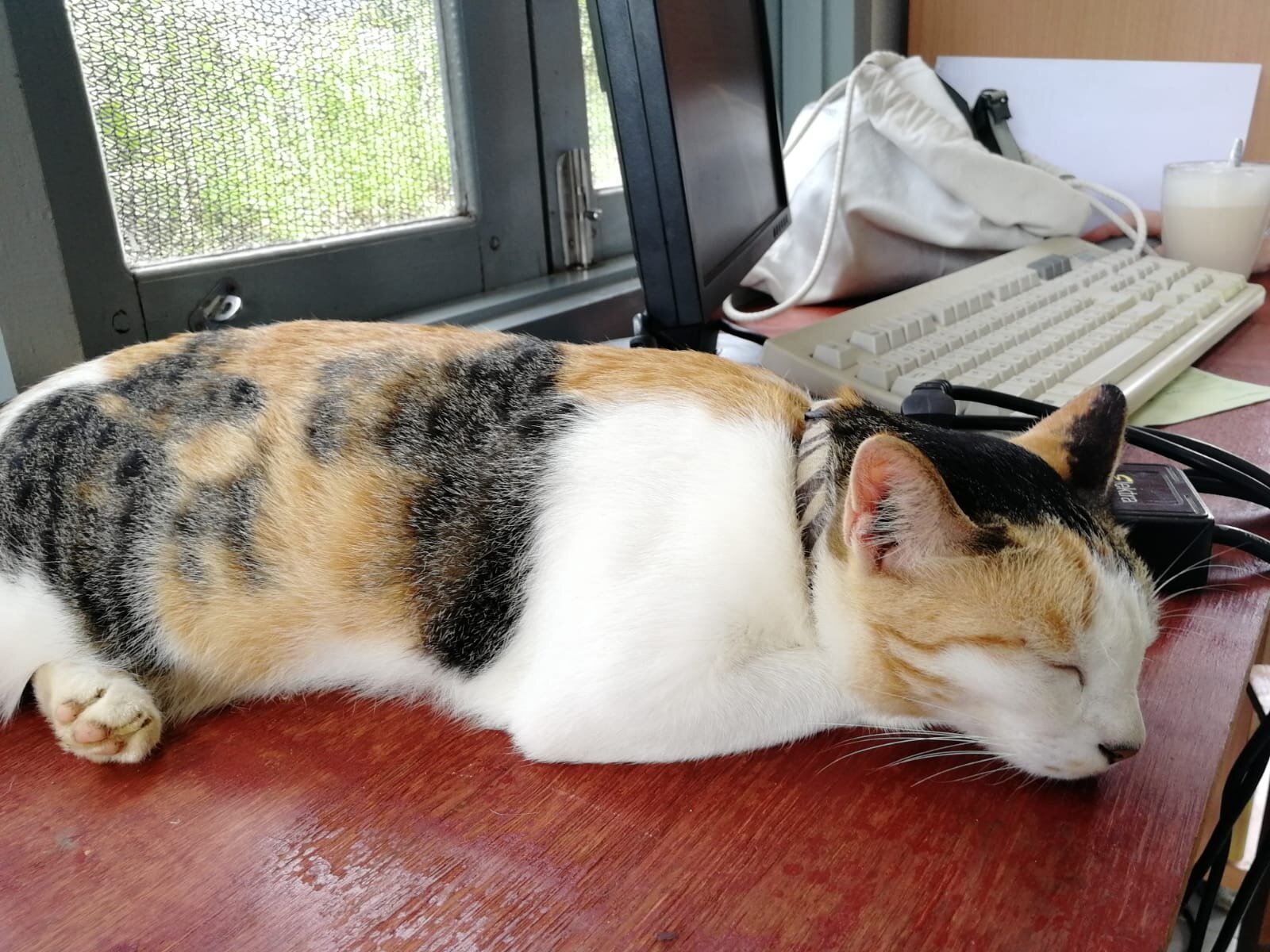

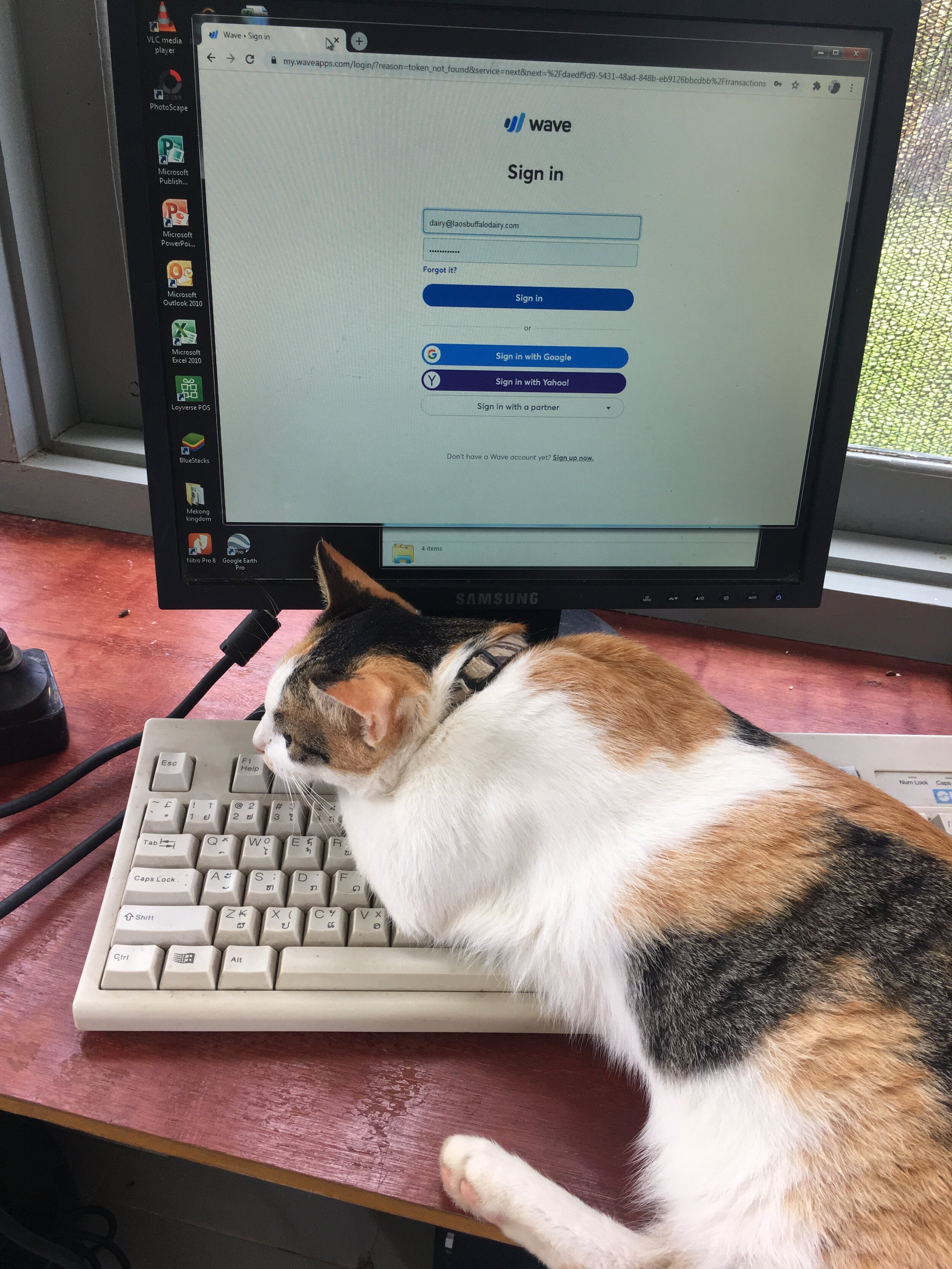
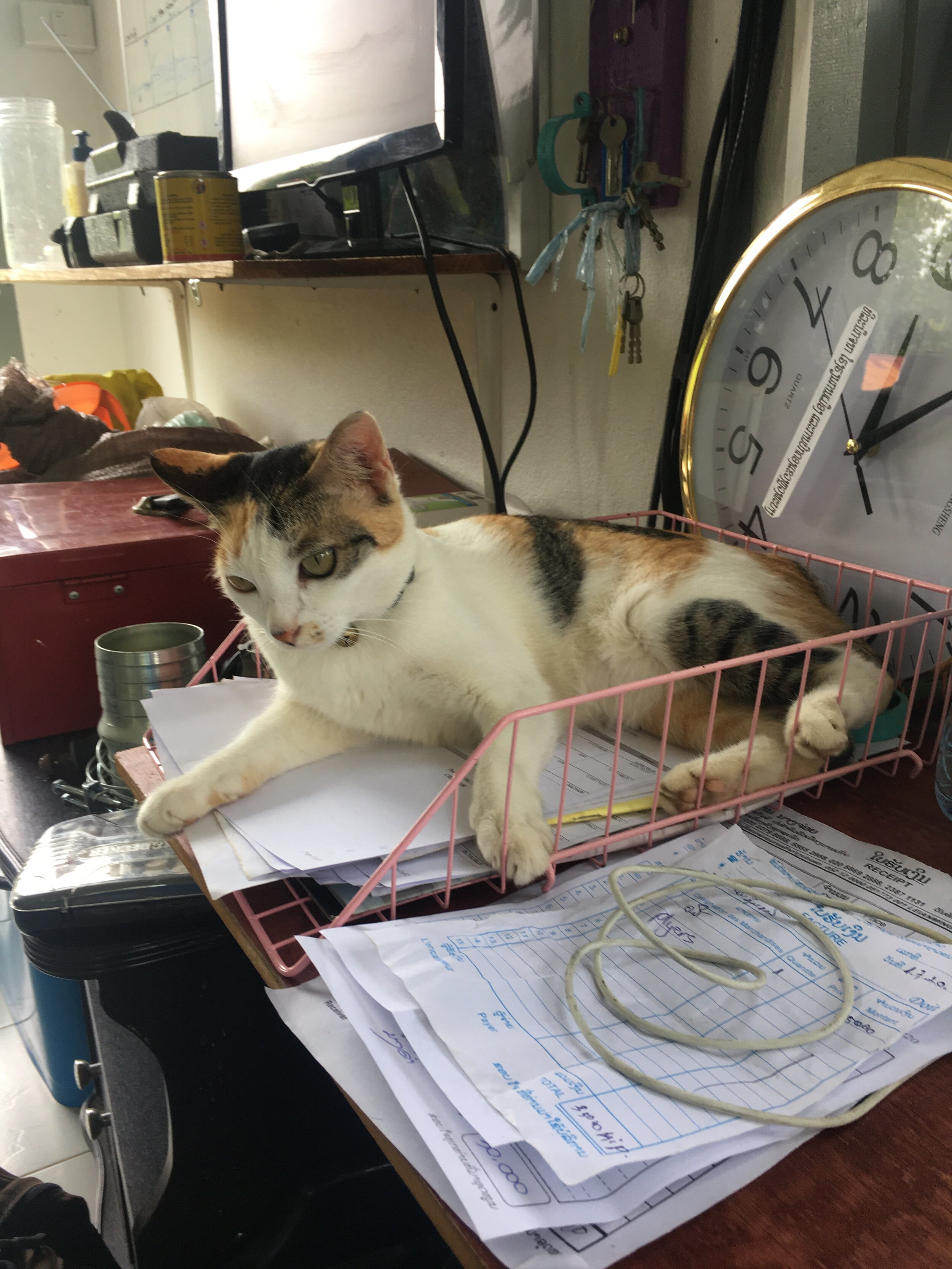
As you can see from some of the pictures, Lily’s favorite place to hang out in is in the office. Lately, with the lack of tourists coming to pay attention to her and Cracker, she has taken to “getting in the way”. Lily decides when the work day is done, but placing herself squarely in the file box or across the keyboard as I try and work.
Lily and Cracker are making do with seeking attention from us, but they’d really like to see you come back to play with them.
TOURISM IN NEED
COVID-19 has badly affected tourism and visits to the farm. In order to mitigate some of the effects of the loss of income this has meant for the dairy, we have teamed up with the Tourism in Need initiative that supports responsible tourism organizations affected by the pandemic. Through this initiative, travelers can support the dairy through the Give Today, Go Tomorrow fundraising scheme. Click here to find out more and to make a contribution to help us to pay farmers and team members, and continue to train farmers and work on our nutrition program.
HAVE YOU SEEN OUR SOCIAL MEDIA THIS WEEK?
If not, pop on over to facebook/laosbuffalodairy or instagram/laosbuffalodairy to see what we have been up to!
Coming to Luang Prabang sometime soon? Need suggestions on what to do? Pop on over to our Suggested Itineraries page and make a plan.
Mineral Blocks – Reducing Small Holder Farmer Poverty & Fighting Climate Change
Here at the Dairy, we love nothing better than to be involved in innovative ideas that help us meet our aim to improve the rural prosperity, welfare, nutrition, and health of the local population, with a focus on buffalo farming, and childhood nutrition. So, today we welcome you to the wonderful world of AgCoTech, https://www.agcotechglobal.com/ and their unique medicated mineral block technology. The technology was developed and tested in partnership with the Australian Government Department of Foreign Affairs & Trade (DFAT), the Business Partnerships Platform (BPP) and The University of Sydney. These mineral blocks for livestock help reduce greenhouse gases and reduce poverty in smallholder farms in countries such as Laos.
Here at the Dairy, we love nothing better than to be involved in innovative ideas that help us meet our aim to improve the rural prosperity, welfare, nutrition, and health of the local population, with a focus on buffalo farming, and childhood nutrition. So, today we welcome you to the wonderful world of AgCoTech, https://www.agcotechglobal.com/ and their unique medicated mineral block technology. The technology was developed and tested in partnership with the Australian Government Department of Foreign Affairs & Trade (DFAT), the Business Partnerships Platform (BPP) and The University of Sydney. These mineral blocks for livestock help reduce greenhouse gases and reduce poverty in smallholder farms in countries such as Laos.
We are excited to be involved in the work that AgCoTechdo so much so that we are planning to build their factory on the farm to produce the mineral blocks and help distribute the blocks to farmers with whom we work! Even better, AgCoTech is similar to LBD with its unique business model approach. Once the factory is operating it will be employing local team and the majority of the ingredients like molasses will be purchased from Laos farmers. Households will then be allocated blocks each year for free to distribute & improve the health of their livestock. The carbon credits the subsequent reduction in emissions generate are then able to be sold providing the funds to keep producing and distributing the blocks!
So, let’s start at the beginning. AgCo Tech created a product that uses innovative technology to improve animal nutrition and welfare and improves the quality and health of livestock. The mineral blocks also make positive environmental contributions by reducing greenhouse gas (GHG) emissions and help develop better and more sustainable local livelihoods for local smallholder farmers. I think you can see that these shared aims make AgCo Tech a perfect match for us!
Emeritus Professor Peter Windsor at The University of Sydney robustly tested the mineral block technology as part of a research project undertaken in Laos and Cambodia between 2007-2020. The conclusions of that piece of research across the project sites were that a three-step intervention strategy needs to be put in place at a village level to optimise smallholder cattle production efficiency. Of, course for our work can also apply this to include buffalo farming.
The three-step strategy is as follows:
Step 1 - Whole of village Foot & Mouth Disease (FMD) & Haemorrhagic Septicaemia (HS) and parasite management.
Step 2 - Establish high-performance forage plantations.
Step 3 - Introduce high-quality nutrient molasses blocks.
In last week’s blog post, we described how we implement the first two steps in villages, using Homphan village as a case study. You can read about our work in Hompahn Village by clicking here.
Step 3 is where AgCo Tech comes into the latest chapter of our story, with their high-quality nutrient molasses blocks.
How the partnership formed.
We had first been introduced to Professor Windsor from the University of Sydney in 2016 when we were first discussing the idea to open Laos Buffalo Dairy and were looking for advice. He and Dr. Syseng Khounsy, Deputy Director General Department of Livestock & Fishery, kindly offered us some advice particularly on necessary vaccination protocols and bio security measures. This would prove invaluable when there was an outbreak of FMD in a village nearby and the Dairy was not impacted.
After our first meeting I imagine they didn’t expect to hear much from us again, as we embarked on the first Buffalo Dairy in Laos! However we forged ahead and during Professor Windsor’s numerous visits to Laos, he and Dr. Syseng would visit to check on our progress both of the farm and the cheese. 😊 Their research project involved veterinary students from Sydney University so we would often have students doing short stints at the Dairy helping to train the team and simultaneously learn about some of the challenges faced in providing veterinary care in Laos. Click here to see more about their experiences.
Veterinary students, Arjuna and Jenny working with a buffalo in a crush at Laos Buffalo Dairy – the calf is brought along to prevent distress in both the mother and the baby.
On a visit in 2019 Prof. Windsor and Dr.Syseng were accompanied by Chick Olsson CEO of AgCoTech and the idea to set up a trial, using the mineral blocks to test the results on milk yields was born. The results demonstrated that the mineral blocks helped improve milk yield in the order of 25% - 30%. This would prove advantageous for farmers joining our nutrition program, as not only would the male livestock now produce more meat and income for households, the female livestock would produce more milk for their calves and for families to access milk for their children.


1.Chick Olsson, Dr. Syseng Khounsy & Prof. Windsor 2.Susie Martin Laos Buffalo Dairy & Prof. Windsor
At around the time that COVID struck in early 2020, the AgCoTech team were in the process of looking for a site to set up a factory to start producing the blocks. With travel now impossible between Australia & Laos, LBD stepped in to assist and it dawned on everyone that the perfect site for the factory would be at the Dairy. With farmers across multiple villages, districts and provinces already involved in renting their buffalo to the Dairy, the nutrition program or both, the partnership with AgCoTech Laos provides a perfect opportunity to provide even more support to these farmers.
Medicated blocks to farmers in Chomphet
In the short term, blocks are being sent from Australia to be distributed during the numerous village visits. The first ones being delivered recently to Ban Som & Ban Ngiew in Chomphet District. However, it’s not just a case of handing out the mineral blocks and forget! As part of the process, animals will be weighed and measured, manure samples will be gathered and tested. The results analysed and the correct blocks distributed. After the first block is finished the team will repeat the process. This will ensure the correct blocks are allocated and provide the ongoing data to prove carbon emission abatement. The AgCoTech and LBD teams will work in collaboration with farmers to ensure animals are also vaccinated and receive high quality forage.
What the Future holds.
The factory is due to start construction late October and be operational by the beginning of 2021, aiming to produce 250,000 x 20kg blocks annually.
A fully stocked agricultural supply shop will be also be set up by AgCoTech at the Dairy to ensure farmers with consistent access to vaccines, worming treatments and other supplies that are often not available. Leaving animals untreated and farmers without many options other than to sell a sick animal and accept a reduced price.
Over time the mineral blocks will be distributed across all of Laos, hopefully in conjunction with the expansion of the nutrition project. With households across Laos seeing an increase in both meat & milk yields subsequently improving incomes and nutrition across rural households.
The research supporting this technology is available in the numerous scientific publications from the MLR research group at:
https://mekonglivestock.wordpress.com/publications.
HAVE YOU SEEN OUR SOCIAL MEDIA THIS WEEK?
If not, pop on over to facebook/laosbuffalodairy or instagram/laosbuffalodairy to see what we have been up to!

1-3 October, 2020 will be the dates for this years' festival of lights, Boun Heua Fai. If you are in Luang Prabang for it, the big night is the 2nd. Make sure you save some time in your day to come see us at the farm!
Read this blog from 2 years ago to learn a little bit about what the festival means.
TOURISM IN NEED
COVID-19 has badly affected tourism and visits to the farm. In order to mitigate some of the effects of the loss of income this has meant for the dairy, we have teamed up with the Tourism in Need initiative that supports responsible tourism organizations affected by the pandemic. Through this initiative, travelers can support the dairy through the Give Today, Go Tomorrow fundraising scheme. Click here to find out more and to make a contribution to help us to pay farmers and team members, and continue to train farmers and work on our nutrition program.
Our Work with the World Bank Nutrition Program - Village Champions!
Part of the work that we treasure most here at the dairy is our outreach work and helping new communities come on board with our programs. Today’s blog exemplifies why this approach works so well.
Part of the work that we treasure most here at the dairy is our outreach work and helping new communities come on board with our programs. Today’s blog exemplifies why this approach works so well.
As part of our work on the World Bank nutrition program, running in Northern Laos through the Poverty Reduction Fund (PRF), we visit the local villages to undertake a three-stage approach to bring farmers into our milking program:
1) 1st village visit is to check the buffalo and build a milking area
2) 2nd visit is to plant grass to help feed the buffalo
3) Village Champions visit LBD to receive a 1-week course
And here is how this all happens, from our experience this year, at Homphan village. Read on to discover how and why everything did not go exactly to plan! And learn how COVID-19 has affected the way we were able to work with this community this year.


1) Homphan Village First Visit 18th-22nd February 2020 - Crush Construction and Buffalo Inspection
The initial visit to Homphan took place in February and the first of two main activities was to catch the buffalo and inspect them. Quite a bit of time was spent catching the buffalo! Ideally, villages construct a crush to make this an easy process. However, at Homphan, no crush was built prior to the visit, so the team needed to catch the buffalo and then tie them to whatever large object, i.e. tree etc, was available before doing the inspection.
Five Buffalo were checked in Homphan village. The buffalo received vaccinations and, where appropriate, an internal examination. Their calves received a worming treatment to help them stay healthy and strong. Four more buffalo in the village had just given birth, however, they were too difficult to catch and inspect. The farmers will catch these for our next visit.
Four of the five buffalo inspected were suitable to start milking and the other four were ready to join the milking program after 3 weeks if another inspection could take place.
(Unfortunately, due to the lockdown to halt the spread of COVID-19 the opportunity to undertake the follow-up inspection in April could not happen, but it will re-start in October. Watch this space!



The second main activity of the visit was the construction of the crush, calf and buffalo enclosure. The majority of this work was complete and only a few additional instructions were left with the farmers to finish the enclosure. Next time catching the buffalo will be a lot easier!
Follow Up
After each visit, the team creates a summary of points to follow-up on. For example, in this case it was the following three items:
Communicate with farmers to help with any queries to finish the enclosure.
As four buffalo can commence milking now need to train participating farmers on how to milk the buffalo and cook the milk properly.
Set a time for participating villages to visit LBD for a 1-day training and identify two village champions to remain for the intensive 1-week course.


2) Homphan Village Second Visit 24th– 27thMay - Planting Forage to help feed the Buffalo
We were able to return to Homphan in late May to deliver a four-day training on planting forage to help feed the buffalo. At the farm, we have been trialing a mix of grasses that work well in the tropical climate and are nutritious for the buffalo.
On the first day of training, six farmers (part of the milking program) attended practical training on how to collect, plant & maintain Napier Grass:
● How much to water it (including during the first three weeks after planting if there is no rain)
● How to identify when the grass is ready to cut. (The 1st cut generally is after 8-12 weeks and subsequent cuts happen every 6-8 weeks).
The method we use involves planting locally collected Napier Grass stems (90%) and Super Napier Grass stems (10%), provided by LBD, together.
On the second day, three farmers (other farmers had to plant their rice fields) attended practical training on collecting, planting & maintaining Mulberry & Leucaena. The focus here is on helping farmers understand the importance of high protein food for buffalo to keep them healthy and strong.
● Leuceana needs water & care to ensure it establishes well. After 8-12 months it can be cut. Once established subsequent cuts are approximately every 12 weeks. This plant is drought resistant once established and high in protein so provides good forage. It also locks nitrogen into the soil!
● Mulberry takes approx. 3-4 months until the first cut and subsequently can be cut after approx. every 10 weeks. This plant grows wild close to the village.
During this session locally collected mulberry and Leucaena seeds, proved by LBD, were planted along 200 metres of fencing.
Water was carried from the channel, about 10 metres, to water-in the newly planted area.


Overview of Land to Plant: In total 1.5 hectares (15,000 sqm) available to plant.
The village had already started to plant on the land put aside for growing forage. Approx. 0.5 hectares (5,000 sqm) had already been fenced and approx. 3,000 sqm planted, 2,000 on this visit and 1,000 previously by the villagers. However, on inspection it was clear that some of the 1,000, needed to be re-planted as it died; partially due to using an incorrect planting technique and lack of water.
Approx. 1 hectare is still waiting to be cleared before it can then be planted and half of the land still needs to be fenced. The farmers agreed to do the planting & fencing when they finish planting rice in early June. Ideally, the work should all have been finished by the end of June to allow enough forage to grow by October, the expected peak calving season, and therefore also the start of availability for milking buffalo.
3) Village Champions
At the farm, we are proud of the regular week-long training sessions we provide for local farmers. The training covers animal husbandry skills, so farmers can care for the buffalo, and also how to use the milk to improve nutrition for Laos children. Farmers that stay for the full 5-day training become Village Champions for their local villages. So, let’s explain what it takes to become a Village Champion! Some of this year’s champions completed our farm-based training held from 16th-20th March 2020.
Day 1 - Overview Training
The first day saw 11 participants in total: 8 from the village, 2 PRF representatives & 1 from the Department of Agriculture. All spent the day undertaking a combination of classroom presentations and a farm tour including practical elements.
The comprehensive curriculum introduces the following topics:
● Basic animal husbandry including types of diseases; transmission, symptoms & preventive treatment i.e. vaccinations: Foot & Mouth Disease etc
● Financial benefits of raising buffalo.
● Importance of breeding to maximize economic return
● Forage management: nutritional & feed requirements of buffalo particularly lactating buffalo.
● Calf care from birth to 4 months old including anti-bodies & immunity, de-worming & vaccinations.
● Milk consumption, the nutritional value of milk & the importance of hygiene. Correct technique for preparing & milking the buffalo and cooking milk with sticky rice.
● Each participant is given a Reproduction Training Handbook & Farmer Training Handbook






Days 2-5 - Four Day Village Champion Training
On days 2-5 there were 6 participants - 4 Village Champions in the making & 2 PRF. Our well-structured course builds knowledge and confidence across each day.
Every day 8:00am – 11:30am there is a practical session on milking buffalo & cooking milk. Everyone is trained on:
● Preparing equipment correctly
● Hygiene standards for equipment & milking
● How to manage & restrain buffalo properly, cleaning buffalo teats correctly, and process & procedure for milking
● Removing manure & cleaning buffalo enclosure
● Preparing milk for transport on motorbike in such a hot and humid climate
● Preparing fire and processing milk with pre-mix, sticky rice, fruit & vegetables (recipes provided)
Everyday 1:00pm – 3:00pm smaller groups rotate practical training on:
● Injections & Vaccinations
● Calf Care
● General Treatments (including pregnancy check and treating injuries)



3pm to 5pm Group Sessions provide practical training on:
Day 2 - Forage Management & Buffalo Diets
Day 3 - Breeding, Body Score Condition & Pregnancy Checking
Day 4 - Mineral Blocks (For more info on mineral blocks, see here.)
Day 5 - Buffalo Enclosure, Materials needed & costs
At the end of Day 5, there is a Feedback Session and then a discussion about the follow-up actions required for the village to become part of the LBD milking program.
Wow! To become a Village Champion takes a lot of dedication and learning in both theory and practice. We are proud of the training that we provide and of our Village Champions who take the learning back to the villages and help make a difference to the whole community. Congratulations to all our Village Champions.
Have you seen our social media this week?
If not, pop on over to facebook/laosbuffalodairyor instagram/laosbuffalodairyto see what we have been up to!


Upcoming events
1-3 October, 2020 will be the dates for this years' festival of lights, Boun Heua Fai. If you are in Luang Prabang for it, the big night is the 2nd. Make sure you save some time in your day to come see us at the farm!
Readthisblog from 2 years ago to learn a little bit about what the festival means.
TOURISM IN NEED
COVID-19 has badly affected tourism and visits to the farm. In order to mitigate some of the effects of the loss of income this has meant for the dairy, we have teamed up with the Tourism in Need initiative that supports responsible tourism organizations affected by the pandemic. Through this initiative, travelers can support the dairy through the Give Today, Go Tomorrow fundraising scheme. Click here to find out more and to make a contribution to help us to pay farmers and team members, and continue to train farmers and work on our nutrition program.
COVID-19: No value in a girls’ education.
COVID-19 has changed education in many places but In Laos, a developing nation, it may have a generational effect. Read our blog from Laos Buffalo Dairy about how this can especially impact girls’ and their choices for the future.
What a shocking statement, and yet it is likely to be the outcome of the impact that COVID-19 has, and will continue to have, on girls’ education in Laos.
As an English teacher here in Laos, I have seen first-hand the challenges faced by students from low-income families. Those challenges multiply if you are a girl and multiply again if you are a girl from an ethnic minority group. Add COVID-19 into the mix, and the chances of lifting yourself out of poverty reduce considerably.
My opinion is shared, as I found out when I asked some of the students about this topic. Here is an example of the problems girls are facing. A female teenage Hmong student comes from an ethnic group that experiences discrimination. This student can speak English fluently and is by all accounts a genius. She pays a fee to study at a University which her family can’t afford. The bottom line is that she is paying to receive an education which doesn’t even come close to helping her fulfill her potential. She is one of 7 siblings living in a society that already favours sending boys to study and expects the girls to stay at home.
Her family supports her, despite the cultural prejudice and despite the whispering neighbours telling them it was stupid to send a girl to study. They send their daughter to receive an education, and she grasps the opportunity with both hands. School starts at 7am and finishes at 4pm. After that, there is an extra English class from 4:30 to 5:30pm and another English class from 6:30 to 8:30pm. And then COVID-19 turns everyone’s world upside down. Her university closes. The English classes stop. In general, jobs are drying up. So what’s next?
Have the whispering neighbours been proved right? That her family invested all this money in her education, and for what? It is only a matter of time before her parents ask her to come back to work on the farm. The widespread effects of COVID-19 have halted something that a few months ago seemed so promising.
This story is similar to thousands of other examples, and the impact here in Laos will be generational. Will other families in this student’s village send their daughters to study? Possibly not. A country that was starting to move in the right direction with equality in education has come to a juddering halt (for now).
Our farm works with the local community to offer them new income streams, healthier animals, improved nutrition for children and free English lessons - not only to our staff but to the local community around us who can’t afford to pay for it. We are proud of our students, and especially when the girls (and boys) progress to become English teachers and help us with our week-long summer camp, they become role models and inspirations for the younger students.
TOURISM IN NEED
COVID-19 has badly affected tourism and visits to the farm. In order to mitigate some of the effects of the loss of income this has meant for the dairy, we have teamed up with the Tourism in Need initiative that supports responsible tourism organizations affected by the pandemic. Through this initiative, travelers can support the dairy through the Give Today, Go Tomorrow fundraising scheme. Click here to find out more and to make a contribution to help us to pay farmers and team members, and continue to train farmers and work on our nutrition program.
Chompet Visit at Ban Ngiew - Nutrition Training, Mineral Block drop offs and buffalo pregnancy checks!
Nutrition Clinic
At 7am on the 29 August, five of us set off in the truck heading to Ban Ngiew on the ferry across the Mekong. The ferry is bustling, 7am might be early in many countries but not in Laos, where the bells chime at 4.30am in the many Wats, for the monks to rise and start collecting alms, and farmers are heading out to the rice paddies to try and beat the heat. At 7am, it’s already a balmy 26 degrees.
As part of our Business Partnership Platform (BPP) project we are working with the Australian Department of Foreign Affairs & Trade (DFAT), Provincial Health Department (PHD) and Northern Agricultural College (NAC). There are two objectives;
to improve breeding & animal husbandry of buffalo
to have healthy buffalo capable of producing milk for the children & families in the village.
Until recently, buffalo milk was an untapped source of protein, calcium & energy!
The BPP programme has allowed the set up of a proof of concept in 5 villages in Northern Laos, three of which are in Chomphet District. As the crow flies, the village is only 11kms from Luang Prabang (LP), by road, it is officially 22kms, and yet the drive takes over an hour because of the poor road condition, and that’s with no rain! In the rainy season add an hour or wait until 2-5 days with no rain, for the chance to get through.
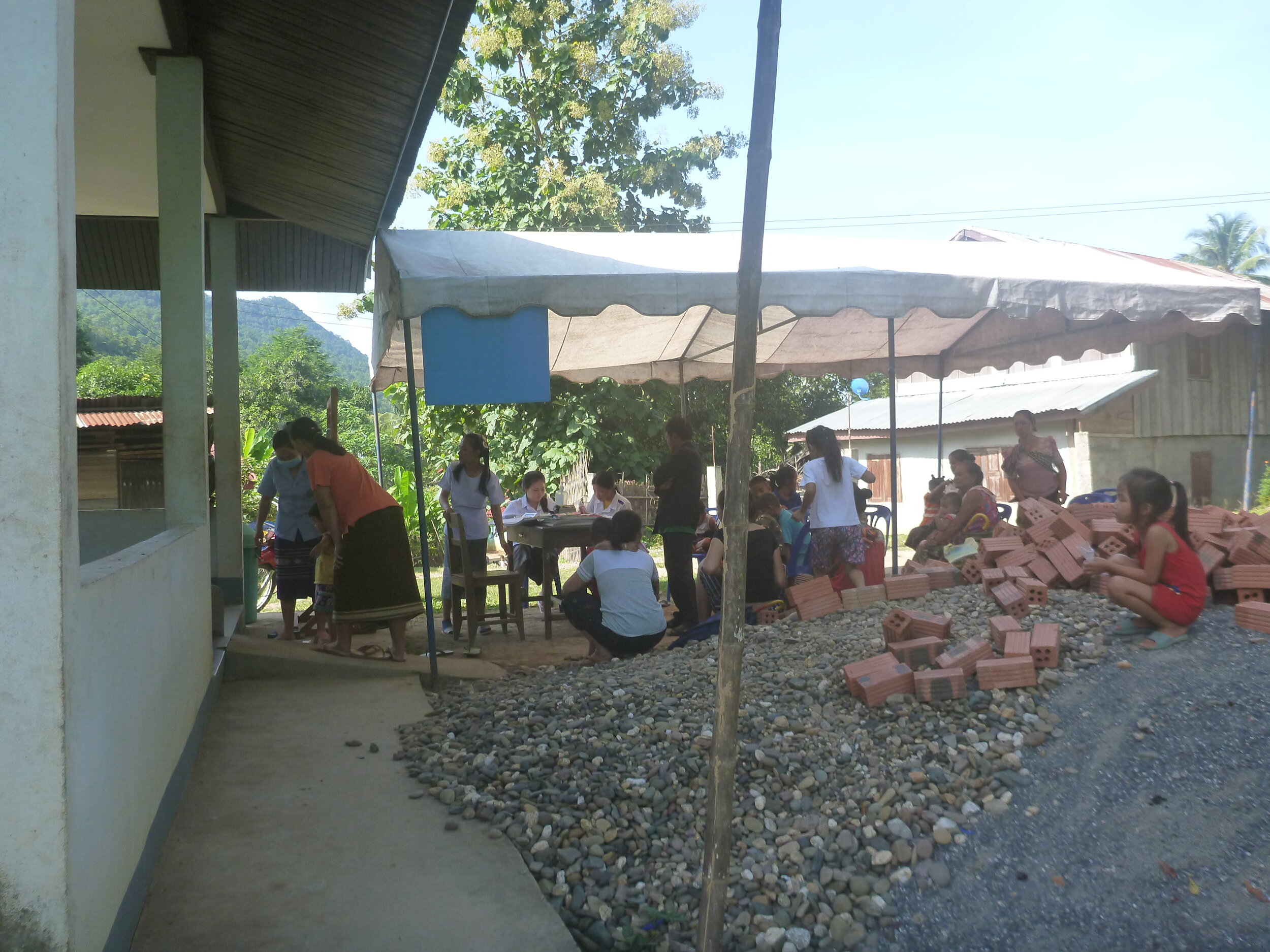
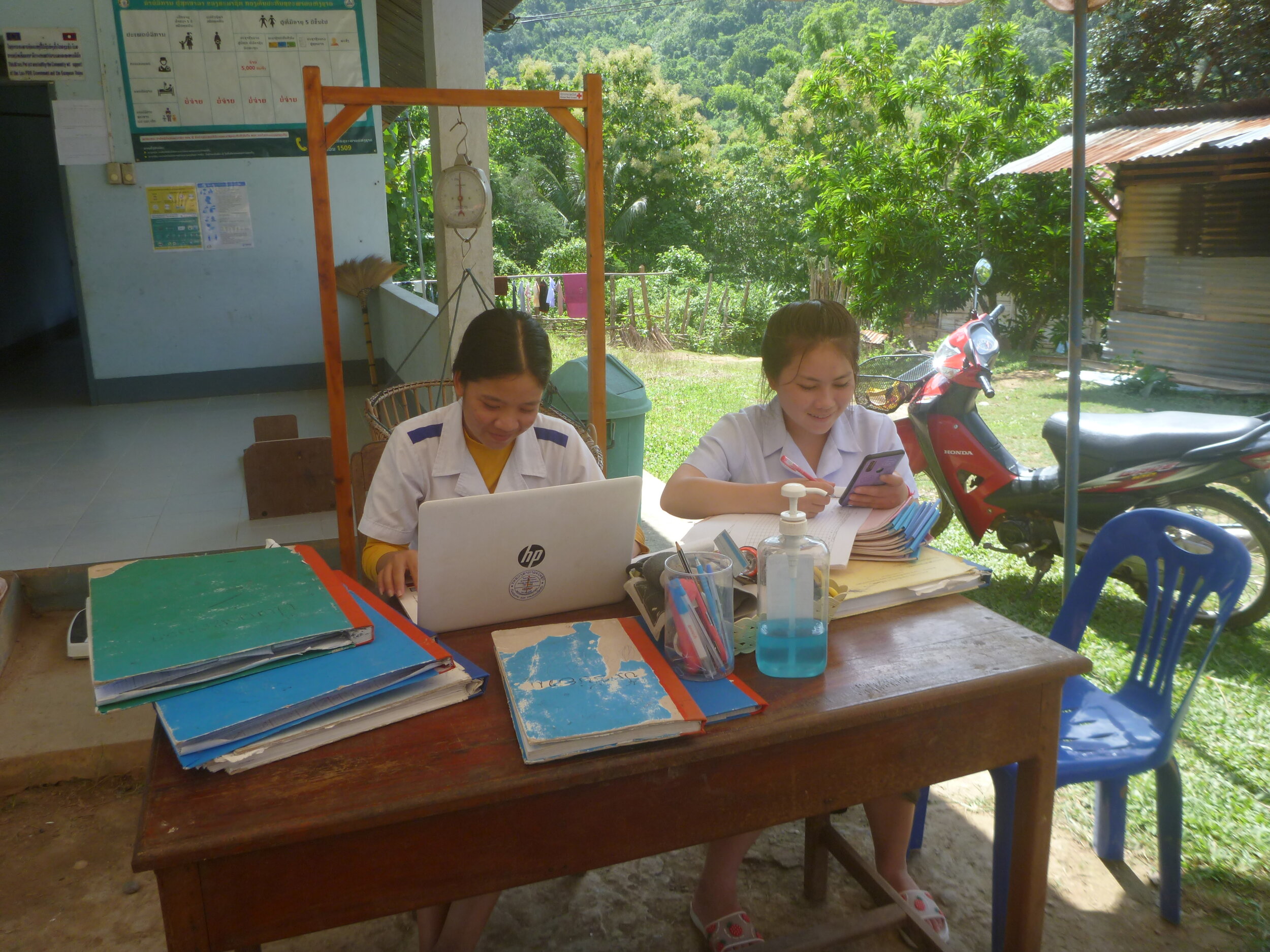
The PHD had notified us they would be carrying out a quarterly health check in the clinic at Ban Ngiew. 1 in 3 children under the age of 5 are chronically malnourished leading to both physical and developmental issues, and the PHD visits villages, to weigh and measure all the children in each village plus conduct education clinics on maternal, newborn and child health (MNCH). With many people attending the clinic, they invited us to conduct a cooking demonstration using buffalo milk.
Cooking Time
Milk has not been a large part of the diet in Laos or Southeast Asia generally. However, buffalo have been ploughing the rice fields and sold for meat for millennia. We met the Village Chief Mr. Khampheng, Mr. Heung and Mrs Pien, a teacher at the local school, who all attended training at Laos Buffalo Dairy in March, just before lockdown restrictions were implemented due to COVID-19. Five months later, they would now have the opportunity to demonstrate part of what they had learnt at the farm on how to cook and prepare the milk. Today Laos Buffalo Dairy (LBD) provided the milk, but soon it will be available in the village! The team decided to keep the recipe pretty simple and cook the milk with the purple rice, with just a pinch of salt and topped with chopped banana. Rice is a major component of the diet but is very limited in nutritional value.
First things first though, a fire had to be lit, bowls and spoons washed, and bananas sliced. We may have cheated a little to keep everyone happy during the clinic. Let’s say that not everyone was enjoying the chance to be weighed and measured. It can seem a little bit scary with so many new faces. However, with the Head Nurse’s permission ☺, a piece of delicious ricotta cake can be a welcome distraction and demonstrate other ways to use the milk.

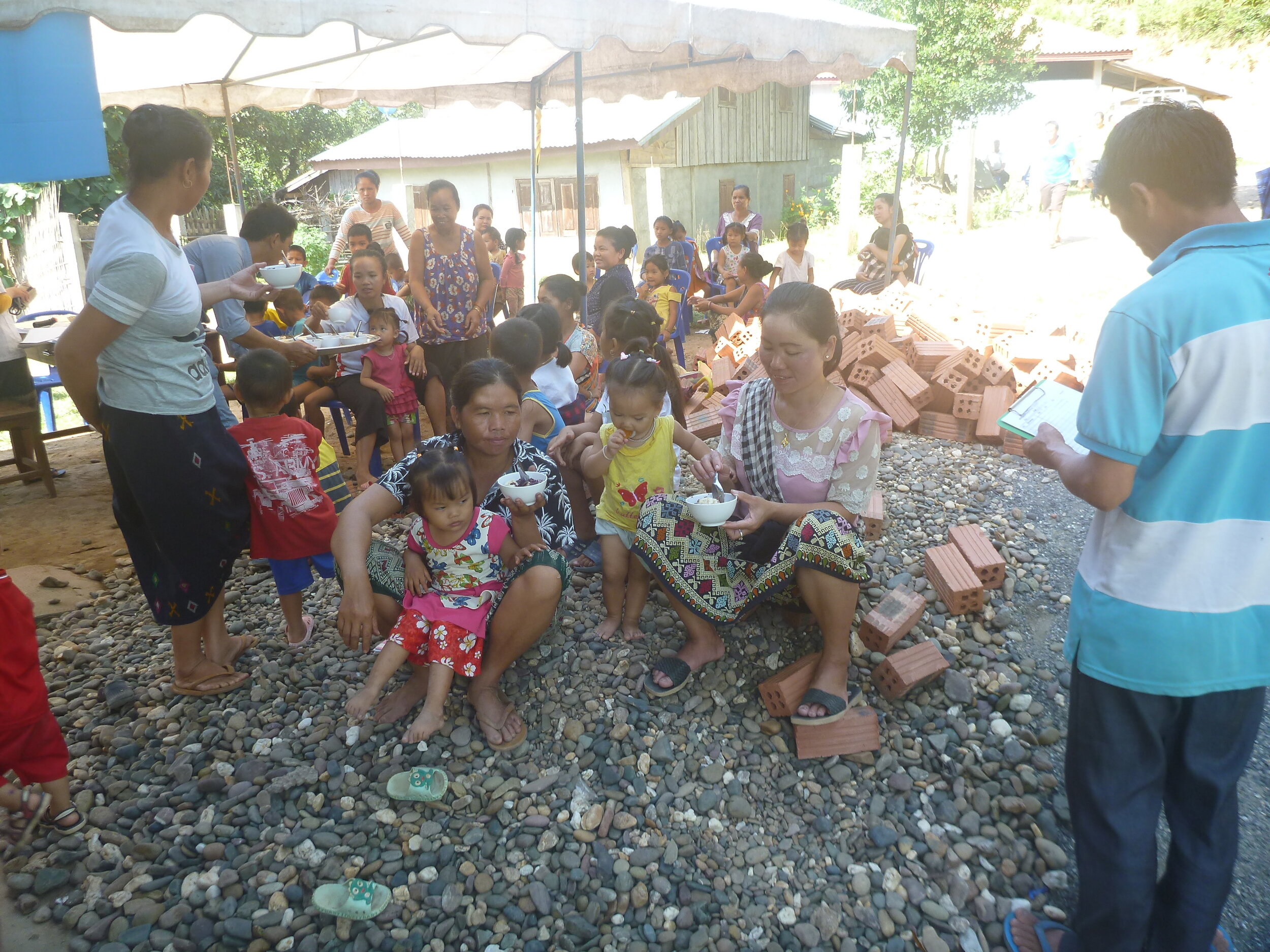
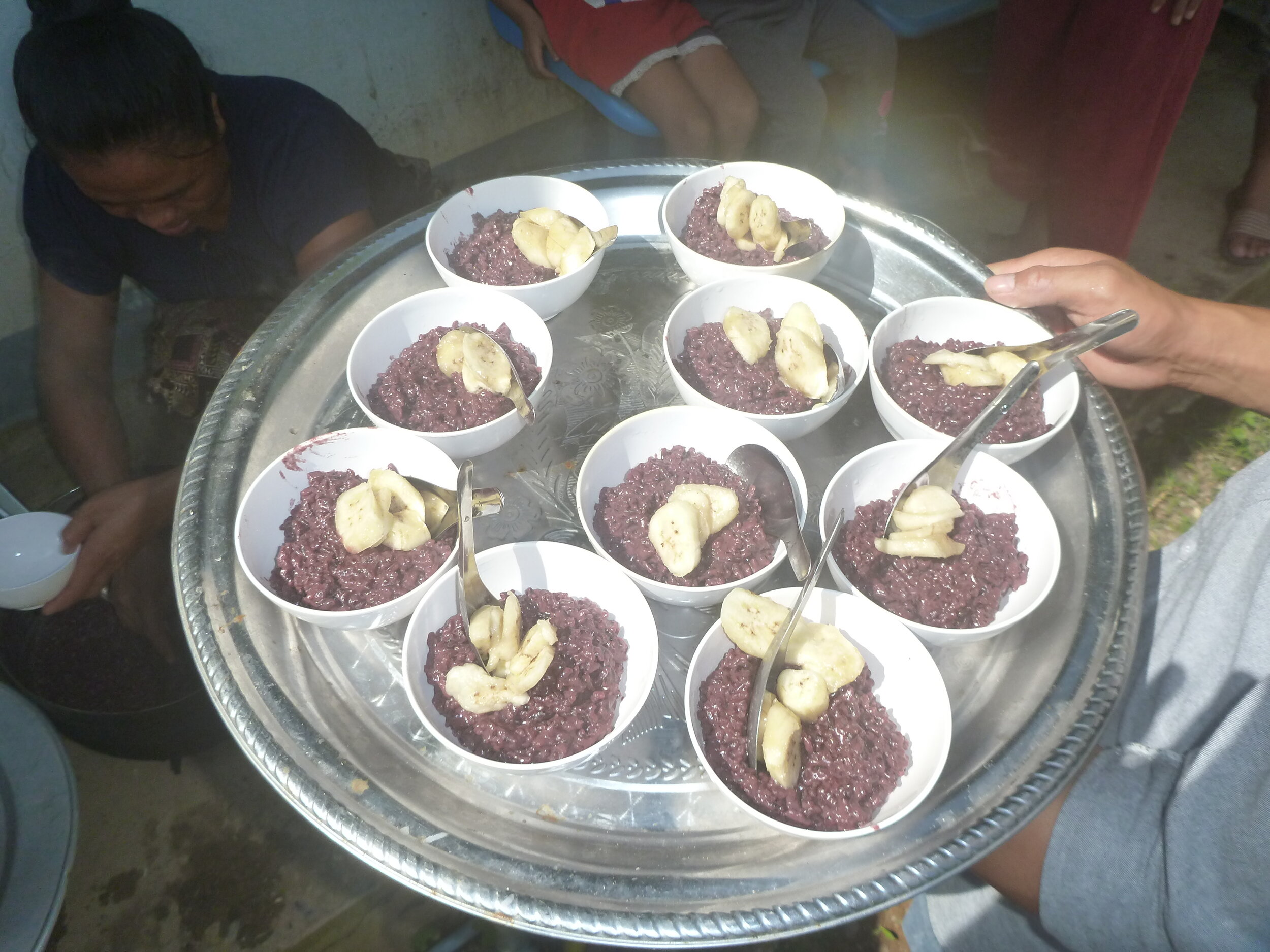
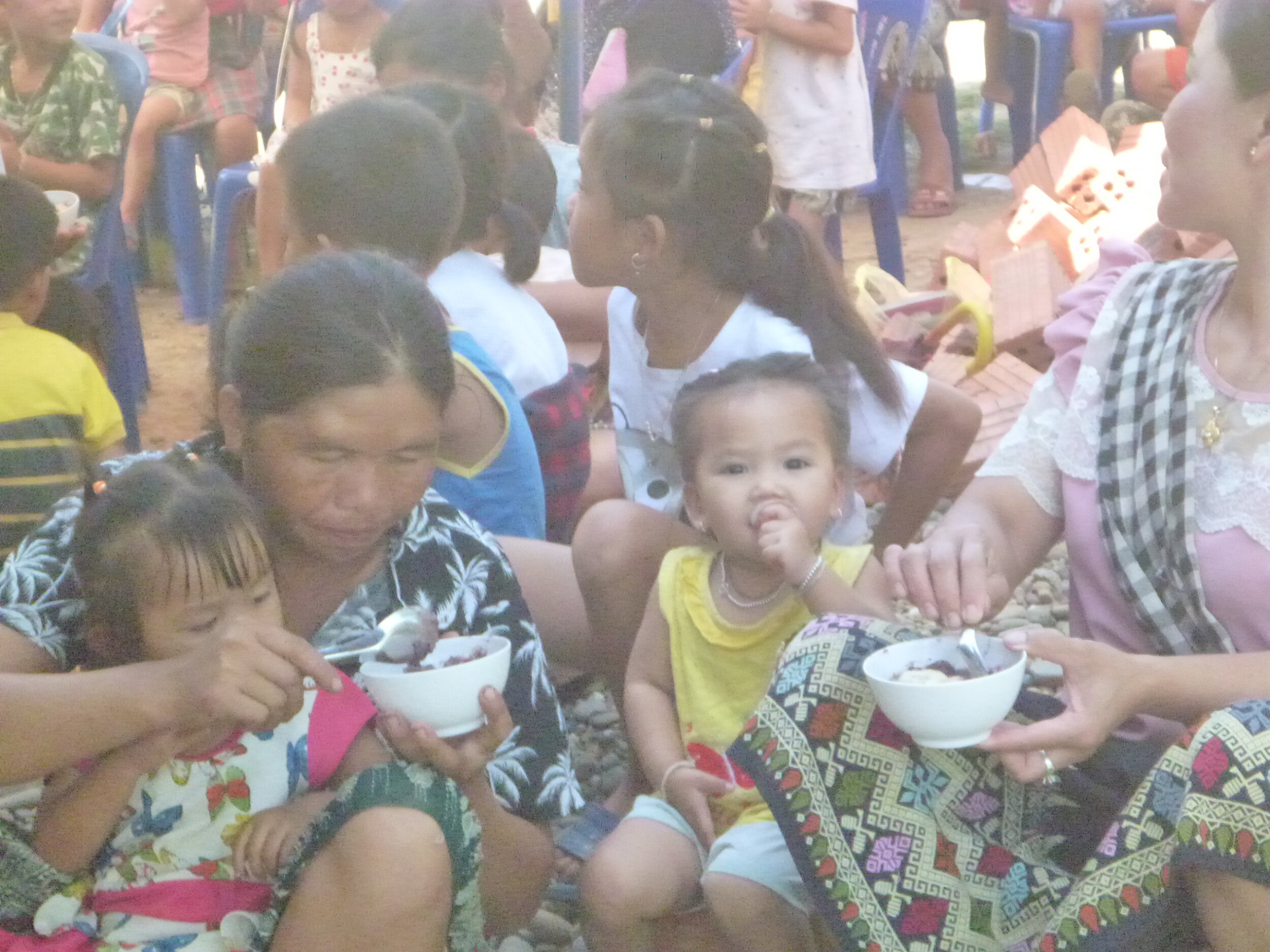
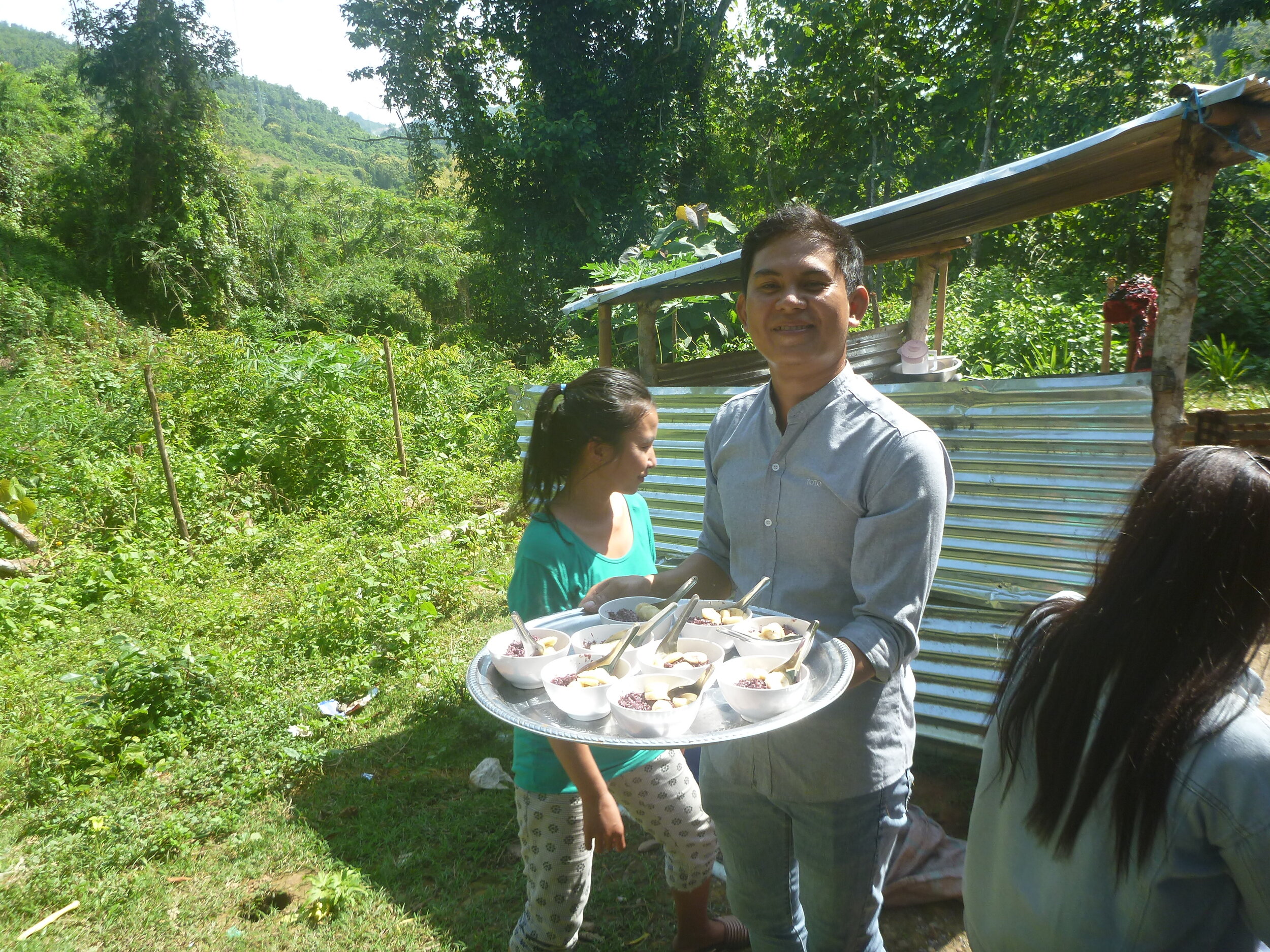
Once the rice was ready, out it went and after a few hesitant mouthfuls and mothers watching reactions, it all quickly disappeared! Plus seconds for many or take-away to any family and friends unable to attend.
Video Viewing
Any event, such as the Quarterly MNCH clinic, brings out quite a lot of participants and bystanders, all happily mingling and watching the proceedings. On the day there were 39 children with parents and 24 farmers in attendance.
While the rice was cooking and the children measured and weighed, it was a chance to show all the people two videos produced with the World Bank. The first video was to explain the benefits of milk and help dispel a few concerns. For instance, if someone is referred to as a buffalo as a jibe for being a bit slow, there was a niggle, that some people might think drinking buffalo milk may make you slow. We also needed to ensure that all milk collected was boiled correctly before being used. The second video was on some more of the technical components of raising buffalo covering a range of subjects such as breeding, feed, vaccinations and the process of milking.
Mineral Blocks
The video also spoke about mineral and medicated blocks for cattle. The blocks serve several purposes:
An easy way to distribute much needed additional vitamins and minerals particularly during the dry season
Reducing the incidence of liver fluke and;
Having the added benefit of reducing greenhouse gas emissions!

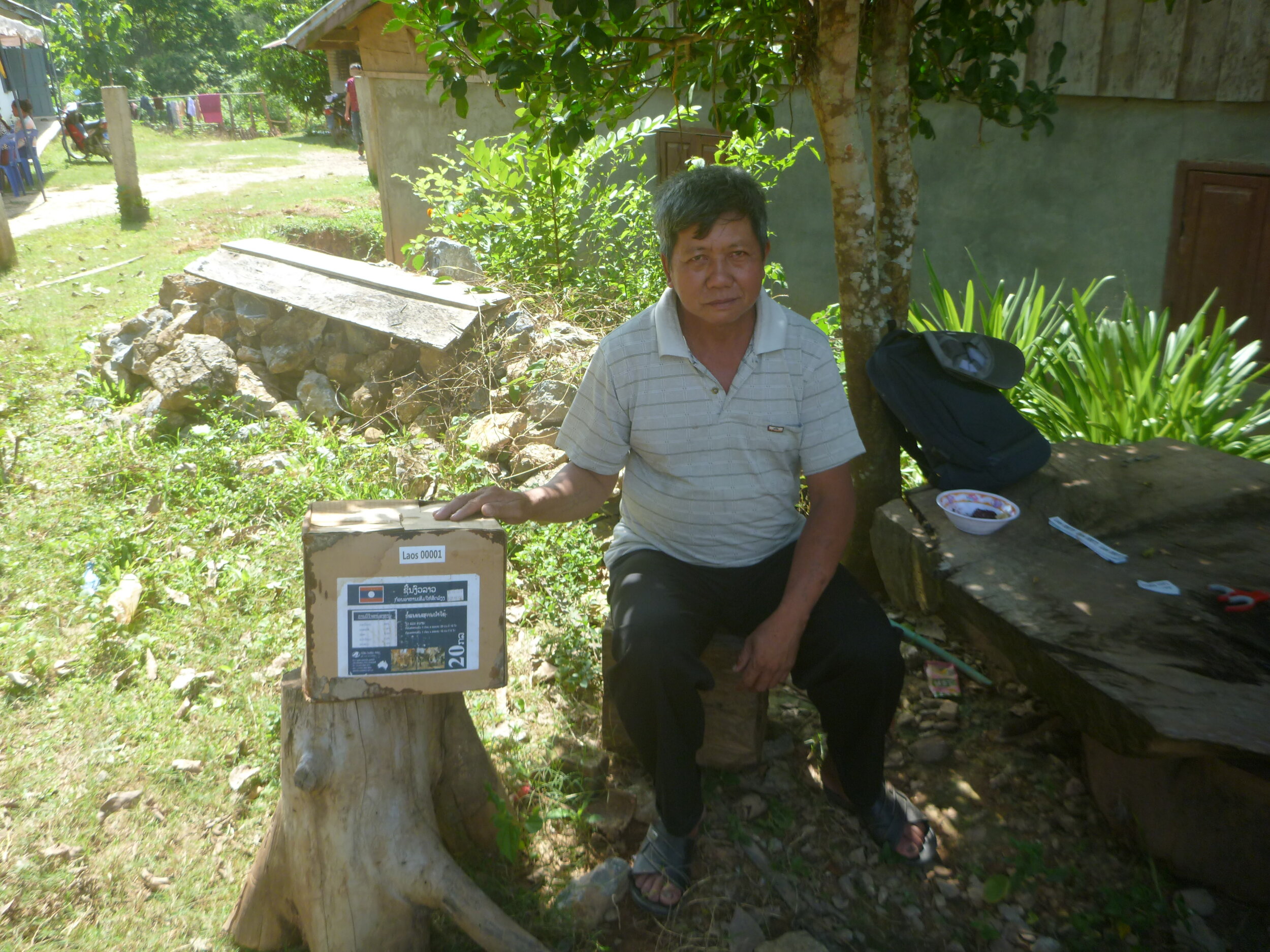
Each block weighs 20 kilos and will last one buffalo about three months. As part of a fantastic new business venture born from another BPP initiative, AgCoTech Laos will be producing and distributing mineral blocks for free to local farmers in exchange for carbon credits that they can sell to support the business. Many of the farmers had returned from a morning in the fields to attend the clinic. They were happy to receive mineral blocks for their animals. There is a protocol to follow to ensure that the blocks are all used by the recipients. So, there was a fun hour of taking photos and form filling with much good-natured laughter. This was the first time our team had completed the paperwork, and as the occasional person forgot their mobile number, they had to be reminded by friends and family.
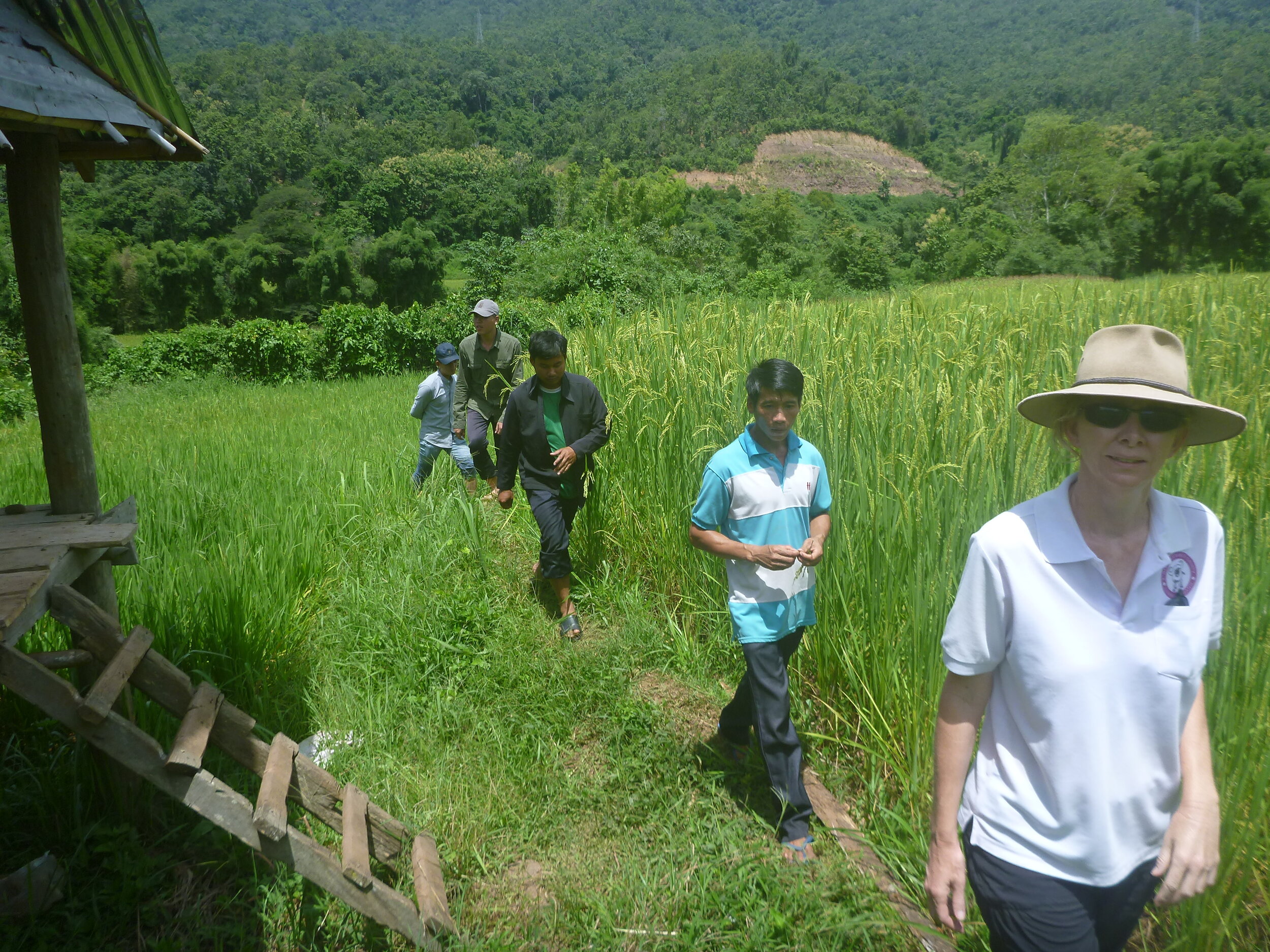
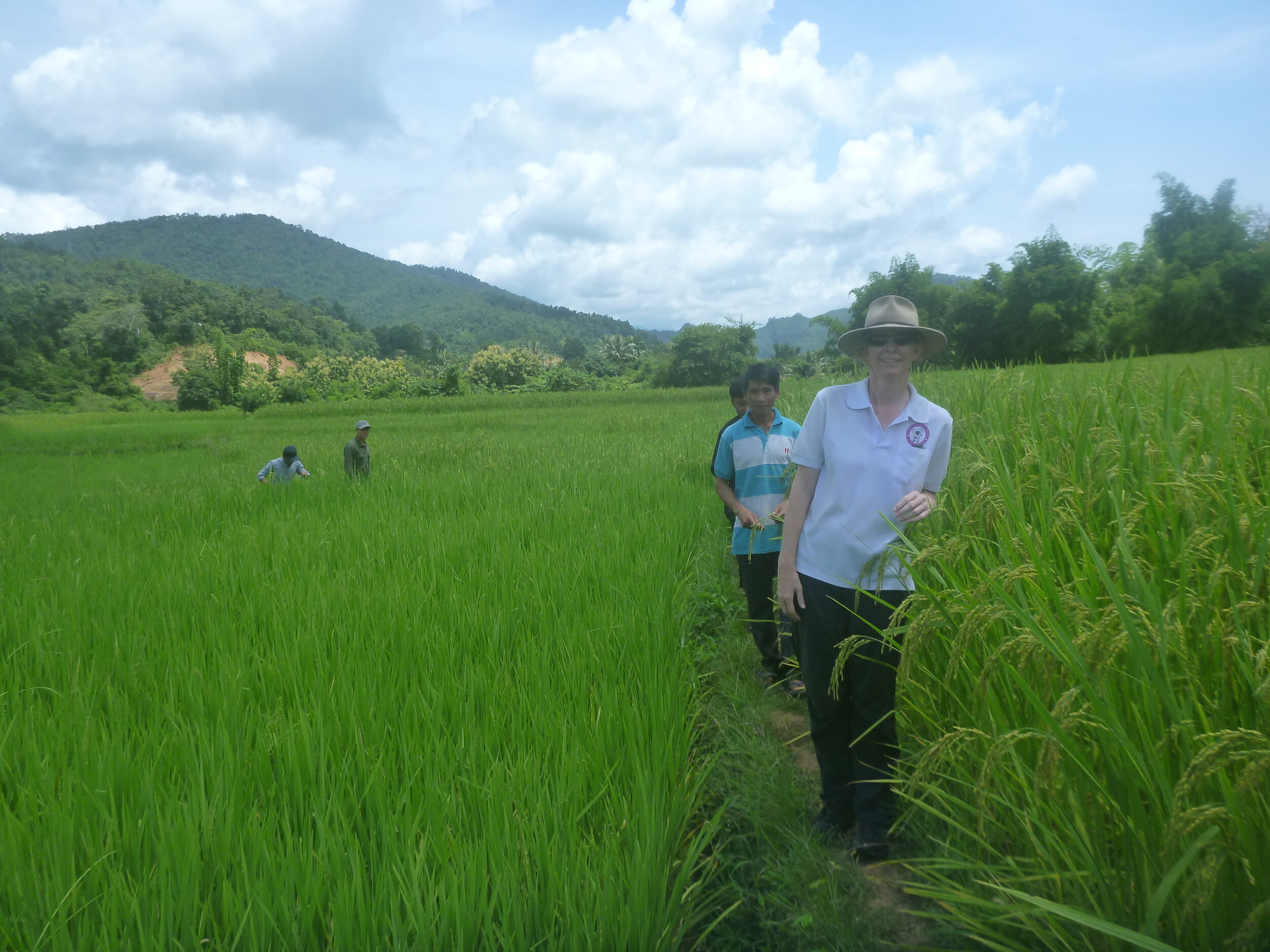
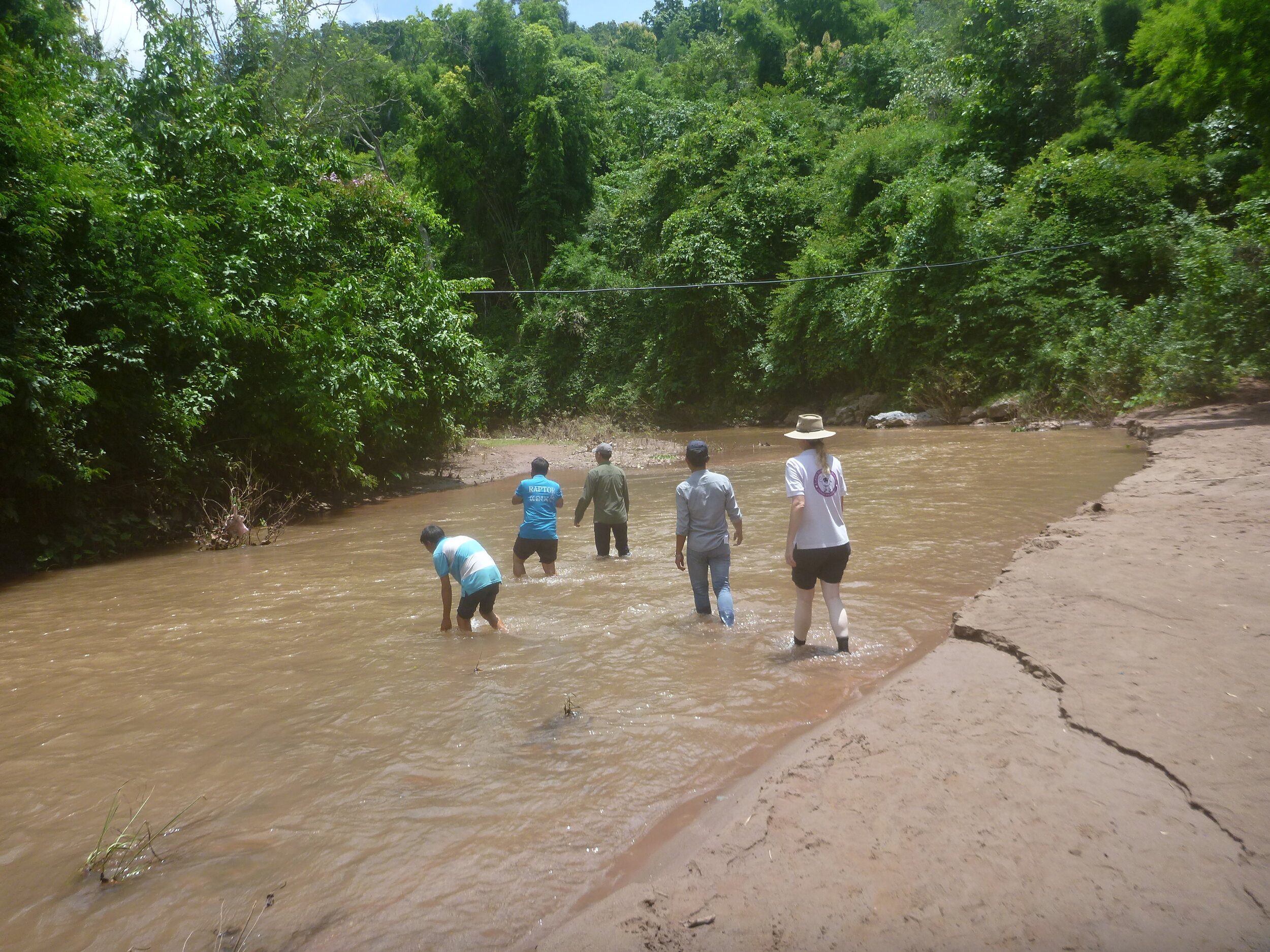
Milking Area
As the last mineral block disappeared into the fields by foot, bicycle or motorbike it was now time for us to walk to the other end of the village. The walk to reach the area, that has been fenced and planted with super Napier grass provided by LBD, was good exercise. At the same site, are ongoing preparations for the space to be used for milking. To get there meant first crossing the stream which due to the rain overnight was above my knees. I am reasonably tall, so for the Laos team it was more like thigh height, but no one blinked twice as this was the way to the rice fields where everyone goes every day plus the water was wonderfully cool, it was a shame we couldn’t stop for a swim! Then, through the rice fields to an area cleared, ready for construction to start. Honestly, the buffalo have the most scenic spot; rice paddies, rolling hills and a stream babbling in the background. There has been a bit of rain, and the Napier grass is coming along well. However, so are the weeds, so all the 25 families participating in the program will convene in a few days to cut them back. After the first harvest, the weeds won’t be as much of an issue.
More conversation followed on what building materials will be required and when to start building. The chief Mr. Khampeng proposes September is the best time as the rice will be harvested in October so everyone will be pretty busy. The timing all fits together well as in Laos there is a peak calving period with many buffalo being born in the dry season which starts in November.
With the dates and to-do list discussed, we headed back to the village and into the truck back to the farm.
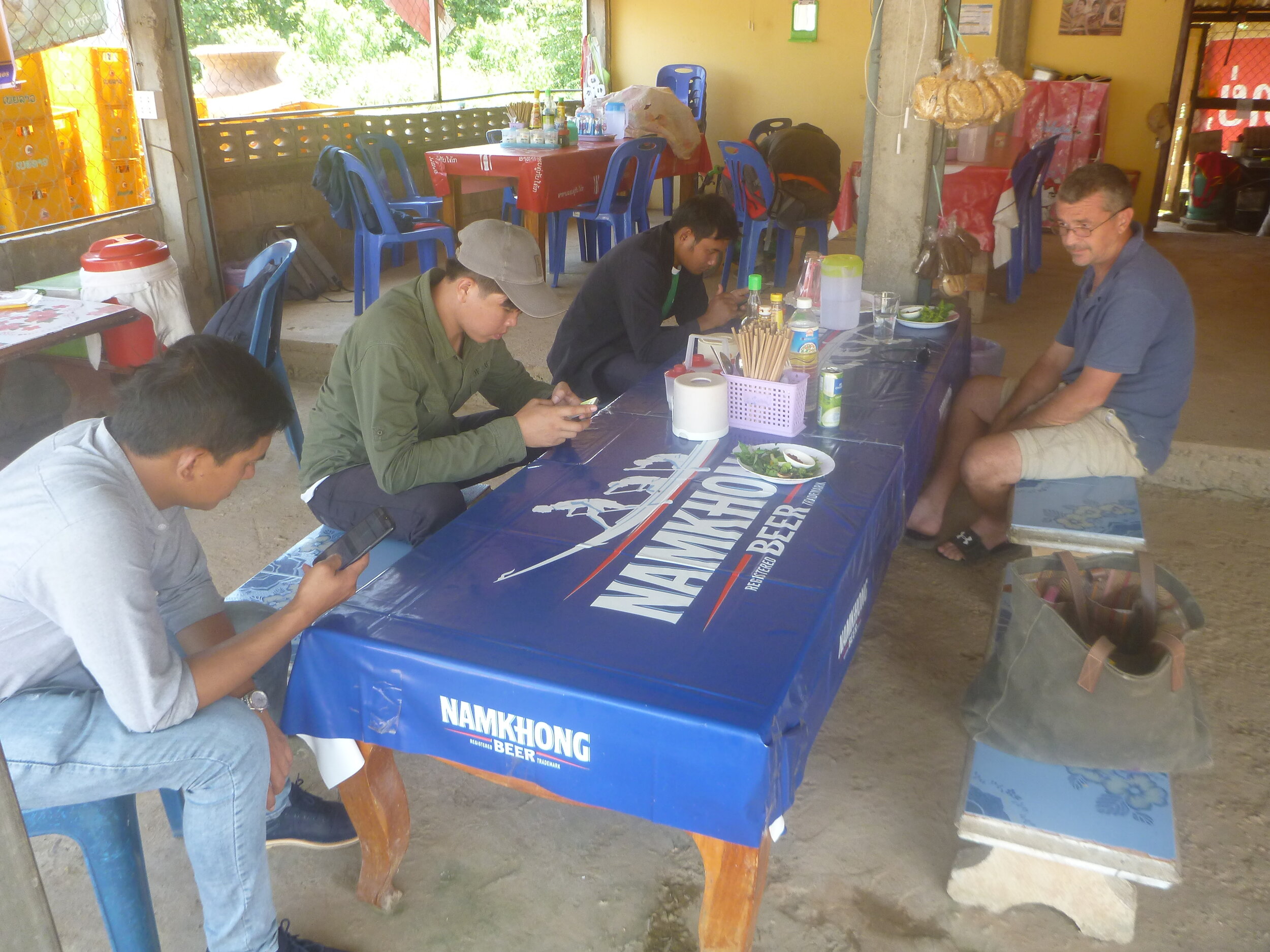

Late Lunch
After a full day of working and walking, everyone was ready for a late lunch at a little roadside restaurant near the ferry crossing, which is famous for having delicious pho, a local soup. Everyone tucked in and as usual, Songkham puts in too much chilli and is happily crying as he eats his hot hot soup as the temperature registers at 41 degrees celsius. Of course, once back in range for a mobile everyone has a soup spoon in one hand and mobile phone in the other. Some things are the same the world over!
Buffalo Spas, nose rubs and selfies: Life on the farm for a buffalo!!
We are proud of the care we provide for the buffalo who stay with us here on the farm. So, this week we have done something a little different and bring you a blog post about how we imagine one of our buffalo experiences living on the farm! We hope you enjoy this unusual perspective as you discover some in-depth insight into our work and gain a unique behind the scenes look at Laos Buffalo Dairy.
We are proud of the care we provide for the buffalo who stay with us here on the farm. So, this week we have done something a little different and bring you a blog post about how we imagine one of our buffalo experiences living on the farm! We hope you enjoy this unusual perspective as you discover some in-depth insight into our work and gain a unique behind the scenes look at Laos Buffalo Dairy.
Wake up: After sleeping safe and sound, I’m excited to take you around my ‘home’ today. Never thought it would be the buffalo taking you on a tour, hey! As it is my first tour, be gentle. It is going to be full of fun!!
Breakfast: Hmm food. That telltale sound of boots against concrete signals breakfast is on its way. Excuse me while I tuck into a bucket (or two) of Napier grass with rice bran and corn. It is delicious and nutritious. I also receive a rub on the top of my head, and I like that too!
Morning milking: Next we head off to be milked. All the milking buffalo walk to the milking area and we stand while the milk is collected. The milking team are all very gentle and take care so I don’t feel any discomfort. Our delicious milk is used to make the dairy’s delicious products of cheese and ice cream. Only some of my milk is taken, the rest is for my calf to suckle to grow big and strong. My calf watches on curiously, and one day maybe she’ll give milk too.
Going for a graze in the fields: It’s time now to go and enjoy some natural grazing in the fields surrounding the dairy. Grazing is one of the highlights of the day! Before we came to the dairy, we were left to wander around to find food and sometimes worked in the fields. Here, we are only tied up to eat so we share nicely, and we go for a graze every morning. There is space for the calves to play in the fields. The team here keep an eye on us and make sure nothing untoward happens to us. Well, that’s enough of me talking, I gotta eat eat eat! I need about 30 kilos of food every day, and that takes a lot of eating!
Coming back to the shed: Standing together in the sun all day is not good for us. So, the staff take care of us and cajole us with familiar sounds and actions to head us back home. We sometimes look a bit clumsy walking together and occasionally we try and stray off, however, our caring staff notice and guide us back together. There’s a new calf walking with us today, sooooo cute! New calves are born here on a regular basis and bring some playfulness to our days.
My calf is with me all day: Animal welfare is top notch on the farm. I feel grateful to be staying here, as on some other farms I would be separated from my calf! I’m so glad they don’t do that here, I love watching her grow big and strong.
Going out to the mini farm: I love my role in helping to educate the visitors about the farm. The exciting part of the day is when my calf and I meet visitors from all over the world. Lately, though, there are way fewer visitors coming. We miss you! I hope you can come back soon.
Tourist milking demonstration: As today we have visitors, it is time for a hands-on fun experience. I watch as the team teaches the people how to milk me! Visitors are usually concerned they are going to hurt me; I wish I could speak and reassure them that it doesn’t hurt at all and to give it a try! Have you seen how my baby drinks milk?? Some turn out to be very good at milking. The milk from buffalo is highly nutritious for children!
Shower/wash: One of my favourite parts of the ‘Buffalo Spa’ here is the shower and wash!! First, the visitors pour water all over me and my calf. It feels so good because sometimes my skin gets dry and this helps to take care of that. Then, they brush my skin, which is a great feeling. As the star attraction, visitors always want selfies with me. So, I always strike a pose for them, and they capture a lovely memory.
Hand feeding by tourists: If washing and brushing and selfies are not enough: there is also time for feeding. I love this part, as I am fed my favourite food and happily chew while they take more photos. If I am feeling playful, I like to tug the food a little bit and pull people slightly off-balance. It always makes them laugh!
Lunch: And I am still hungry, and there is room for me to eat more! I eat a lot. Where I stayed before we did not receive enough food, I think, because it costs such a lot of money.
Relax in the water: Another part of the ‘Buffalo Spa’, the water, is my happy place! My skin gets hot and dry in the sun, and lying here the water is cool and soothing.
Nails : Once a month the ‘Buffalo Spa’ does my nails! This never happened where I lived before, and it helps so much because my feet start to hurt if my nails get too long. So much care and I get my nose rubbed at the same time - cute!
Afternoon nap: Hmm, it’s natural for buffalo to take an afternoon nap, so although it’s great telling you about my day, it’s time to sleep. Some buffalo work all day, but here there is the chance for me and my calf to curl up and sleep in the afternoons. See you in a few….zzzzzzz.
Watching the humans: Ah, hello again! I’m rested, feeling fantastic and ready to continue. The staff who work here take great care of us. And they can do that because they go away, sometimes to Thailand, for extra training. So, the people learn everything they need to look after us.
Watching evening milking: There are different breeds of buffalo on the farm. I know this because some buffalo go for milking twice a day; morning and evening. These buffalo look different to me, and are darker and bigger and their horns are different. These buffalo produce more milk than me. Sometimes the staff breed both types of buffalo together to make a bigger and stronger buffalo. I have a friend called Sofia, and she is a mix of my kind of swamp buffalo and the other breed of buffalo. These mixed breeds provide more milk which can be given to the children in Laos and help them get bigger and stronger!
See Susie walk the farm: There are so many ‘characters’ that make this dairy farm so special. Here comes one now! This person is the boss and she walks the farm every day at this time. As she walks, she is continually observing, noticing, asking questions and making sure everything is ok. If one of the other buffalo or I am sick, or we aren’t being looked after perfectly, she makes it better for us! We are all thankful.
Dinner: And now it is time for more food. I’m not quite full yet. I told you I eat a lot. I never get full! Dinner for me is a whole bucket of nutritious feed, and my calf takes all the milk she needs, while I eat.
Sleep: Oh, it is time for sleep. I hope you now understand how although the dairy farm looks simple from the outside, that it is quite complicated to run behind the scenes.
Thank you for following a day in the life of a buffalo today. I enjoyed your company, and I think you can see why I enjoy living here. I look forward to seeing you all on another visit to the dairy soon.
Mooo-ving update
We'd like to announce that in the early morning of 31 August 2020, the first of the 2 cow calves, that we have been waiting for, was born! He was born weighing in at 16kg. That's small compared to the buffalo who have been living on our farm and have a longer history of better nutrition that babies are now starting to weigh in between 25 - 35+KG! Cows here are generally smaller than the buffalo to start with, but that doesn't make them any less cute!
We are very excited for her/him to join our farm, as now we can find out how much milk mum will give. This information will help us with our nutrition program in conjunction with BPP and World Bank.
Did you hear?
We've partnered with Laos Airlines for their exclusive boarding pass privileges. Show us your boarding pass at Laos Buffalo Dairy within 3 days of flying and get a free dessert teaser of ricotta cake with caramel drizzle.
TOURISM IN NEED
COVID-19 has badly affected tourism and visits to the farm. In order to mitigate some of the effects of the loss of income this has meant for the dairy, we have teamed up with the Tourism in Need initiative that supports responsible tourism organizations affected by the pandemic. Through this initiative, travelers can support the dairy through the Give Today, Go Tomorrow fundraising scheme. Click here to find out more and to make a contribution to help us to pay farmers and team members, and continue to train farmers and work on our nutrition program.
Lao students become teachers!
On our farm, we run a free English programme for local students. They can come here Tuesday to Friday to study English with our native English speaking teacher. We wanted all our team and their children to have the opportunity to learn English, and now we have 50 students coming to the farm every day to study.
In Laos, learning English can be an avenue to a better future. It can lift children out of their village experience and into higher-paying jobs in the city. However, for students outside of the big cities it can be almost impossible to study English because village schools can only offer 4 hours of English study per week. The classes are often taught by teachers who themselves have a low level of English skills. The free classes at our farm allow students to study and expand their English levels.
Two of our students made us especially proud recently, as they taught their first class! So how did they go from being students to teachers? We recently started a brand new lesson for students from the local villages who can speak no English. The idea was to create a clean slate post-Covid lockdown and restart the curriculum to give more opportunities for learning than ever before. This beginner’s class quickly grew from 2 to 20 children in a matter of days as word spread.
On the third day of teaching the class, Tom, our on-site English teacher, invited one of our more advanced students, Phoukham, to help teach the lesson. From the off, he thrived as a teacher being eloquent, patient and showing his excellent grasp of English. So, we had an idea. Let him teach!
Partnership
To help build teaching skills, we partnered him with another of our students. Together we taught them how to plan lessons and how best to teach in front of a class. They learnt quickly, and after a few days they were ready to go.
Seeing them stand in front of the class was a real pleasure. Tom has taught those two students for two years, since they were 14 years old, and watched them grow not only in their grasp of the English language but also as young men. These new teaching responsibilities would have been too much for them two years ago, but they have now matured into thoughtful adults who can help younger students in their villages.
It is fantastic!
It is fantastic to have them teaching for numerous reasons, but none more so than the brilliant role models they have now become for the other kids in their village! For them to stand at the front of the class speaking English, to such a high level, gives all those young students aspirations to do the same. It shows everyone that even a non-native speaker of English can attain a high level of English skills.
For the students to see people from their village work hard and achieve their goals and learn English is incredibly motivating and feeds the desire to learn. Some students may even be inspired to go on to become teachers.
Well done to all of our students on the farm. And a big Thank You! to Phoukham and John for their dedication and motivation as both students and teachers.
Mekong Experience Showcase 2020
In case you missed our post on Tuesday, we’re thrilled to announce that Laos Buffalo Dairy is the winner of the Experience Mekong Showcases 2020 for Laos - we are incredibly proud of our fantastic team! It was already a wonderful achievement for us to have been nominated, alongside the other amazing finalists as a responsible travel business that creates a significant social impact and provides authentically local experiences. To win is - WOW! Thank you to all our supporters and friends who voted for us. We are so happy to know how much you care!
TOURISM IN NEED
COVID-19 has badly affected tourism and visits to the farm. In order to mitigate some of the effects of the loss of income this has meant for the dairy, we have teamed up with the Tourism in Need initiative that supports responsible tourism organizations affected by the pandemic. Through this initiative, travelers can support the dairy through the Give Today, Go Tomorrow fundraising scheme. Click here to find out more and to make a contribution to help us to pay farmers and team members, and continue to train farmers and work on our nutrition program.
Meet 2 of our wonderful team members!
Somchit & Nin - husband and wife team members.
We talk a lot in our blogs about the work we do with the local community here in Laos, but this week our story is much closer to home. This time, we wanted to share some exciting news about Nin and Somchit who are a husband and wife working with us here at the dairy. Somchit is our Deputy Farm Manager, and Nin works tirelessly every day taking care of our buffalo, including being a talented administer of vaccinations. They have a 3-year old son, who lives with Nin’s parents in Luang Prabang, who they go and visit every Wednesday on their day off. When speaking with each of them, it is clear that what drives their dedication, motivation and hard work at the farm is a desire to support their son and give him opportunities in life that they didn’t have.
Nin and Somchit met while studying at high school and continued studying together at the Northern Agriculture and Forestry College, where they learnt the skills needed to work on our farm. In Laos, after having a baby, it is usual for the mother to stay at home and look after the child while the father goes to work. For the Laos women staying at home, this usually has the effect of ending their career prospects. However, Nin is different and hasn’t followed the crowd in this case. Being a smart couple, they saw the opportunity that both of them going to work, collecting two salaries and achieving a higher economic standing would mean for their family’s future.
The years of hard work paid off last month when Nin and Somchit invested in three buffalo on our farm: one mum aged 9 years old and two of her calves, aged almost 2 years and 4 months, now have two proud new owners. We know Nin and Somchit are looking to save as much money as they can for their son’s future. So, why decide to invest their hard-earned money in three buffalo on our farm? Here are the reasons they invested:
Buffalo Care - On our farm, we provide the highest level of care for buffalo in all of Laos. We have a team of experts, many of whom have received expert training to enhance their skills further both here in Laos and Thailand.
We feed our buffalo approximately 30 kilos of food every day, they are never tied up, and the mum and the baby can spend all day together. Our buffalo go out to pasture every morning, and we even do their nails once a month! We are; part buffalo dairy, part buffalo spa.
Buffalo Health - Any buffalo that stay on our farm spend one month in quarantine, where they are tested and vaccinated against all the most common diseases here in Laos. We keep strict records for our buffalo so we know when they are due for more vaccinations. We also keep track of dads; buffalo on our farm that leave pregnant have records of who the expectant father is so we can help to avoid the inbreeding that has long been a problem here in Laos. Buffalo are checked for pregnancy and closely monitored for any abnormalities that could cause them problems in the future.
Buffalo rental - The core of our business model is to rent buffalo from local farmers, providing them with a brand new source of income. In this case, those local farmers are Nin and Somchit. While their buffalo are on the farm, we are paying to feed, care for and milk them. The buffalo stay with us because their home village is too far away. Eventually, the sale of the male buffalo will provide extra income, which supports their family’s future.
Nin and Somchit saw an opportunity by investing in our farm, and they’ve worked here long enough to understand the importance of the work we do for the local community. They know that the female buffalo they bought will be strong and healthy and that her two calves will have the best chance to reach adulthood. In the villages, 45% of calves die in their first six months, while on our farm the figure is less than 5%. Calves on our farm are much more likely to be strong and healthy compared to those in the villages. The investment Nin and Somchit have made means that when their son is older and wants to go to school, Nin and Somchit will have at least three, if not more, fully grown healthy buffalo. They can sell one of these to support their son’s education.
We are incredibly proud of how hard Nin and Somchit have worked to get where they are today, and for the trust put in our farm as a way to invest in their family’s future.
Mekong Experience Showcase
Saturday was the final day of voting for the Mekong Collective 2020. We want to say a big THANK YOU to everyone who voted for our farm! The whole team appreciates that during these difficult times, you took the time to support us here at the dairy. Watch out for our update about the results!
Almost 10,000 people voted! The winners will be announced live at the Virtual Destination Mekong Summit on 25 August.
If you would like to participate in this, you can register for free at https://www.destinationmekong.com/dms2020/. You can learn all about the Mekong Tourism COVID updates and see about the future of tourism here in SouthEast Asia.
TOURISM IN NEED
COVID-19 has badly affected tourism and visits to the farm. In order to mitigate some of the effects of the loss of income this has meant for the dairy, we have teamed up with the Tourism in Need initiative that supports responsible tourism organizations affected by the pandemic. Through this initiative, travelers can support the dairy through the Give Today, Go Tomorrow fundraising scheme. Click here to find out more and to make a contribution to help us to pay farmers and team members, and continue to train farmers and work on our nutrition program.
Welcoming Our Cows
Our dairy welcomed some new friends last month, as our first cows joined us and are settling in nicely to their new home. The cows are a Yellow Asian Cow and are common in villages right across Laos.
We had been planning to expand to include cows in our nutrition programme for a while now, so Rabbi Sholom, kindly donating two cows to the farm was perfect. For Rabbi Sholom, this was also an opportunity to have fresh milk for his family that he knew and trusted to be Kosher. The Rabbi also knows this farm is a safe place for the cows to live, as we have an expert team to care for, feed and vaccinate the animals. The cows will receive 24/7 care!
Similarly to buffalo, farmers don’t usually milk cows in Laos. Farmers tend to raise them for meat. So, right now we don’t know how much milk a Yellow Asian Cow can produce - our best guess is about 2 litres, whereas a dairy cow in Europe or the US produces 30-70 litres every day. Although not a huge amount, it can be invaluable additional nutrition for a family who cannot provide regular nutritious meals for their children. Farmers, who attend our nutrition programme, learn how to milk their cows and then cook their sticky rice in the milk to add in nutrition to these meals. It makes sense to use resources the farmers already have as it provides a sustainable way forward!
The World Bank nutrition programme has been planning to expand into cows. The Rabbi’s kind donation has given us a head start as we can now monitor and test the milk production and plan how to develop the project over time.
Currently, we only work with farmers who own buffalo, providing them with a new income stream and teaching them about how to look after their animals. However, along with the World Bank, we want to help even more farmers. So a natural thought was, what about cows? Farmers who own cows in Laos are traditionally not as wealthy as those who own buffalo. Cows cost about half the price and are smaller in size, which means when they sell the meat, they receive less income.
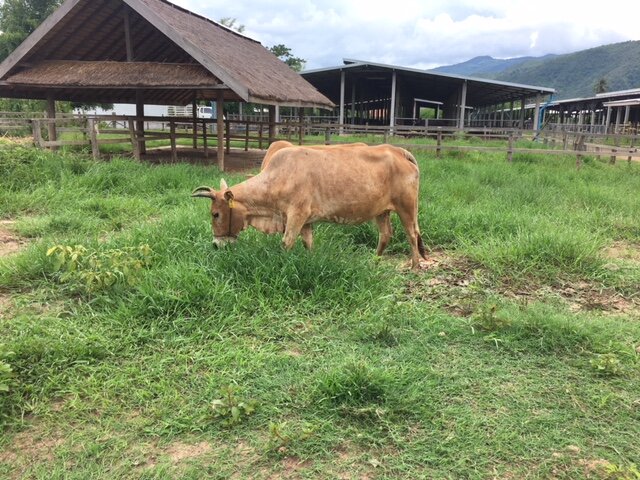
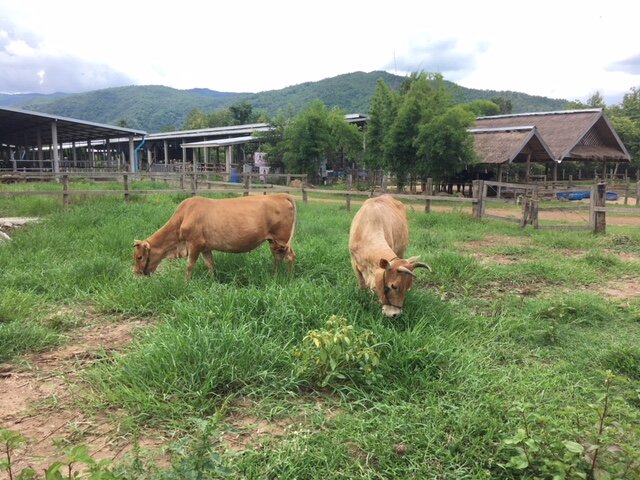
How we can help farmers investing in cows
At the moment, due to the impacts of COVID-19, we are seeing more and more villagers investing in cows. The jobs many people relied on in Luang Prabang have now dried up, and many people have moved back to their villages. The money they were once saving up to buy land in the cities they are investing in livestock and in particular, cows.
The concern is that a large number of people are investing their hard-earned savings in cows, with little or no agricultural experience. There is an opportunity here for the farm to offer training that helps these farmers make the best of their investment. For examples, something as simple as a worming tablet, which costs 8000 Kip or about 80 cents, can increase the life expectancy of a cow. As with buffalo, we are using an asset a farmer currently has and helping them learn how to take better care of it.
In the future, we also plan to explore the potential benefits of goats because the poorest farmers in Laos will have goats. Stay tuned as a future blog will highlight the arrival of the goats at our dairy and cute pics of the kids are sure to follow!
So we say a big Thank You! to Rabbi Sholom. His kind donation has helped kick start this next stage of development for our work here in Laos.
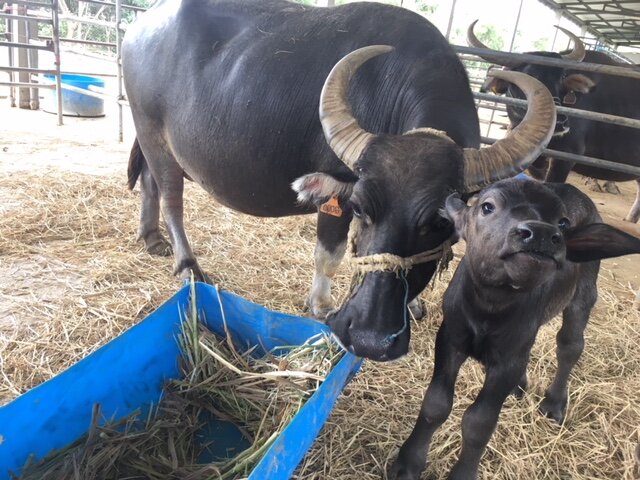
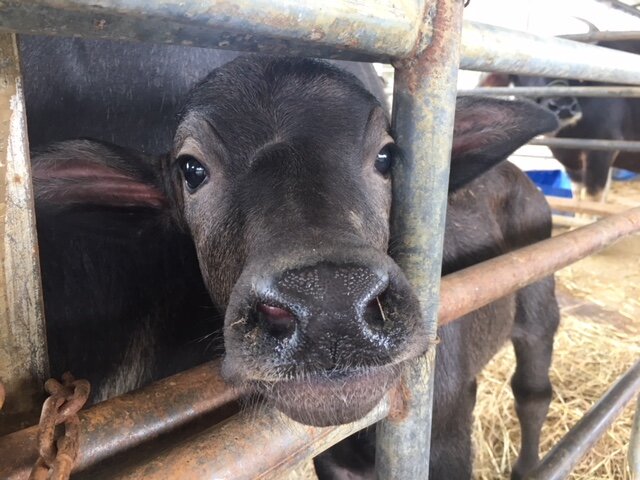


Did you hear our news??
Lola, our show girl, had her beautiful baby!! This little guy was born on the evening of Saturday, 8 August. We joke and say little, but…..he was a whopping 39 kilo!!! That’s big for a buffalo. On our farm, in the beginning, swamp babies were about 20 or less kilo when they were born. Now they are more likely to be 25+ kilo, thanks to the better health and nutrition here at our farm.
This new baby is a cross breed - Swamp and Murrah. We need your help to name him! He needs an “L” boys name to go along with his mum, Lola, and big sister, Lisa. Comment with your suggestions!
2020 MEKONG EXPERIENCE SHOWCASES FINALIST
Only 3 days left to vote!!
In case you missed this fantastic announcement last time, we are one of the finalists in the 2020 Mekong Experience Showcases. According to the members of the Mekong Tourism Advisory Group, we fit the bill for 3 main principles:
To make a significant social impact in our community.
To provide an authentic local experience for tourism.
To have an innovative and sustainable concept in our business model.
We are so excited to have been singled out as one of the responsible small businesses to do this. But, it isn't over quite yet! There is still another round of voting to go through.
From 7 July to 15 August we are asking that you please go to http://www.destinationmekong.com/ems2020/ and vote for us. The winner will be announced on 25 August 2020.
TOURISM IN NEED
COVID-19 has badly affected tourism and visits to the farm. In order to mitigate some of the effects of the loss of income this has meant for the dairy, we have teamed up with the Tourism in Need initiative that supports responsible tourism organizations affected by the pandemic. Through this initiative, travellers can support the dairy through the Give Today, Go Tomorrow fundraising scheme. Click here to find out more and to make a contribution to help us to pay farmers and staff, and continue to train farmers and work on our nutrition program.
Partnering for Nutritional Health
Two common questions from some visitors to our farm, before they take a look around, is why would I want to look around a buffalo farm? What’s the point? Well, when they take a tour and hear about our story, they realise we are so much more than simply a buffalo dairy! They understand that we work with the local community to educate local farmers about their animals; we educate about vaccinations, animal husbandry, animal care, and we also teach English to local children for free!
In the beginning….
In December 2018, we were approached by the American/Laos Nutrition Institute in Vientiane to make protein powder for the doctors at the hospitals to give to their patients. Approximately 44% of Laos children are chronically malnourished before the age of 2 years. At that time, we said we would be happy to do what we could but that we didn't have the funds to buy any additional equipment to make the powder. Through conversations, we started working to see what it was that we could do to make this happen. From their end, the Institute needed to find a grad student and the funding needed to test the nutritional composition of our milk and to help progress the project. Well, it would clearly take quite a while to make this happen, so we started thinking about other avenues and how to achieve the same goal.
Susie, our fearless CEO, came up with the thought that we had the possibility of creating a nutrition program to help BEFORE the children got to the point where there was a desperate need, and they were possibly hospitalized. All we needed to do was teach the farmers to use a resource they already had at their fingertips - buffalo! We started applying for grants to get help, as we knew we would be hard-pressed to do it on our own.
In 2019, we started a partnership with BPP (Business Partnerships Platform), The Northern Agricultural and Forestry College, The Provincial Health Department and The Australian Department of Foreign Affairs and Trade that would allow us to reach out to villages and start teaching! This group was brought together by one common goal; to fight poverty and malnutrition in Laos. Being a part of this partnership allows us to access where the neediest people in our area are. We are all learning together how we can make this program a success and eventually roll it out on a broader scale through Laos. Eventually, our goal is to expand our work into other countries in the region that can use a similar program to help their local communities, not only with nutrition and buffalo health but also with a farmer’s livelihood.
Our main focus initially was to combat the malnutrition rates in Laos, but it has branched out from there to include promoting regeneration in herds and an increase in rural health and wealth. The two main activities of the project are:
to influence dietary practices by introducing protein, fat and micro nutrient rich buffalo milk as a dietary supplement among rural households; and
to improve the genetic health of the stock of buffalo through good breeding practices, thus increasing the sale price of a buffalo for rural households, allowing them to make more money.
The remarkable and exciting aspect of this project is its organic sustainability. We don’t need to give the farmers anything they don’t already have. We are taking the buffalo they already own helping the buffalo to become bigger and stronger; all the while improving the genetics so that they are a better asset for the farmer. These healthier buffalo can then have healthier calves and thus, this sustainable cycle continues for generations.
At the farm we have put this into practice, cross breeding buffalo to improve the genetic diversity and increase milk yield per buffalo. On our farm we have two types of buffalo – Laos Swamp buffalo (native to Laos) and Indian Murrah. Both breeds are water buffalo and native to the region we live in. We bring their non-pregnant buffalo to the farm, vaccinate them and then help them with better stock for the next generation of buffalo to be born.
In addition to this work with the buffalo, we are raising the awareness of the benefits of buffalo milk. This involves increasing the acceptance of buffalo milk which is still a new phenomenon here in Laos. Plus, we are educating farmers and their families on how to use buffalo milk. For more information on buffalo milk, see click here.
We are now working with 6 villages implementing the programme and it’s going well. Last month a group of 30 farmers from a village in Chompet came out to visit our farm. They received a complete tour of the farm from our resident expert, Songkham. The farmers learned about keeping, feeding and milking the buffalo and were also treated to an ice cream so they could taste the milk in action, so to speak! This visit was their introduction to the farm and the programme and how they would play a part in it. We are invested in these communities to help them long term. We are not giving repeatedly and then leaving, as is so often the model for projects like this. We are giving in a sustainable, controlled, long term way. Like the proverb says, “Give a man a fish, and you feed him for a day. Teach a man to fish, and you feed him for a lifetime.”
One example from the programme is that we give Napier grass to the villages which they can grow to feed their buffalo. The Napier is 14% protein and grows to be 2m tall in about two months. We teach the farmers how to grow the grass, how to regenerate it and keep it effectively. We supply fencing and teach the farmers how to build separate enclosures and the best way to keep their buffalo to give them the best possible chance of survival. After their house and family, a buffalo is a farmer’s best asset, so keeping them strong and healthy is crucial.
Introducing Village Champions
And there’s more! We introduced the idea of village champions! We choose 5 or 6 people from each village to come to our farm for intense training. We include both men and women, which is important, as the farm is always striving to promote gender equality in the
community. The champions visit our farm for one week of training. While with us, we teach them
everything about buffalo care; vaccinations, pregnancy checks, feeding, husbandry, how to make a mineral block, how to treat basic injuries and intensive milking knowledge, and then we teach them about nutrition and how to cook the milk.
The cooking lessons start by giving them some rice cooked in the milk, as we know that rice is the main staple in Laos, but rice doesn’t have much nutritional value. By cooking the milk in the rice cook pots, they effectively pasteurize the milk and the nutrition from the milk are absorbed into the rice and then eaten as a nutritious supplement for their entire family. It only takes about 500ml of milk in the pots to get better nutrition happening! We teach them how to use the milk to feed their children. This approach is how the farm is using nutrition to combat the 44% malnutrition rate mentioned earlier. By coming to the farm to learn from us, the villagers get to ask the questions about adding different ingredients to the milk mixture and how it will taste. Well, of course, our answer is always, try everything. You never know what you might like. However, we also know that trying new things can be scary and sometimes costly. So, we went out and bought some of those ingredients for them to make the rice/milk mixture to test the flavours and without costing them anything. We teach a new dish everyday while they are with us for training. Examples of meals include combining pumpkin and milk or a buffalo milk porridge. All the recipes are high in nutrition and incredibly good for children.
If you want to see more information about the farmer training, watch this video.
Hope for the Future
The hope with the village champions is that when these farmers leave our dairy they have the ability to not only give their own buffalo fantastic care but also can go back and teach other villagers how to care for their own buffalo.
Long term we will give these villages one of our Murrah bulls, for free, to live in the village
and expand the gene pool! The plan is to swap out bulls every 3 years or so to increase the
genetics and ensure we avoid a return to an inbreeding culture. Progress is underway and so far the signs are good.
Still doing the things we do best!
So, in summary, this is what’s happening right now! Our dream for the future is healthier buffalo, which incidentally also means healthier farmers. The people who live in the villages already have access to buffalo. Our work takes those buffalo and makes them healthier and sturdier. Achieving this improves the farmer’s health and economic situation. The effect can be a generational change! A farmer having healthier buffalo has access to more money, which means maybe now they can send their children to a school in the city instead of the village, which will offer a higher quality of education. The children that can grasp that opportunity can use this better education to increase the possibilities for their own children.
We can't fix everything overnight!
We aren’t giving a quick fix. That doesn’t work here in Laos. We have seen many examples of
others coming to Laos, with good intentions, trying to quickly solve a problem, and it doesn’t work. We are giving families in Laos new opportunities for the long term.
We’ll keep you posted with the developments of our programme!
2020 Mekong Experience Showcases Finalist
In case you missed this fantastic announcement last time, we are one of the finalists in the 2020 Mekong Experience Showcases. According to the members of the Mekong Tourism Advisory Group, we fit the bill for 3 main principles:
To make a significant social impact in our community.
To provide an authentic local experience for tourism.
To have an innovative and sustainable concept in our business model.
We are so excited to have been singled out as one of the responsible small businesses to do this. But, it isn't over quite yet! There is still another round of voting to go through.
From 7 July to 15 August we are asking that you please go to http://www.destinationmekong.com/ems2020/ and vote for us. The winner will be announced on 25 August 2020.
Tourism in Need
COVID-19 has badly affected tourism and visits to the farm. In order to mitigate some of the effects of the loss of income this has meant for the dairy, we have teamed up with the Tourism in Need initiative that supports responsible tourism organizations affected by the pandemic. Through this initiative, travellers can support the dairy through the Give Today, Go Tomorrow fundraising scheme. Click here to find out more and to make a contribution to help us to pay farmers and staff, and continue to train farmers and work on our nutrition program.
Free English Classes on the Farm
As part of the education side of Laos Buffalo Dairy we offer free English classes to all of our staff as well as to the children and young adults from the local primary and high schools. This is incredibly important as having a good level of English is a great way to widen their future career opportunities.
As part of the education side of Laos Buffalo Dairy we offer free English classes to all of our staff as well as to the children and young adults from the local primary and high schools. This is incredibly important as having a good level of English is a great way to widen their future career opportunities.
Initially our farm offered English classes to our staff but of course the staff have children and their children have friends and this programme has now grown into 60 students receiving free classes every day. We are proud to welcome students of all abilities and ages, our youngest is six and our oldest is thirty.
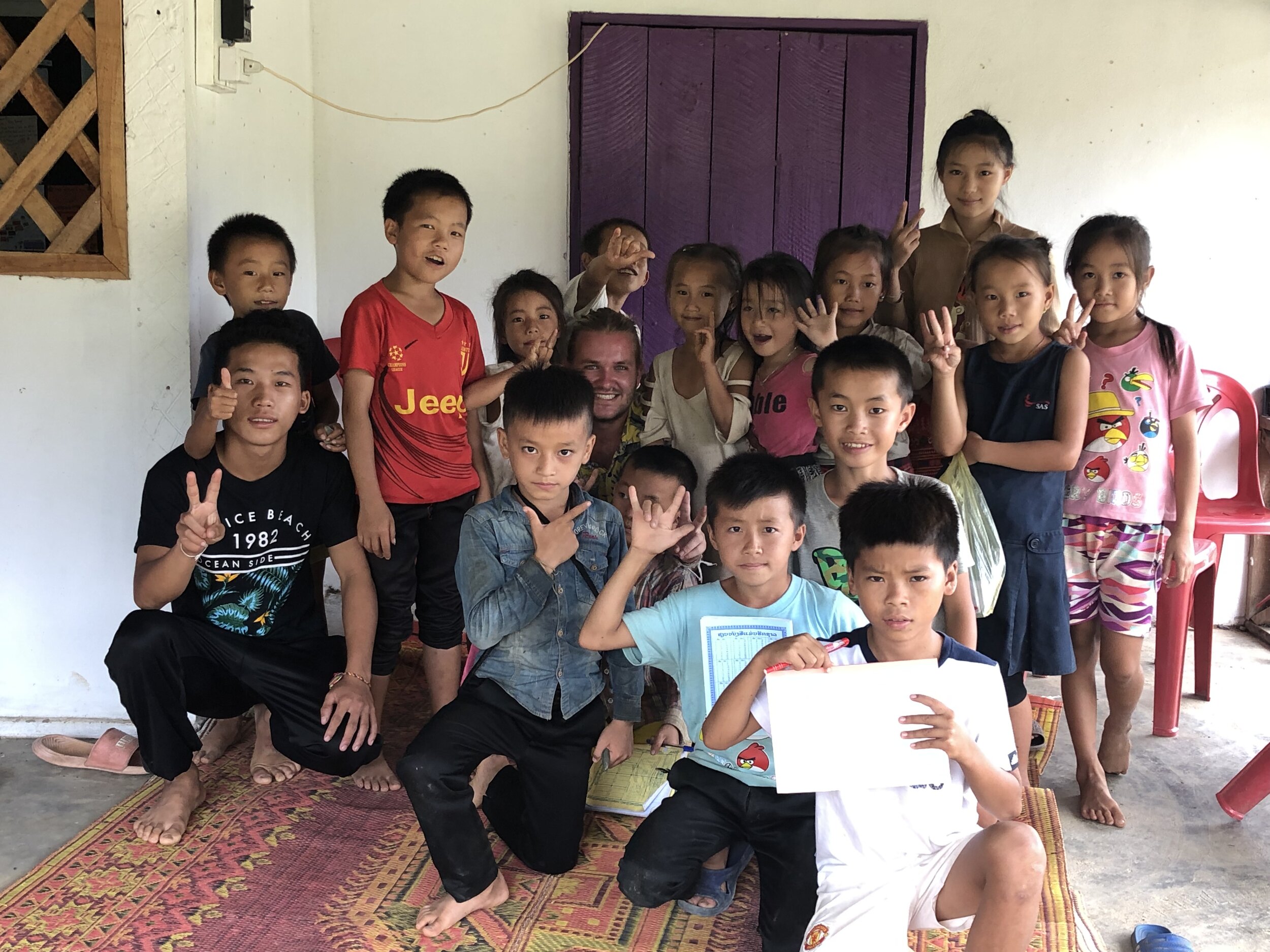

We’ve also brought on a full time English teacher named Tom to run the education programme and in the future we want to expand and grow to teach as many students as we possibly can!
The truly awesome thing about the students is that no-one makes them come to study on the farm. They all come out of a desire to improve and grow, this makes teaching them a delight. They arrive for class, they study intently, they go home and practice, practice, practice. They are inspirations!

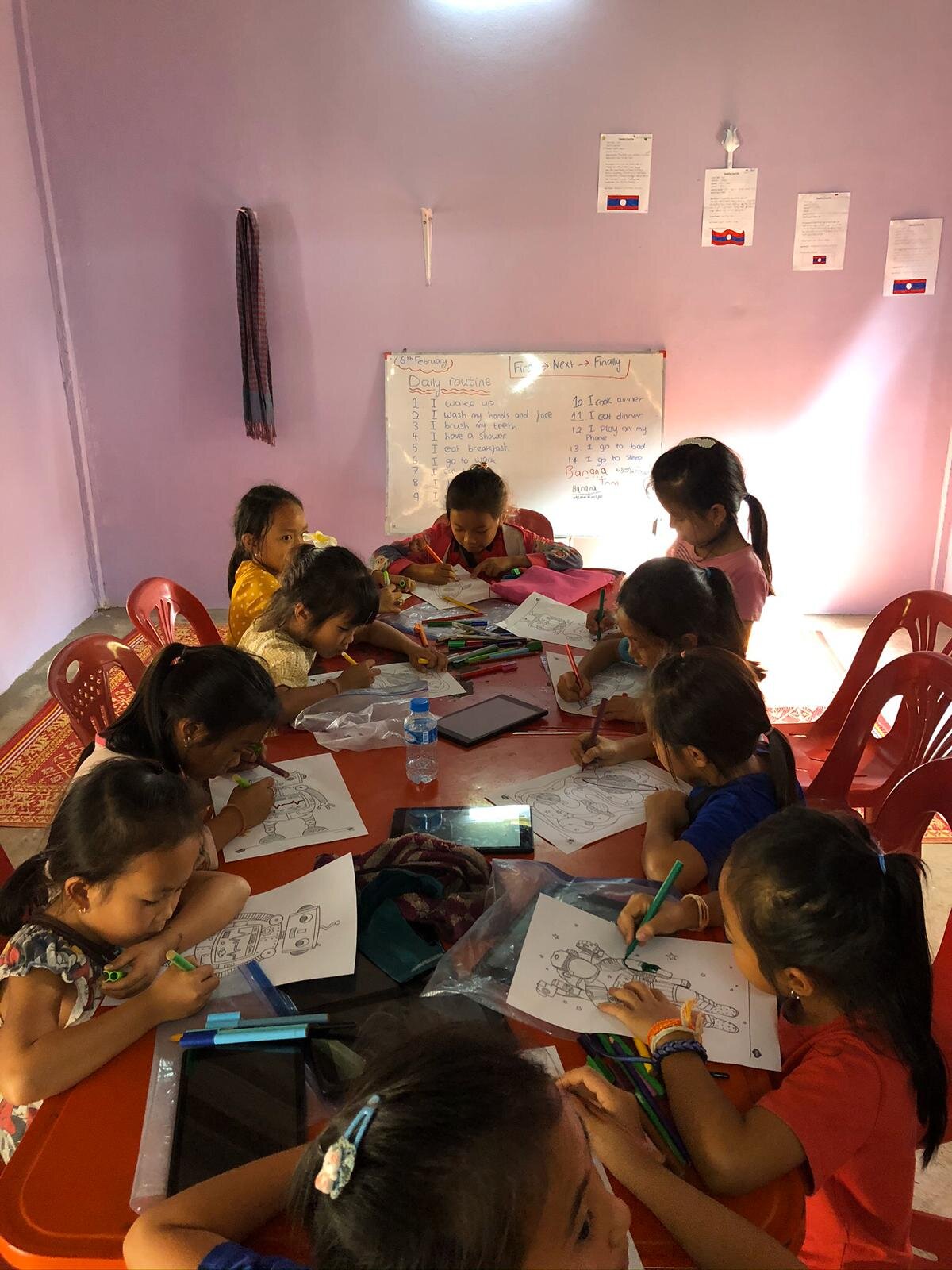
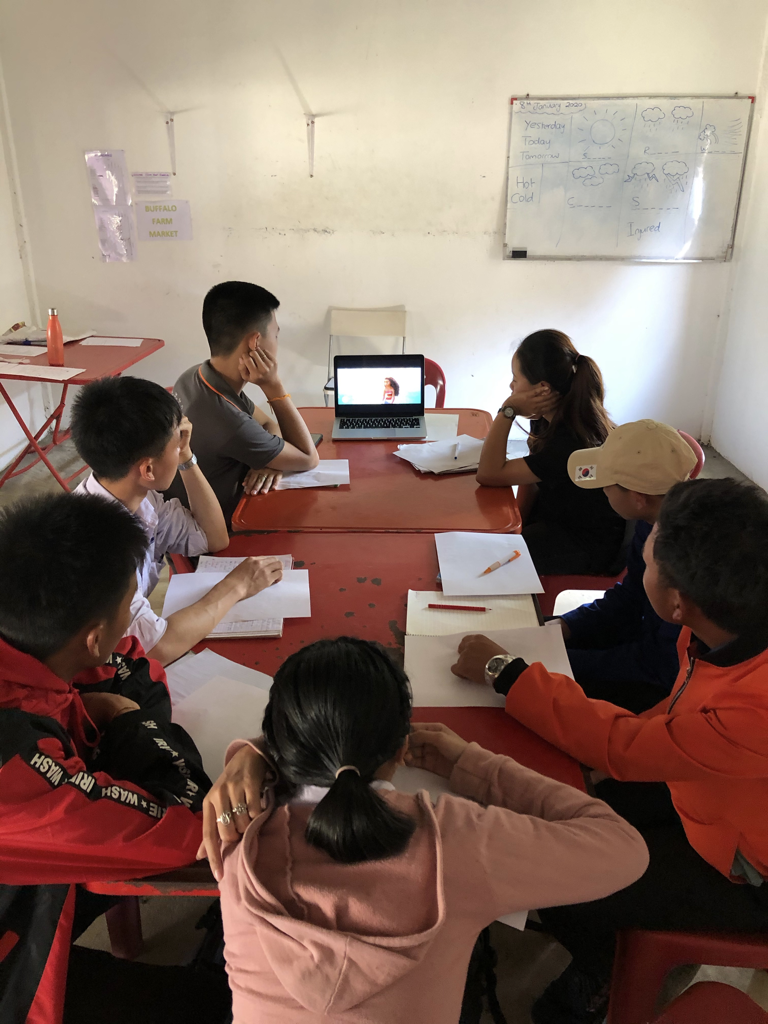
Poukham, was the very first to join our English programme for the high school students. Since he first started coming to the farm three years ago, he’s barely missed a single class. He is dedicated, hardworking and incredibly intelligent and this now manifests in a brilliant grasp of the English language. In February, we brought him on to be the monitor of our library so we could invite the primary school students back from 3:30-5:00 to practice independent study. Poukham dreams of being a dancer in Korea and if his dedication to our classes is anything to go by, he will absolutely achieve his dreams.
Did you know….?
You can still vote!
2020 Mekong Experience Showcases Finalist
In case you missed this fantastic announcement last time, we are one of the finalists in the 2020 Mekong Experience Showcases. According to the members of the Mekong Tourism Advisory Group, we fit the bill for 3 main principles:
To make a significant social impact in our community.
To provide an authentic local experience for tourism.
To have an innovative and sustainable concept in our business model.
We are so excited to have been singled out as one of the responsible small businesses to do this. But, it isn't over quite yet! There is still another round of voting to go through.
From 7 July to 15 August we are asking that you please go to http://www.destinationmekong.com/ems2020/ and vote for us. The winner will be announced on 25 August 2020.
Tourism in Need
COVID-19 has badly affected tourism and visits to the farm. In order to mitigate some of the effects of the loss of income this has meant for the dairy, we have teamed up with the Tourism in Need initiative that supports responsible tourism organizations affected by the pandemic. Through this initiative, travellers can support the dairy through the Give Today, Go Tomorrow fundraising scheme. Click here to find out more and to make a contribution to help us to pay farmers and staff, and continue to train farmers and work on our nutrition program.
Buffalo milk and it's creamy goodness
Why Buffalo Milk?
One of the questions we are asked the most at the farm is what is the difference between buffalo milk and cow’s milk. Well, we think it’s about time we gave you the definitive answer and explained the benefits of adding buffalo milk to your diet. Buffalo are the second largest (after cows) source of milk in the world.
In Southeast Asia, an estimated 90% of people are lactose intolerant. There is an absence of dairy in the diet of most of the population. When the founders of our farm arrived in Laos, on a mission to create a brand new industry, they saw thousands of buffalo and inquired about purchasing milk to make cheese. This inquiry was met with udder confusion because, in Laos, they do not milk their buffalo. Buffalo here traditionally have two main roles - to work on the farm or as meat for sale. Ask Lao people where milk comes from, and a buffalo doesn’t even rank in the top five answers! The number one answer is coconuts.
Some parts of Asia have harnessed this dairy resource with India and Pakistan accounting for 80% of all buffalo milk production globally. China, Egypt and Nepal have more buffalo dairies than cow dairies, while Sri Lanka has some of the most famous buffalo yoghurt in the world.
The buffalo yoghurt from Sri Lanka, or buffalo curd as the called it, is what attracted the founders to this idea in Laos. Having tasted the rich, creamy goodness while holidaying in Sri Lanka, it was never far from their thoughts on how to get more.
Buffalo milk vs cow’s milk
Buffalo milk has 50% more protein than cows milk, 40% more energy in calories, nearly 40% more calcium and has high levels of antioxidants. Buffalo milk has a higher fat content which makes it perfect for making cheese and ice cream. It is world-renowned for being delicious!
Our farm prides itself on having the most delicious cheese in Laos which is available in many of the hotels and restaurants in Luang Prabang and Vientiane. If you want to try our cheese fresh from the dairy, you can come and try mozzarella, feta, ricotta, blue cheese, burrata as well as ice creams, cakes and yoghurts! Yum.
2020 Mekong Experience Showcases Finalist
In case you missed this fantastic announcement last time, we are one of the finalists in the 2020 Mekong Experience Showcases. According to the members of the Mekong Tourism Advisory Group, we fit the bill for 3 main principles:
To make a significant social impact in our community.
To provide an authentic local experience for tourism.
To have an innovative and sustainable concept in our business model.
We are so excited to have been singled out as one of the responsible small businesses to do this. But, it isn't over quite yet! There is still another round of voting to go through.
From 7 July to 15 August we are asking that you please go to http://www.destinationmekong.com/ems2020/ and vote for us. The winner will be announced on 25 August 2020.
Tourism in Need
COVID-19 has badly affected tourism and visits to the farm. In order to mitigate some of the effects of the loss of income this has meant for the dairy, we have teamed up with the Tourism in Need initiative that supports responsible tourism organizations affected by the pandemic. Through this initiative, travellers can support the dairy through the Give Today, Go Tomorrow fundraising scheme. Click here to find out more and to make a contribution to help us to pay farmers and staff, and continue to train farmers and work on our nutrition program.
Pumping from the Mekong
As we head into rainy season, we decided to reflect back on the dry season this year and rainy season last year. Rainy season normally runs from May until October but unfortunately last year we saw a very dry rainy season. This has had huge ramifications for our farm and the rest of the community who are often so reliant on rice farming.
The villages usually do 2 rice harvests per year. But this last year saw so little rain that most villages were lucky to get just one harvest. This lack of growing and harvesting has created a rice shortage which means that more rice has had to be imported from Thailand, increasing the prices.
On our farm we have about 100 buffalo staying with us at the moment. They are quite greedy house guests as one buffalo can eat 30 kilos of food every single day (or about 10% of its body weight)! This means we need to provide a lot of grass for all of the buffalo which becomes more challenging when the water supplies are unreliable and depleted.
Now we come to the heroes of our story.

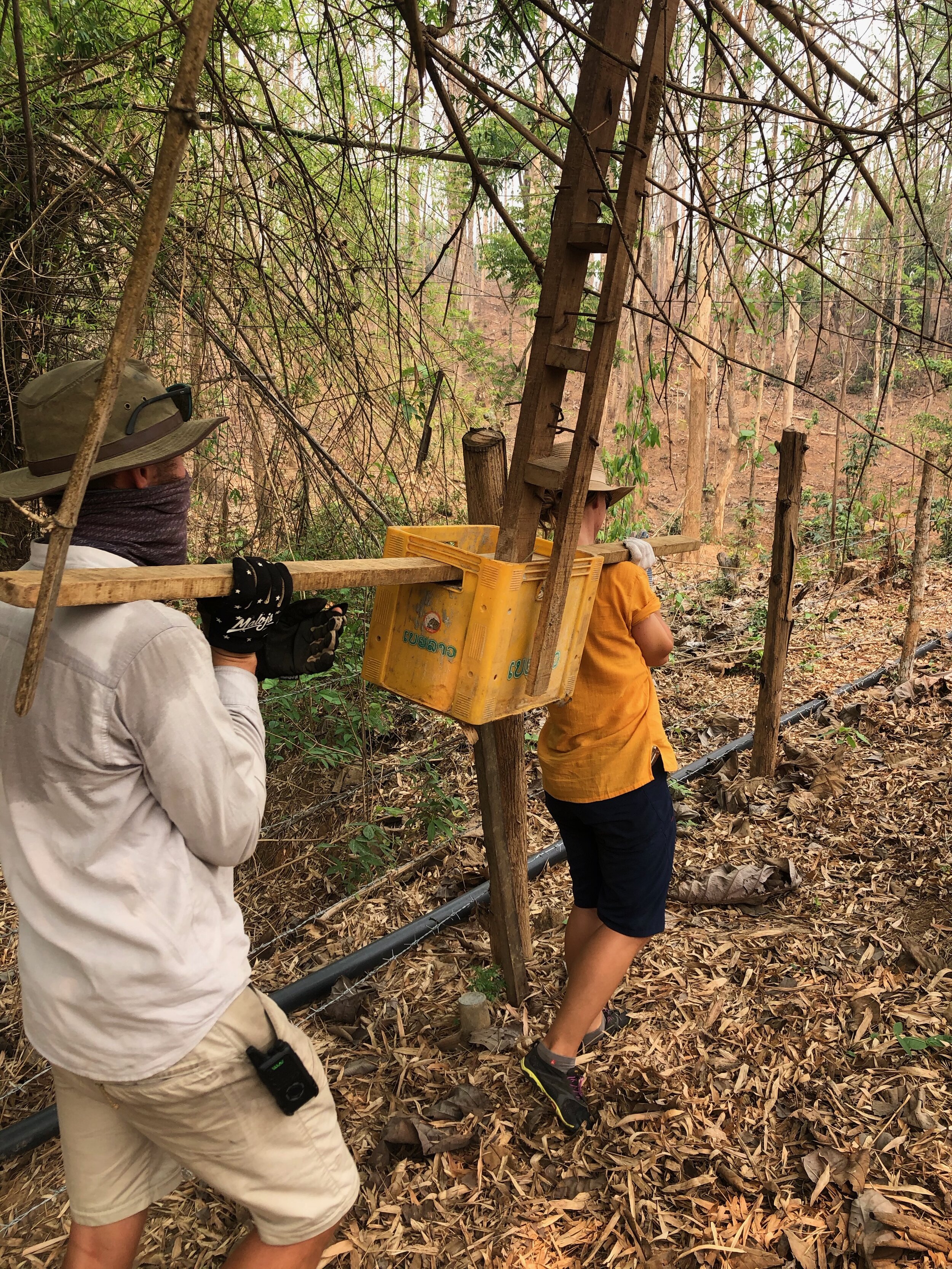
One of our co-founders, Steven, along with two incredibly hard working German volunteers, Tim and Frauke, and some of our farm staff carried the 50 kilo pump 200 metres down to the mighty Mekong river. This was back breaking work and they faced many setbacks along the way.
We had to have electricity run across the main road at the farm, all the way down to the water line in order to use said pump. That was no easy feat as it had to be run through the woods after being hooked up to our transformer, across the road. We needed the electricity company to come out to do this for us, after hiring day workers to help Tim dig holes for the poles so we could make sure the line went exactly where we needed it.
Steven unwittingly donated blood during this enterprise, which ended up in 3 stitches with no anesthetic. We feel your pain Steven! Due to ingenious engineering and dedication there was celebration on our farm as the much needed water began to flow down the 350 metre long pipe and onto our farm into the pond at the cafe! From there it was diverted with more pipes and smaller pumps to lead out either directly onto the fields of grass or into other ponds to be used further away from the Mekong. Well done guys!
We wish this was the least of our problems now!
Women's Empowerment
As a socially responsible, sustainable business we are proud of the opportunities that we create in the local communities.
60% of the staff who work on our farm are female! Yep, from our CEO and Head Chef through all the roles covered by staff on the farm and in the kitchen we are a predominantly female enterprise.”
And of course, the dairy itself was set up to create families with a regular income stream from an underutilised resource, namely female buffalo; male buffalo being sold for meat. The facility for milking buffalo and keeping them well-fed, healthy and safe and the cheese-making production facility to process the milk provide employment opportunities for our staff.
We also provide Internships in the production facility for local women in order to help them acquire skills and work experience and to give them access to the tourism job market.
The women who work on our farm know that they will always be supported because strong women are represented in senior management. They have gone out of their way to lift up and promote women to work on the farm. Women working on our farm are given an opportunity to earn money and make a life for themselves. Often in Laos women will marry young and they will then be expected to stay at home which may or may not match their original aspirations. On the farm the women who work here are given free accommodation, allowing them to stay safely on the farm, save some money and ultimately make their own life choices without outside pressures.
Meet some of our staff:
Saisamone is a constant smiling face on our farm. Whether she is taking tours or working with the buffalo she is always a ray of sunshine. She is incredibly smart, graduating from the Northern Agriculture and Forestry College in 2016, having studied livestock and fishery for 3 years. She can also speak fluent English! She knows everything there is to know about buffalo and if you’re lucky enough to have her take you on a tour of the farm in the future you will see first hand how knowledgeable she truly is!
With the effects of COVID-19, for a while, the tours stopped. However, with the dairy open again, Saisamone looks forward to once again welcoming visitors curious to learn about the farm and keen to taste our delicious products!
Oudone was driving past the farm one day and was intrigued. She decided to come in and apply for a job on the farm but she’s scared of buffalo, so she found her home in the kitchen. Before working on the farm she hadn’t eaten cheese before let alone made it. So with the expert guidance of our head chef, she is now brilliant at making all of the cheeses you can see on our menu. She also worked for months on our farm with her cousin without having any idea they were cousins! There was much rejoicing when Oudone’s sister came to visit and informed them both of the family connection. She works incredibly hard and is as diligent a person as you will ever meet. She also sends a large portion of her wages back to her family to support them.
Mone has worked on the farm for the past 4 years. She came to the farm at 20 years old with a daughter and a marriage that wasn’t working out. The farm offered her free accommodation and a stable income. She supports her daughter to go to school and study visiting her every day if she can while she stays with them in her village. Mone comes from a background of limited education but she’s incredibly smart and she has been given the opportunity to move through the ranks and is spoken of someone who could move into a senior position on the farm side of the dairy.
Bounmee has been working with us on the farm since the very beginning. She started with us a day worker, but it became apparent very quickly that she was dedicated to her job and we hired her full time. She has worked in the kitchen and on the buffalo side of the farm. Bounmee has an infectious laugh and is referred to by the staff as “Mum Mee” because of her caring nature. She cannot read or write so for her to work on the farm during the pandemic has been a great opportunity for her family as she can continue to work to earn money for an enterprise that actively supports women.
Tourism in Need
COVID-19 has badly affected tourism and visits to the farm. In order to mitigate some of the effects of the loss of income this has meant for the dairy, we have teamed up with the Tourism in Need initiative, that supports responsible tourism organisations affected by the pandemic. Through this initiative, travellers can support the dairy through the Give today, go tomorrow fundraising scheme. Click here to find out more and to make a contribution to help us to pay farmers and staff, and continue to train farmers and work on our nutrition program.
BREAKING NEWS!!!!
2020 Experience Mekong Showcases
We have some fantastic news that we are just bursting at the seams to get out to you!
On Monday night we found out that we are one of the finalists in the 2020 Mekong Experience Showcases. According to the members of the Mekong Tourism Advisory Group, we fit the bill for the 3 main principles:
1. To make a significant social impact in our community.
2. To provide an authentic local experience for tourism.
3. To have an innovative and sustainable concept in our business model.
We are so excited to have been singled out as one of the responsible small businesses to do this. But it isn't over quite yet! There is still another round of voting to go through.
From 7 July to 15 August we are asking that you please go to www.destinationmekong.com/ems2020/ and vote for us.
The winner will be announced on 25 August.


